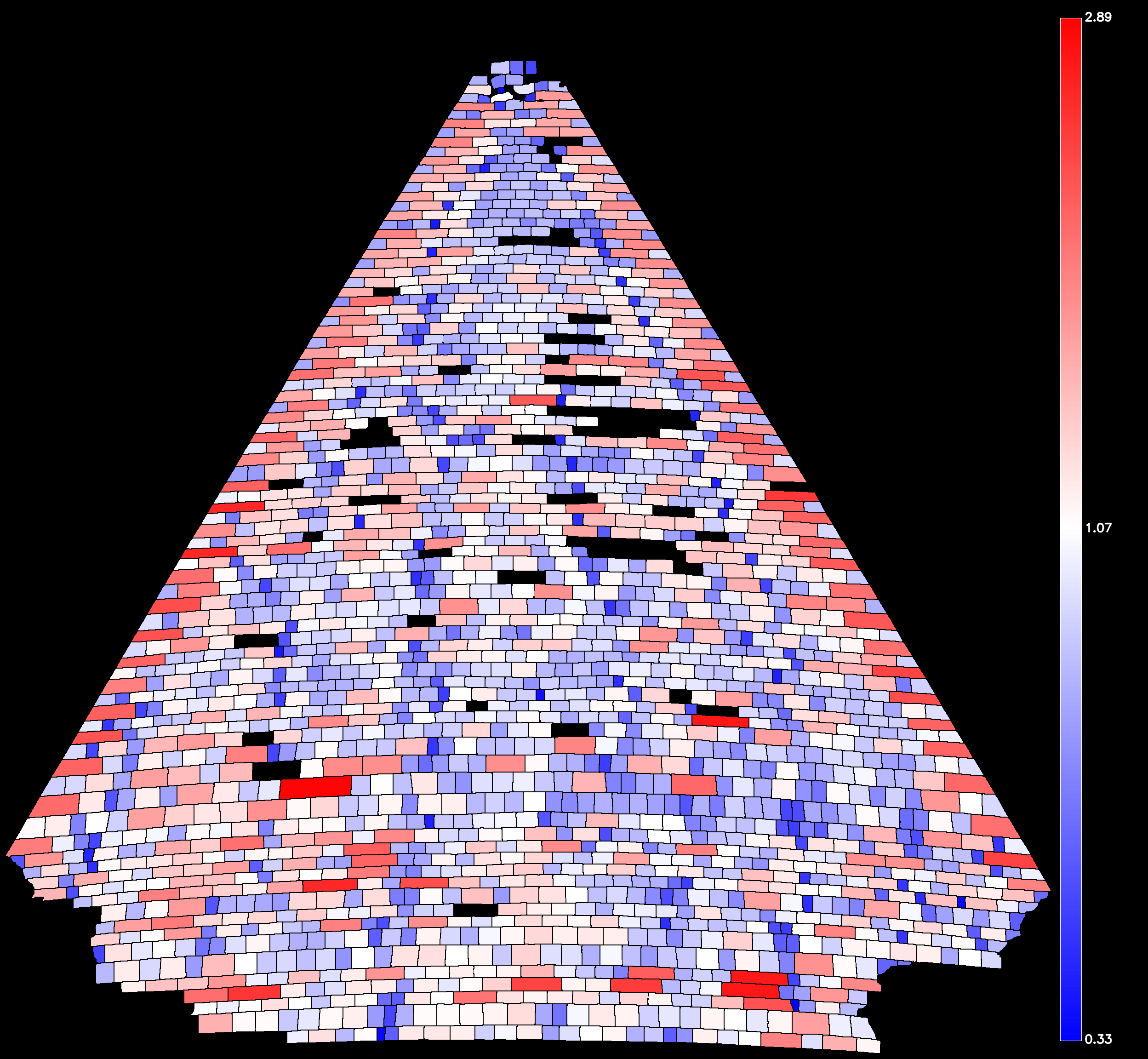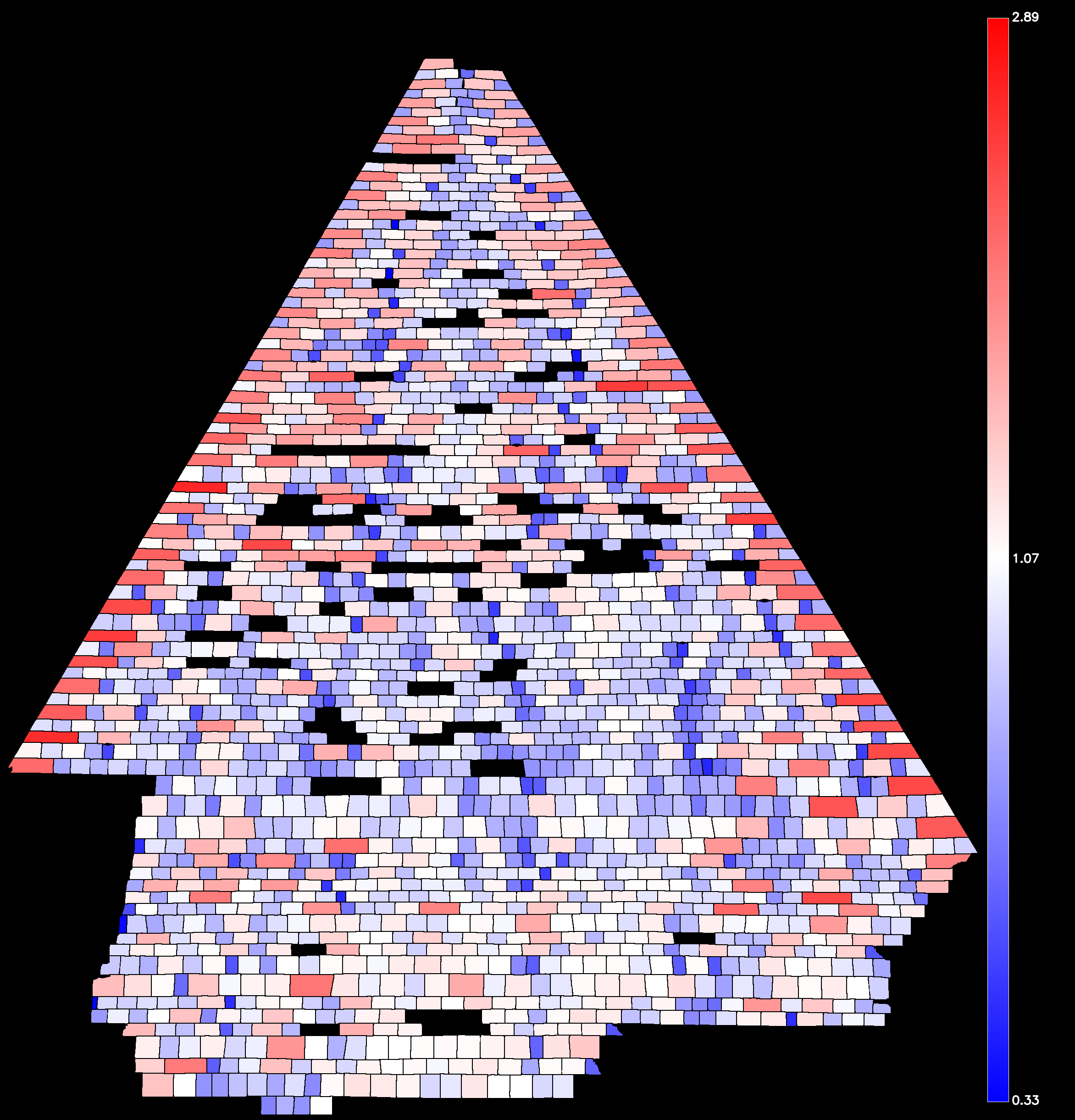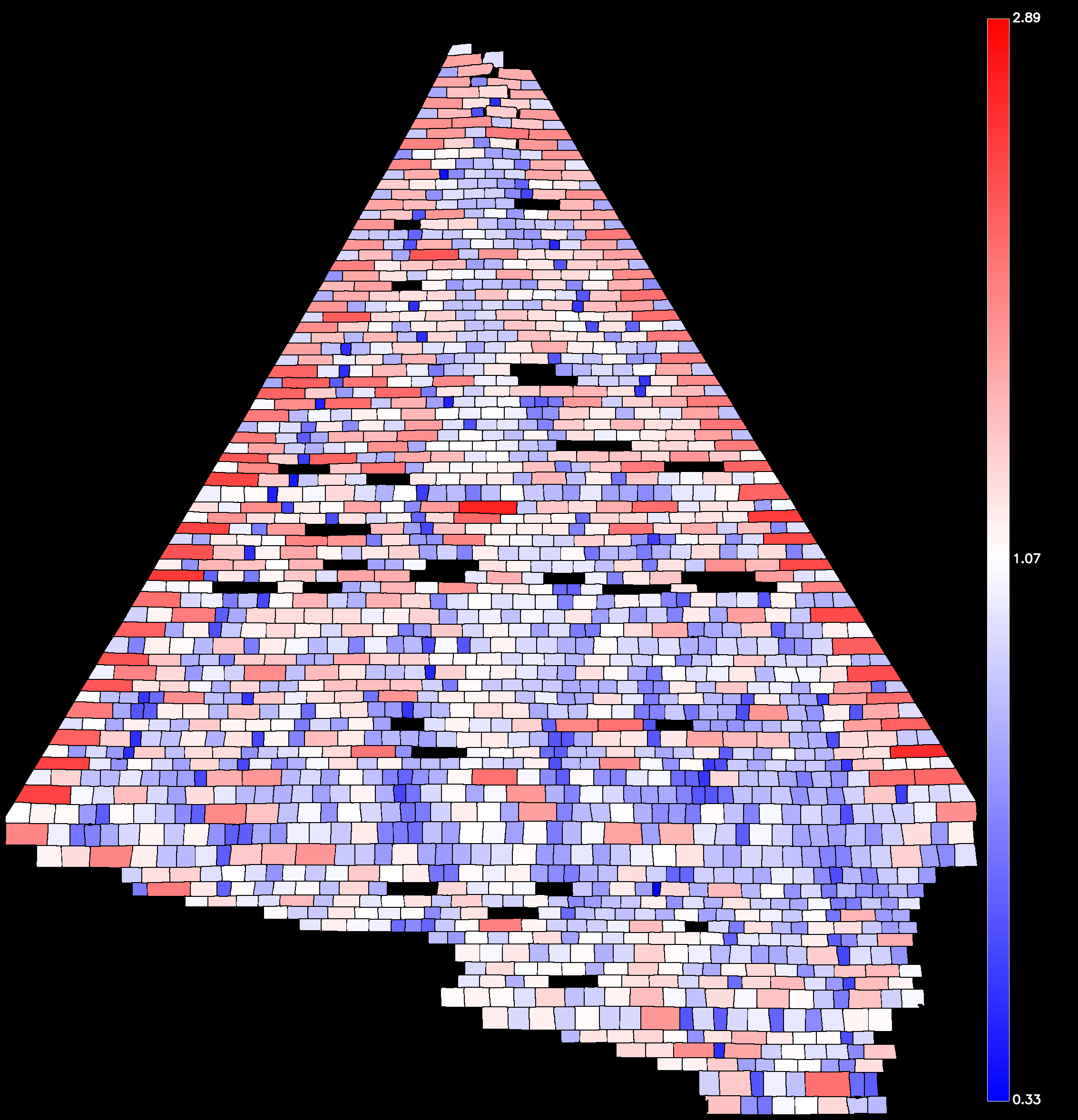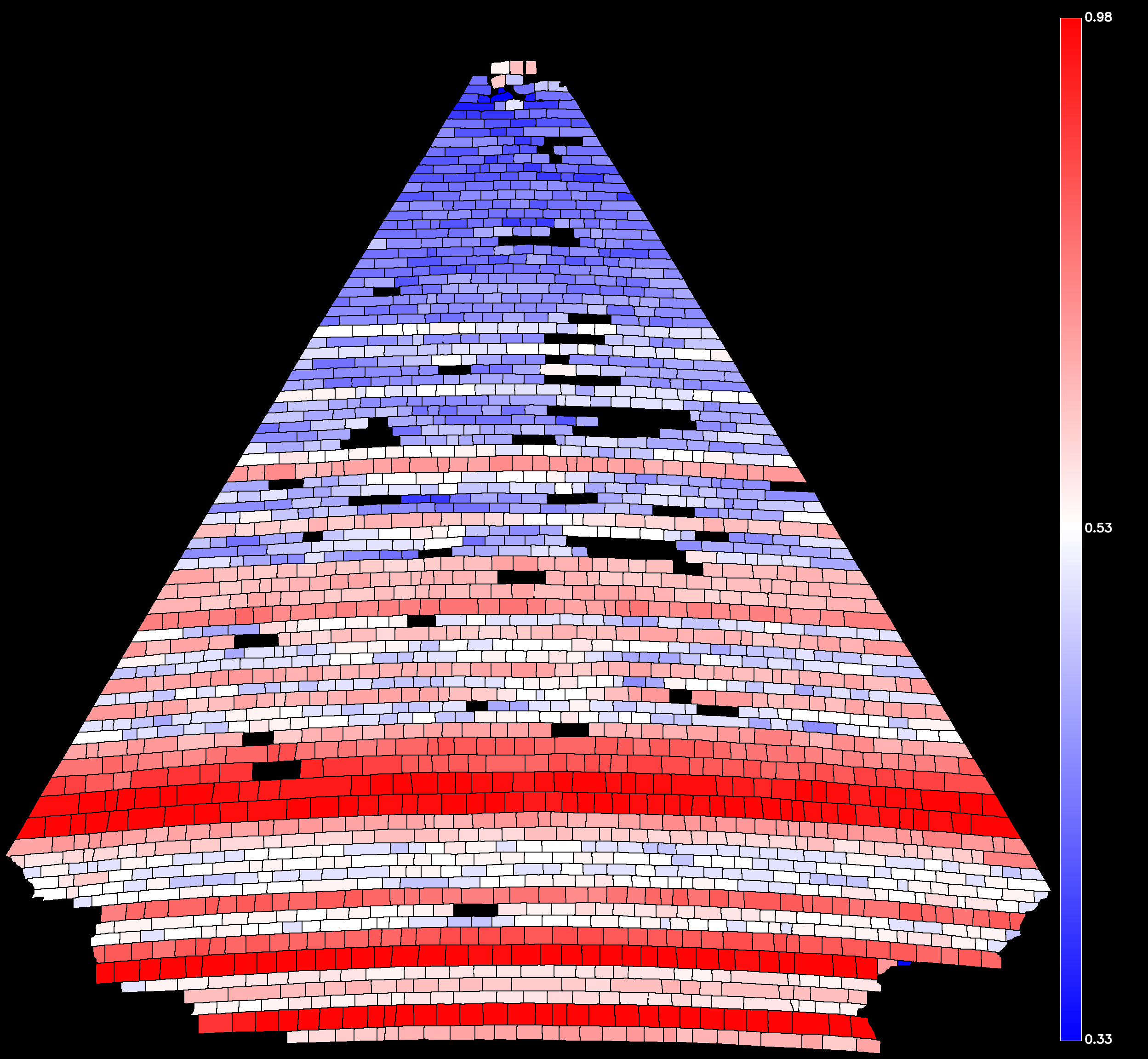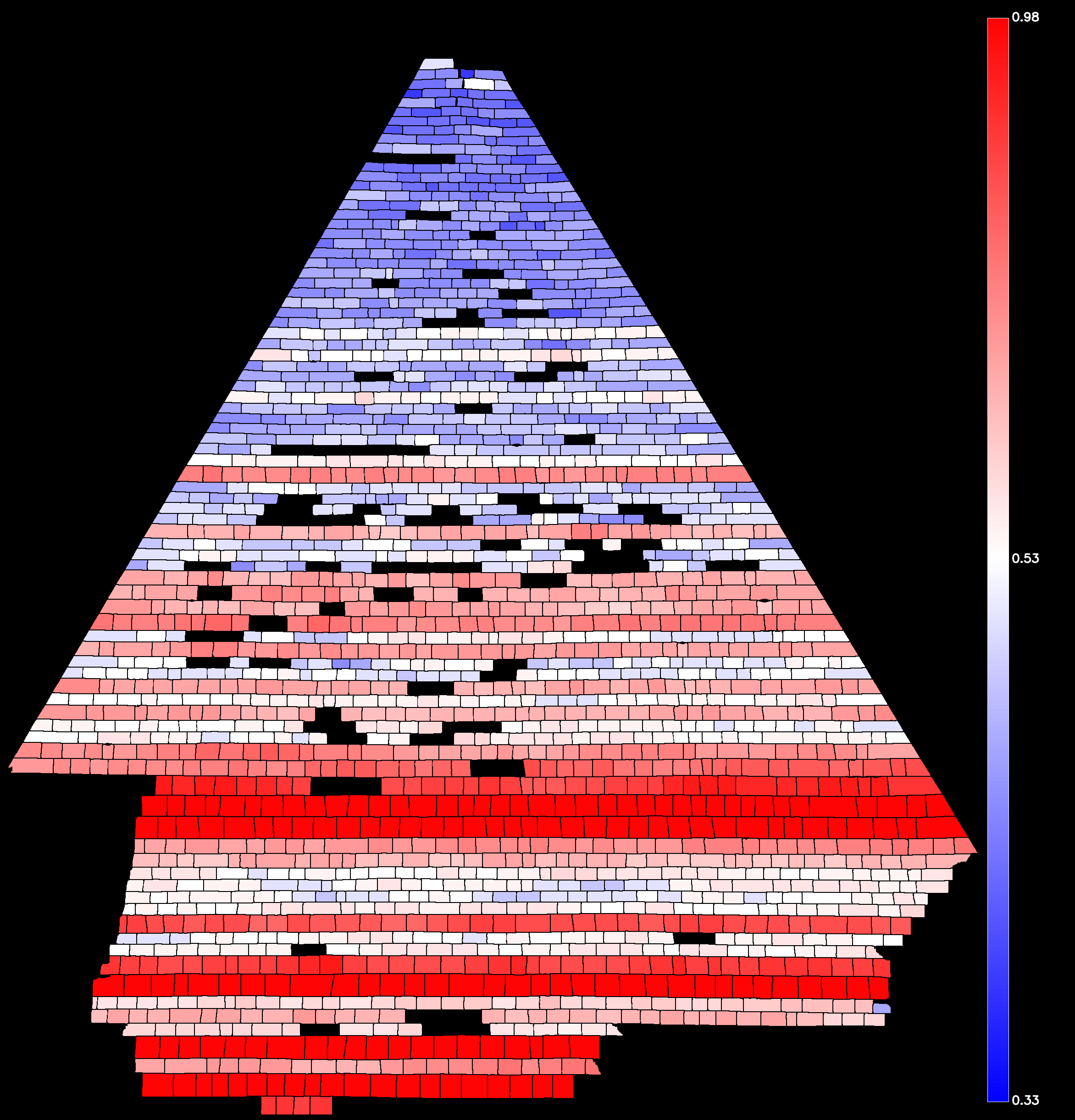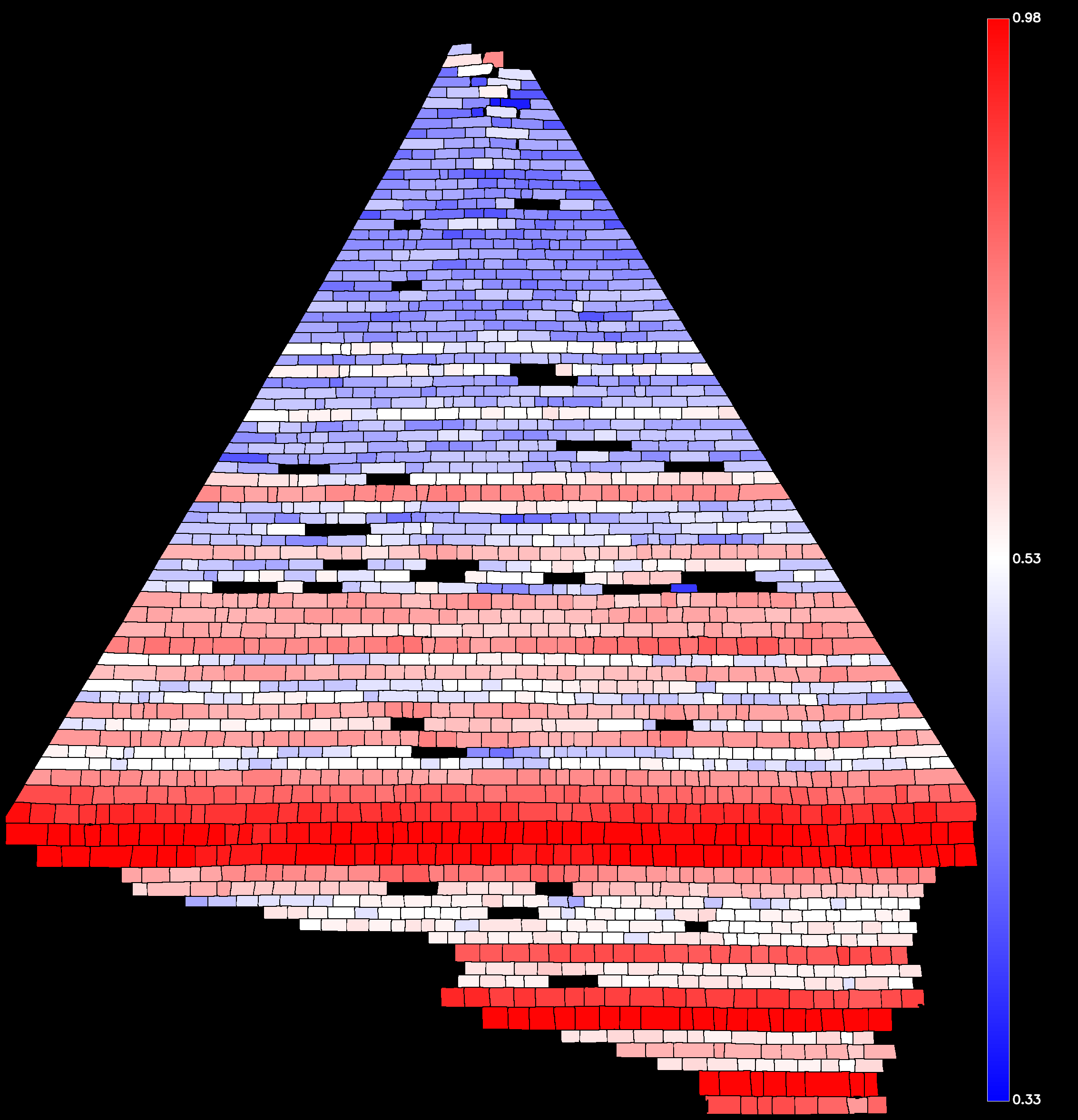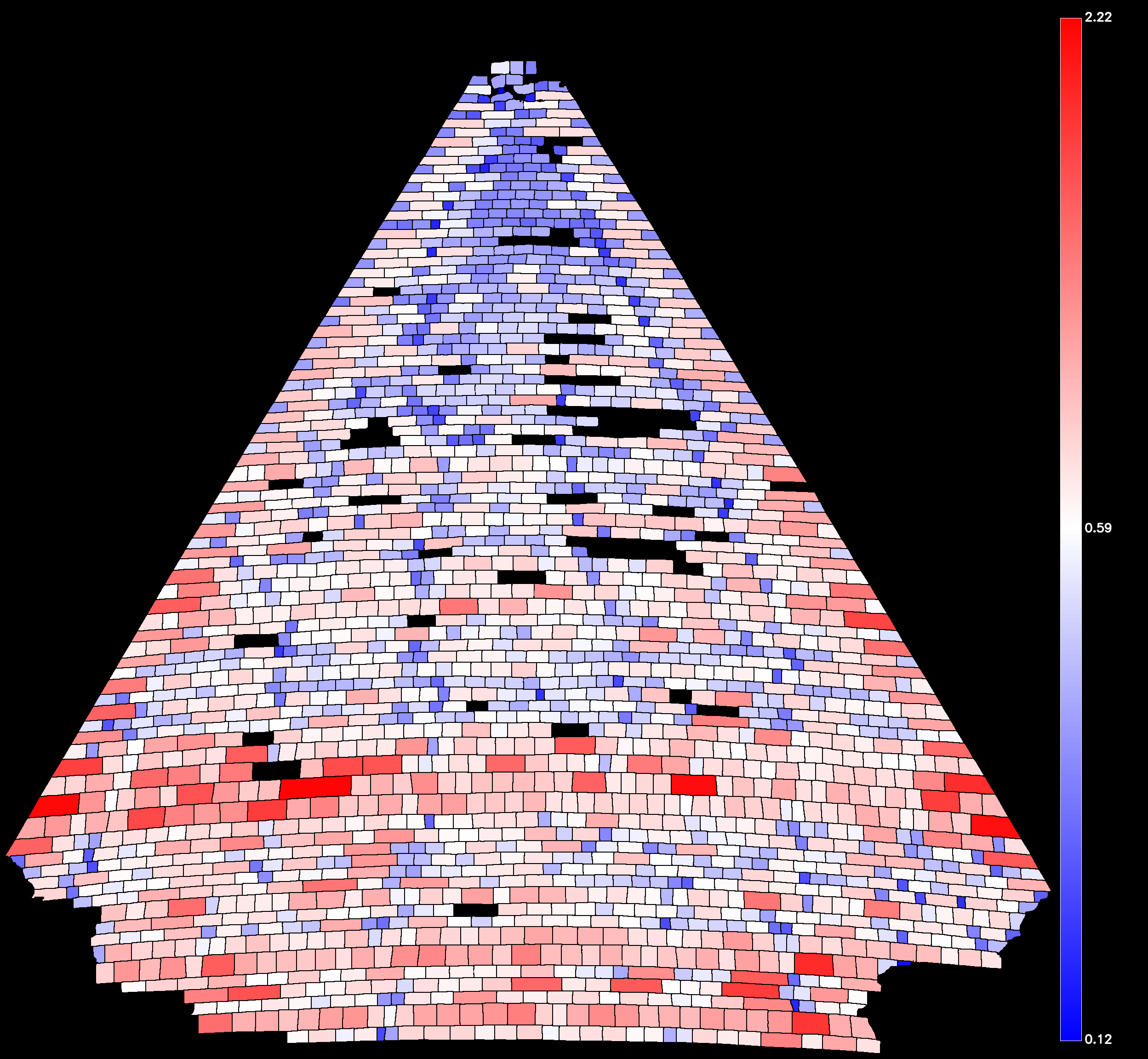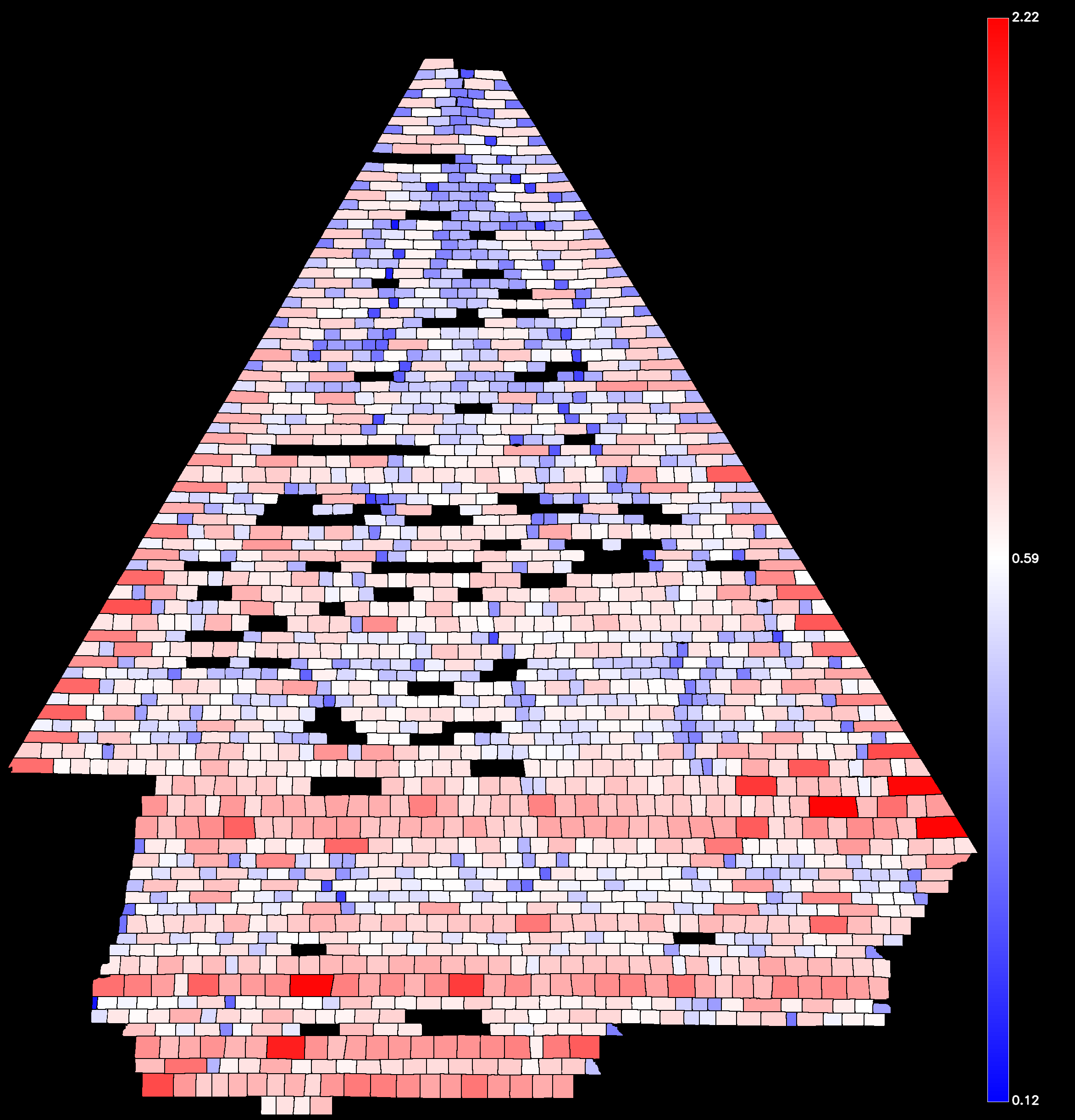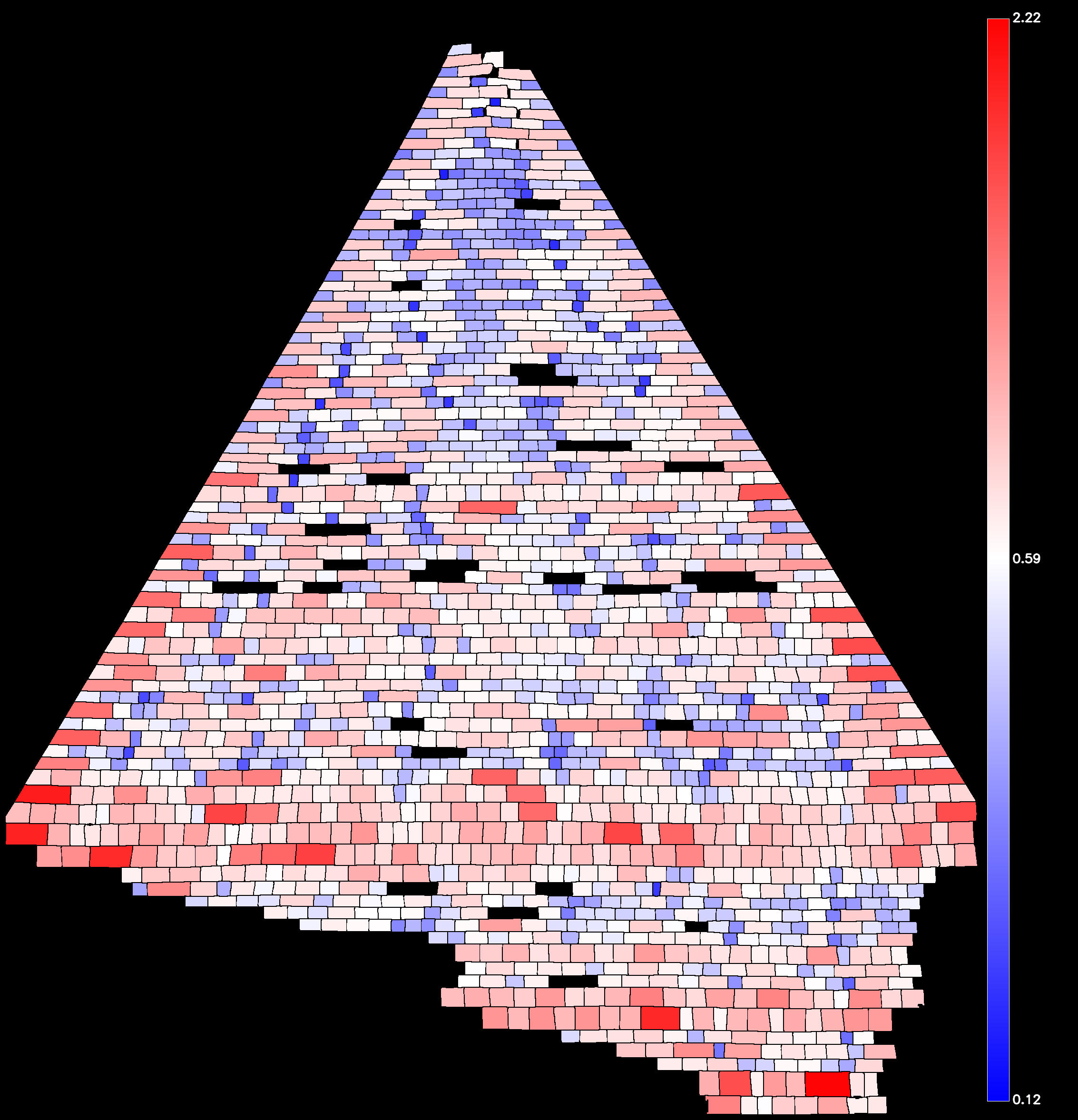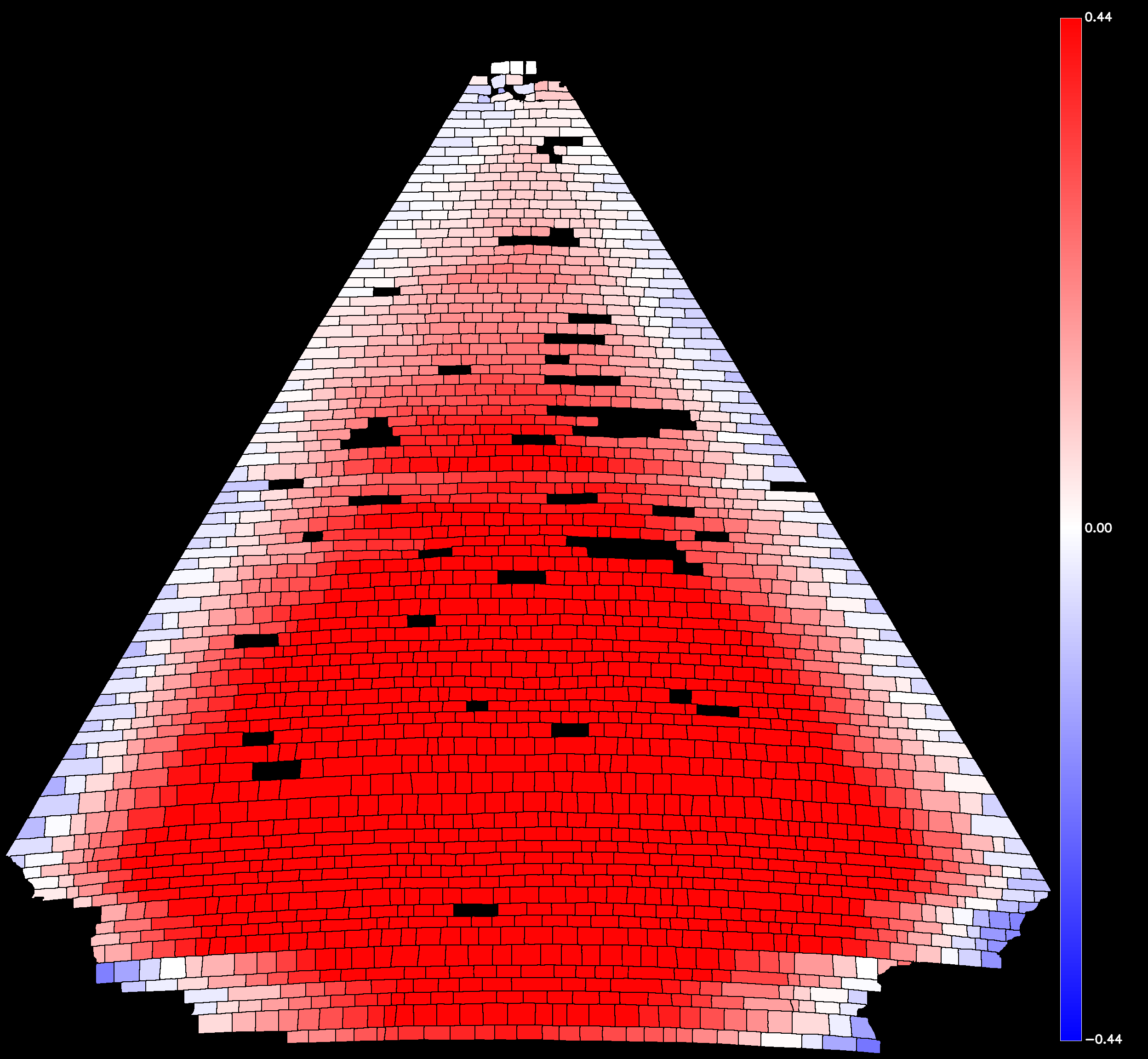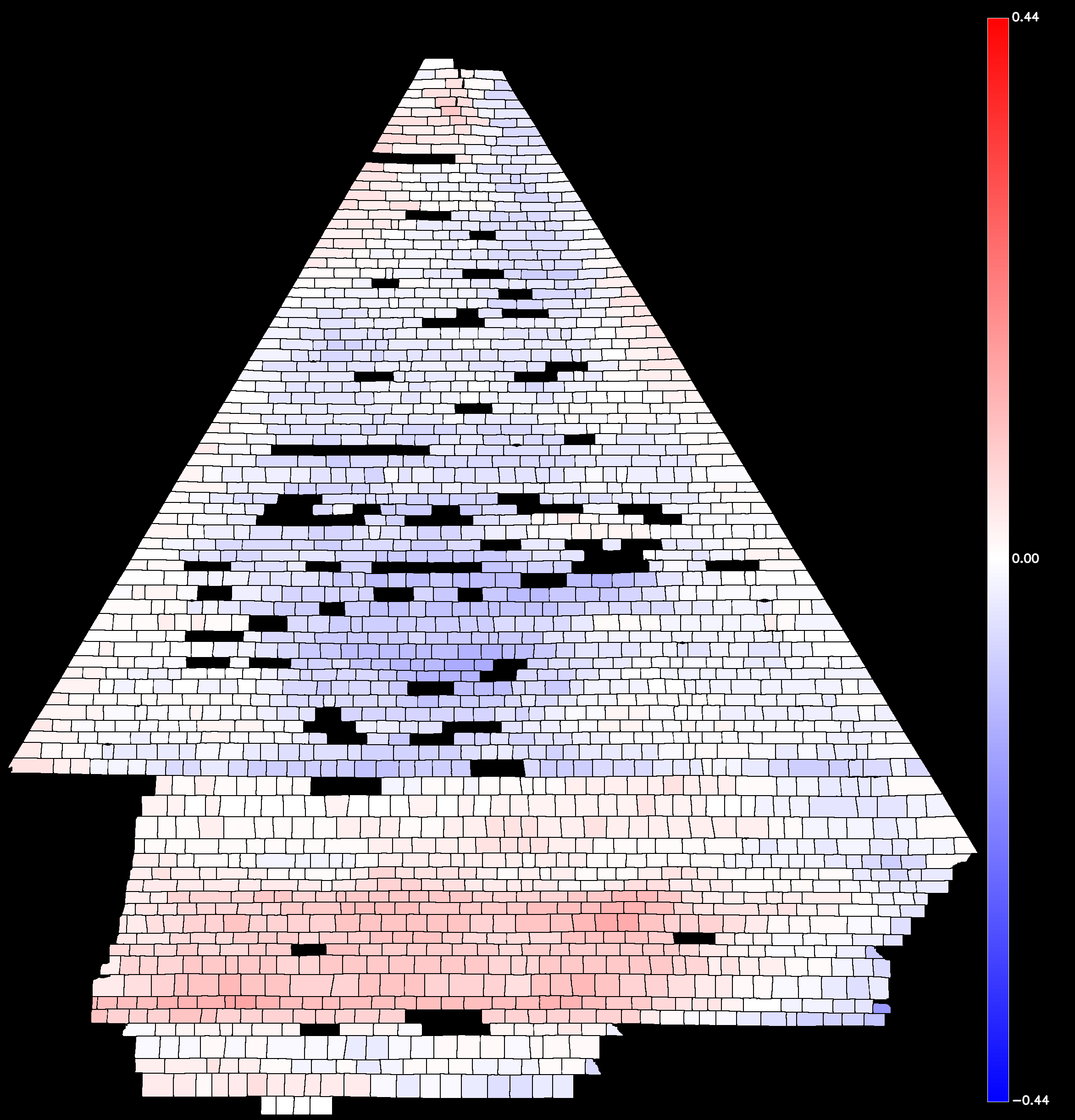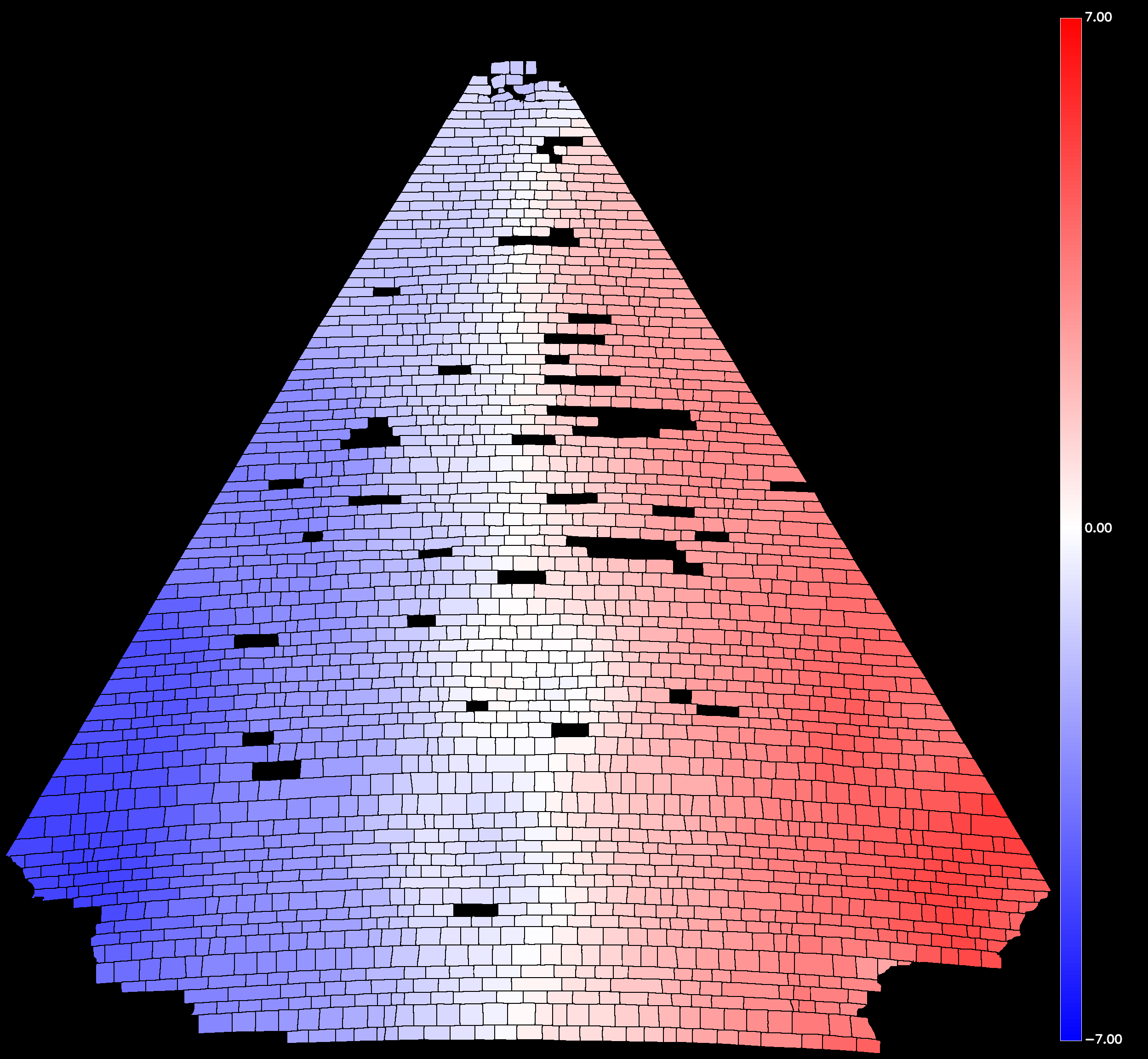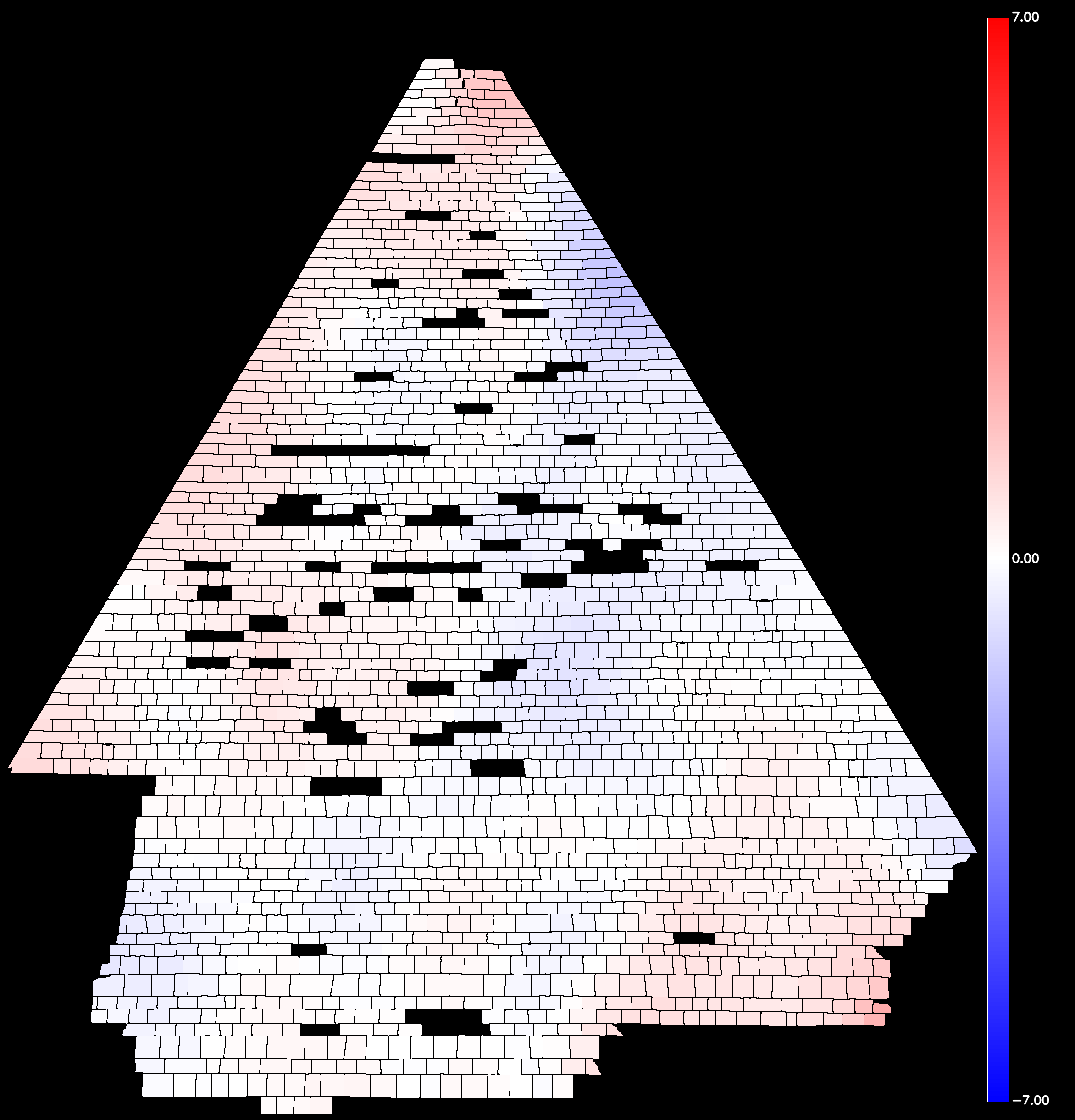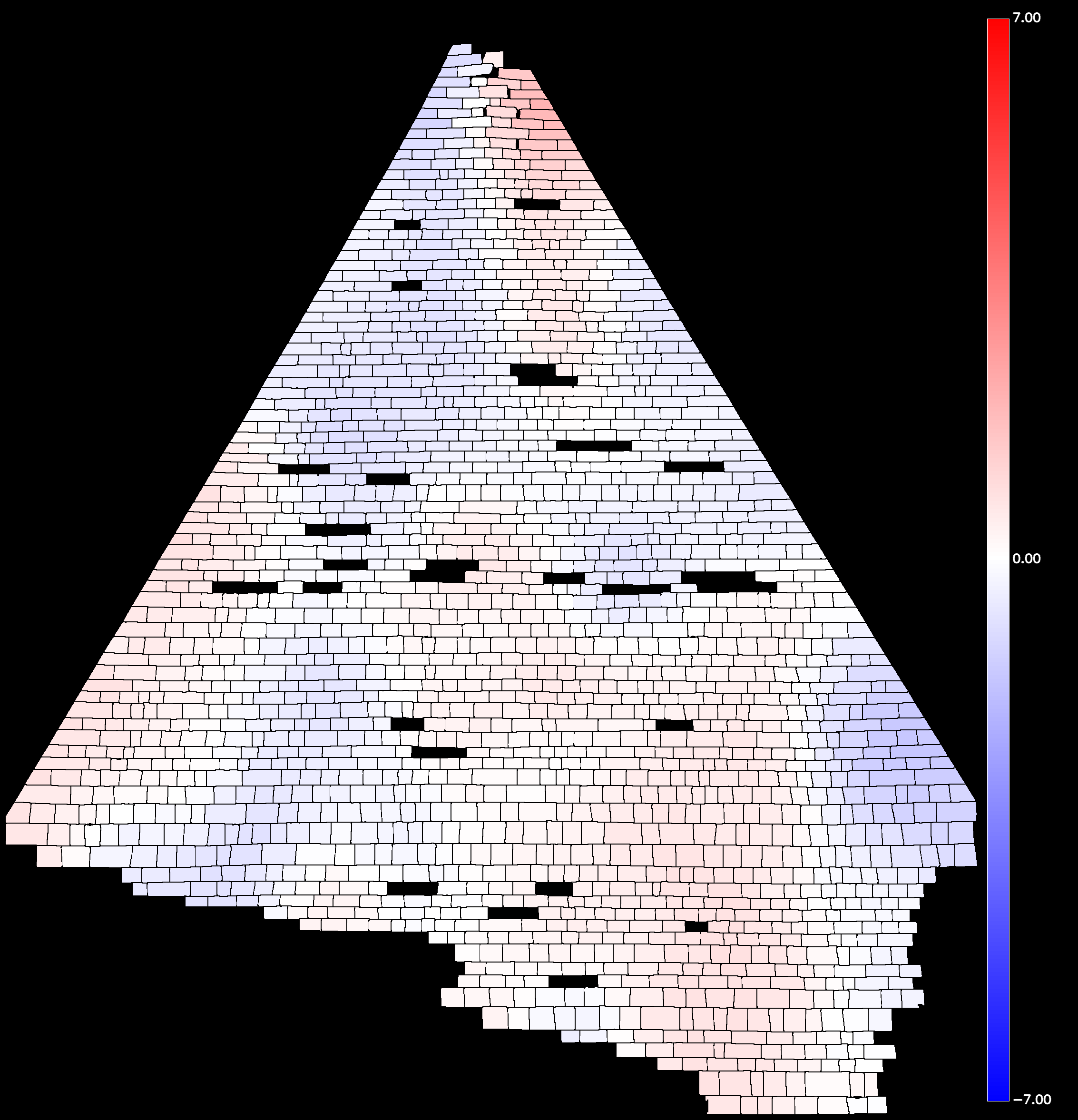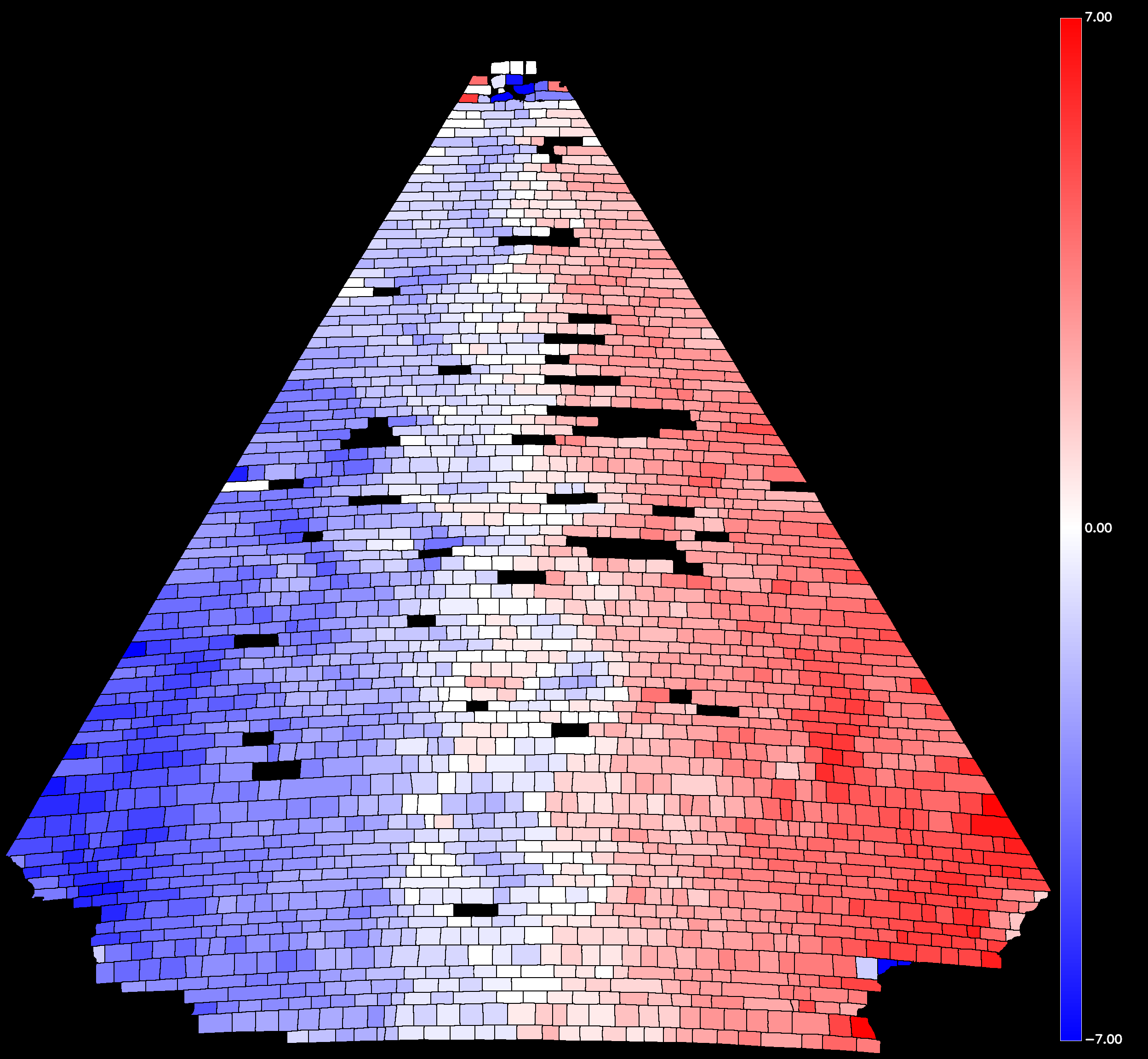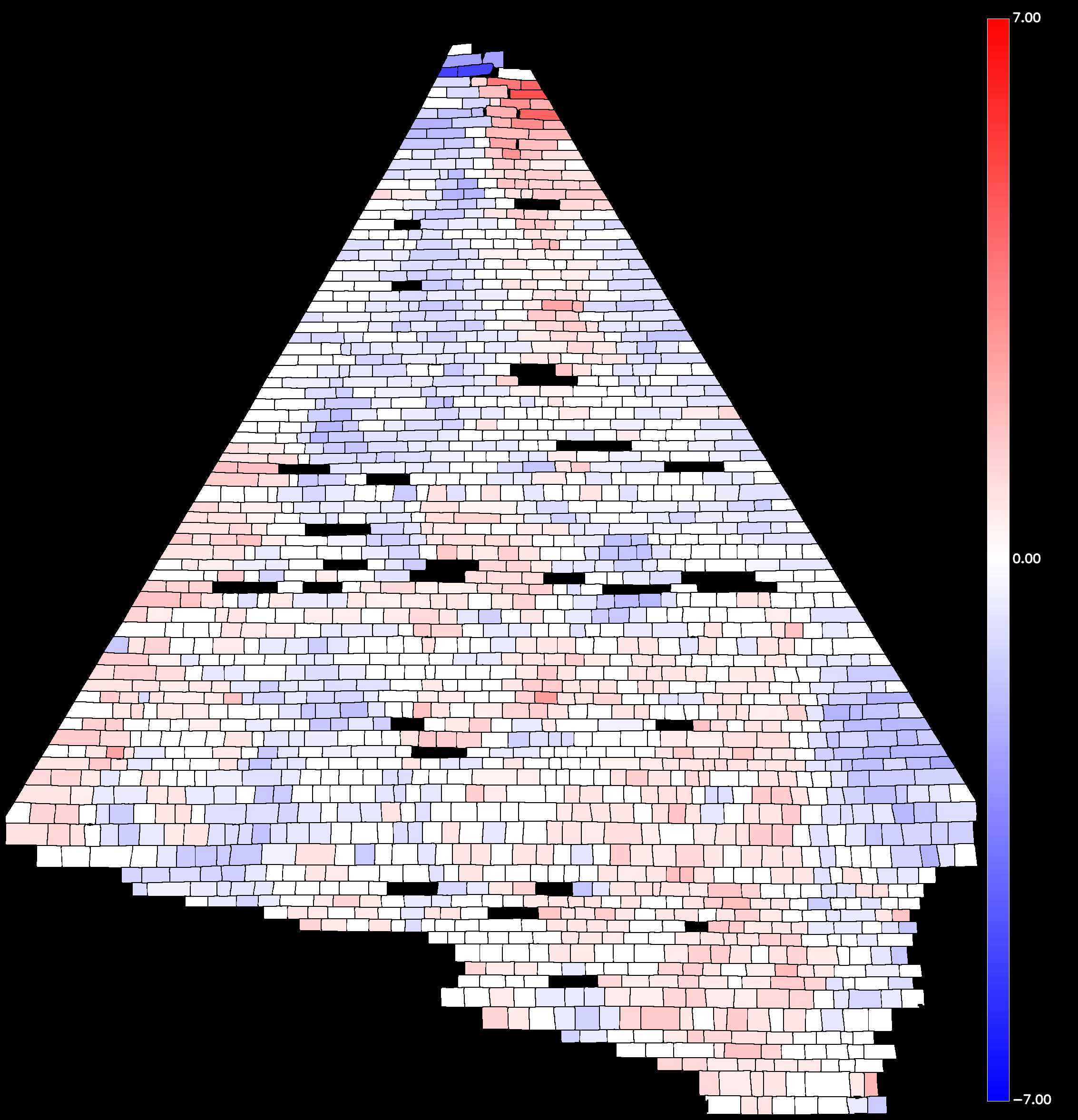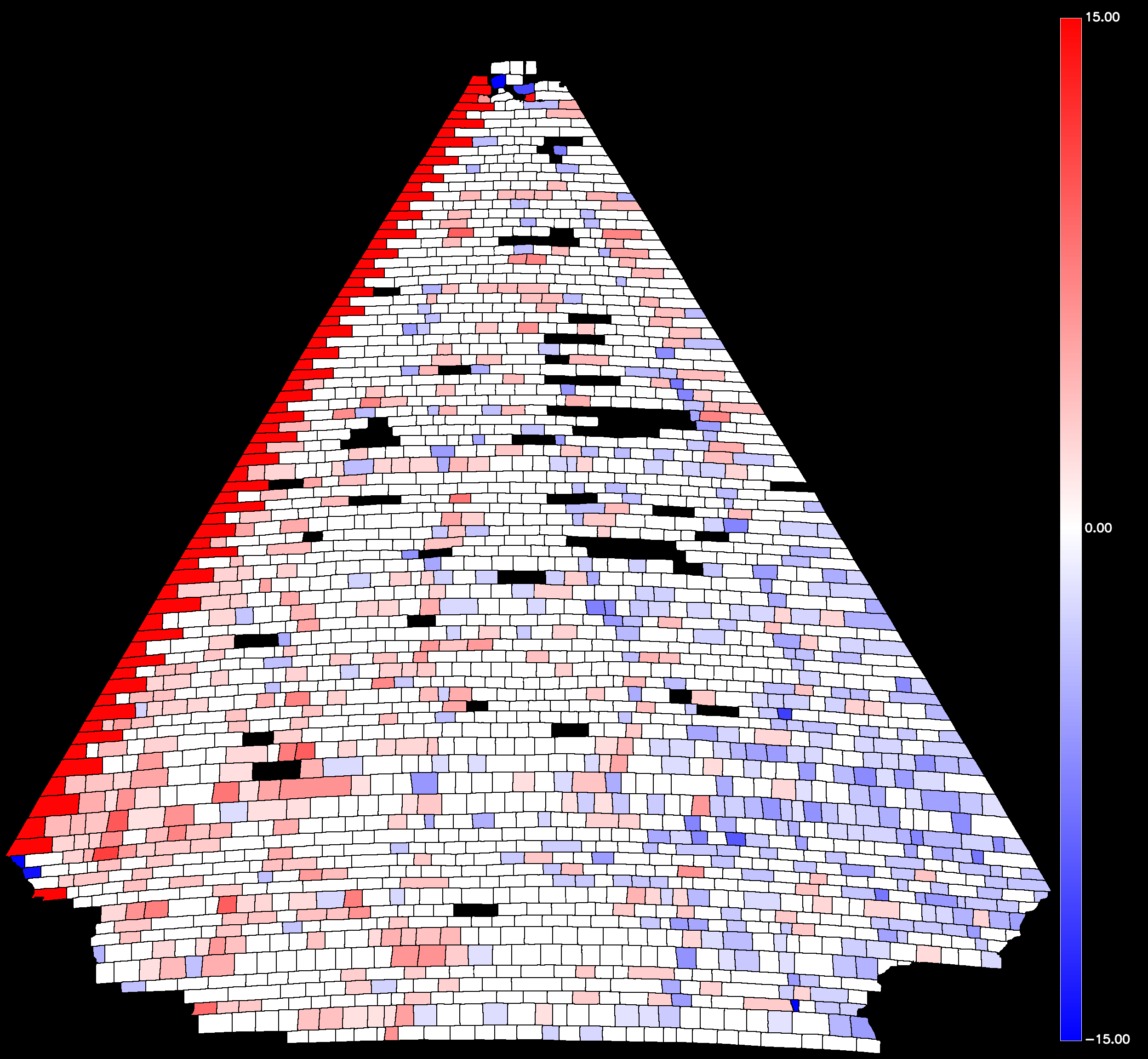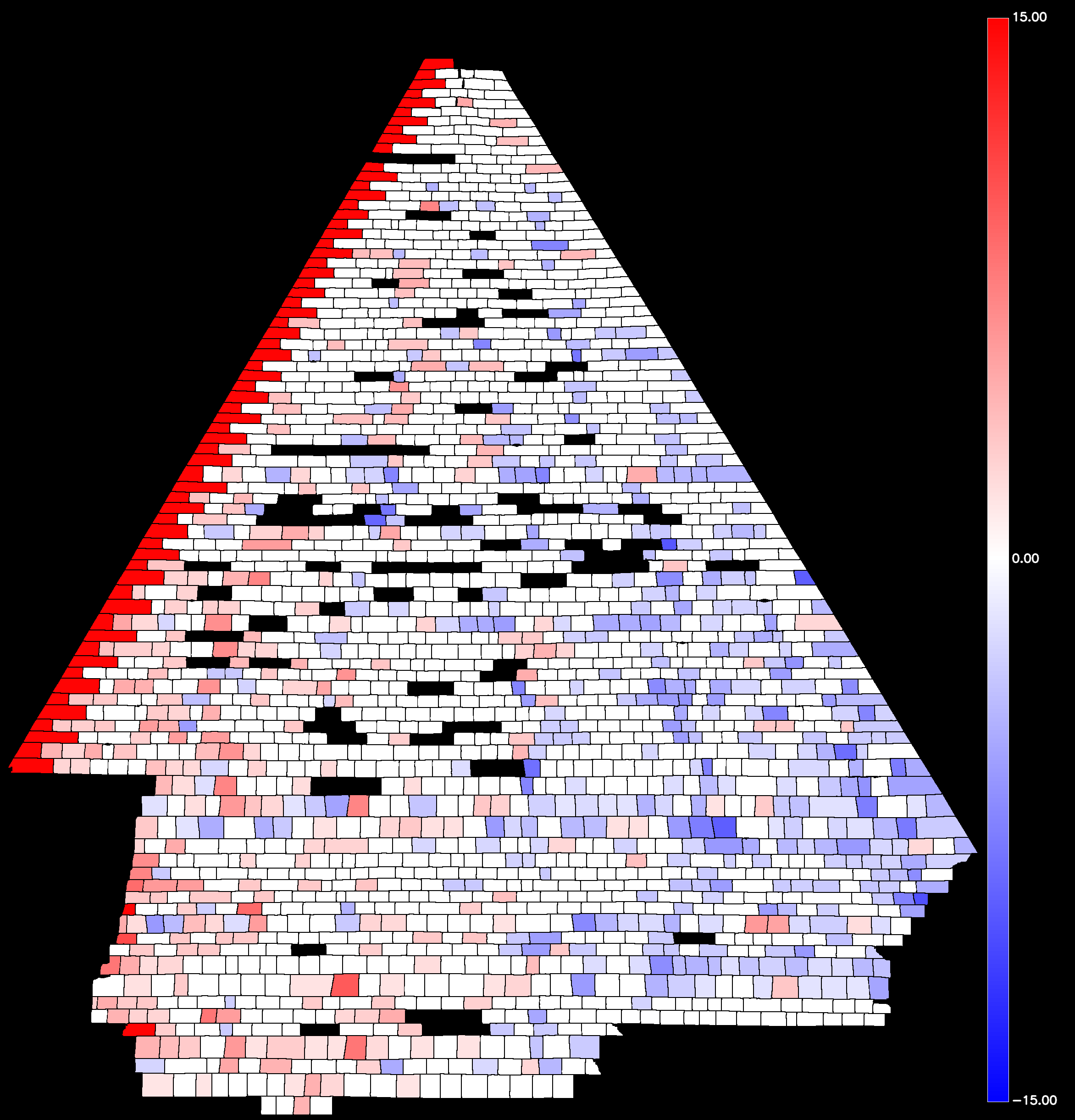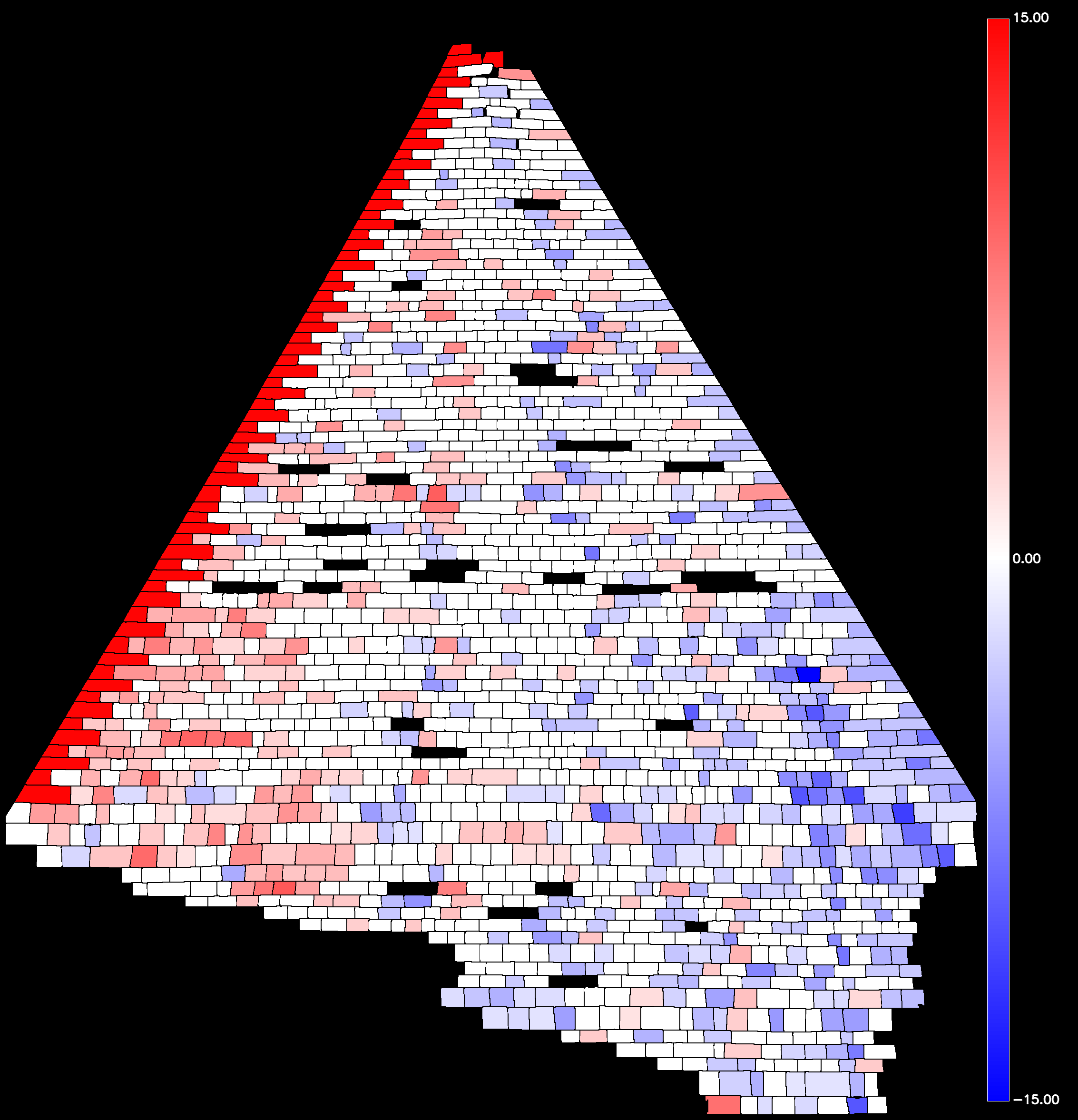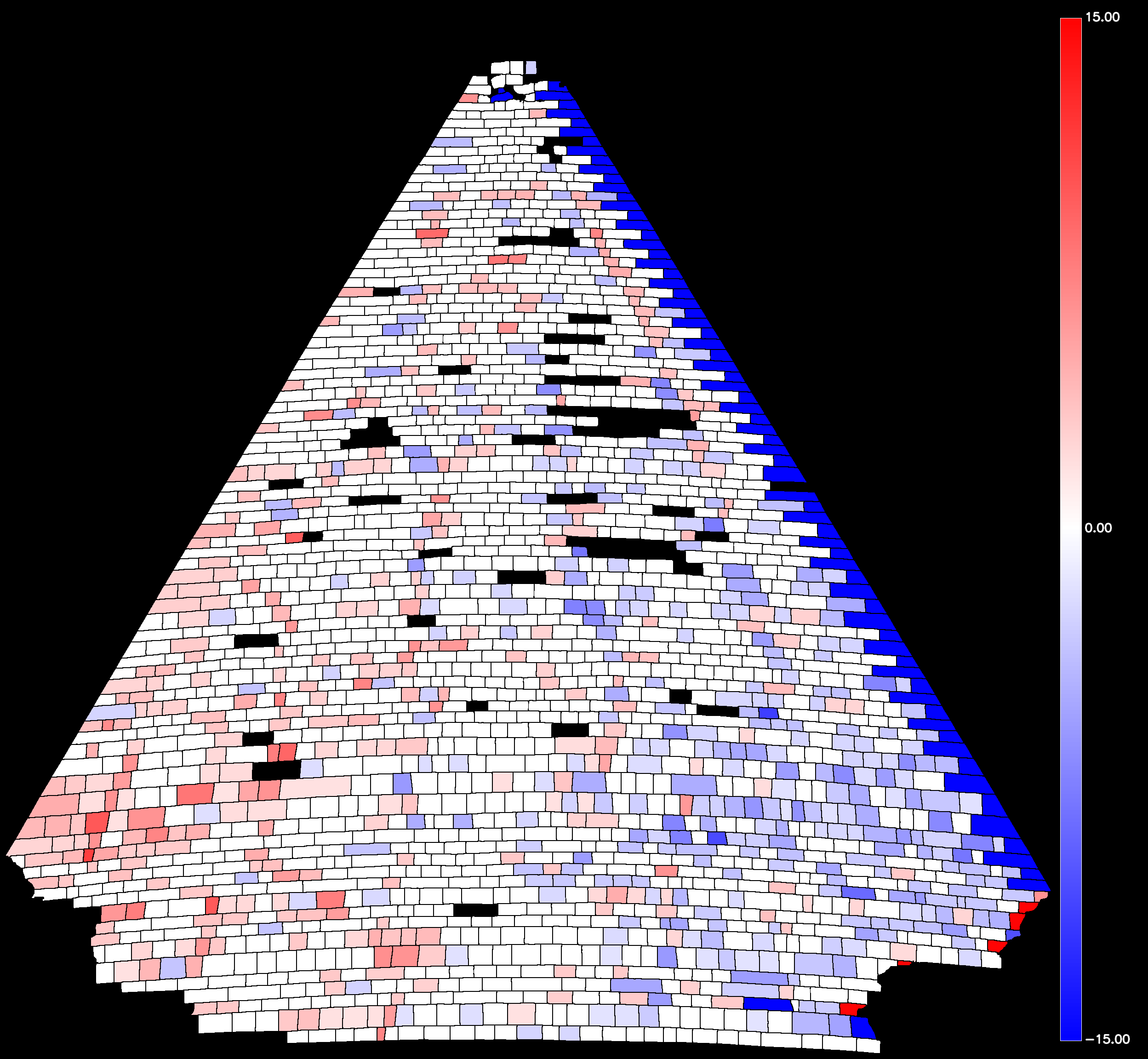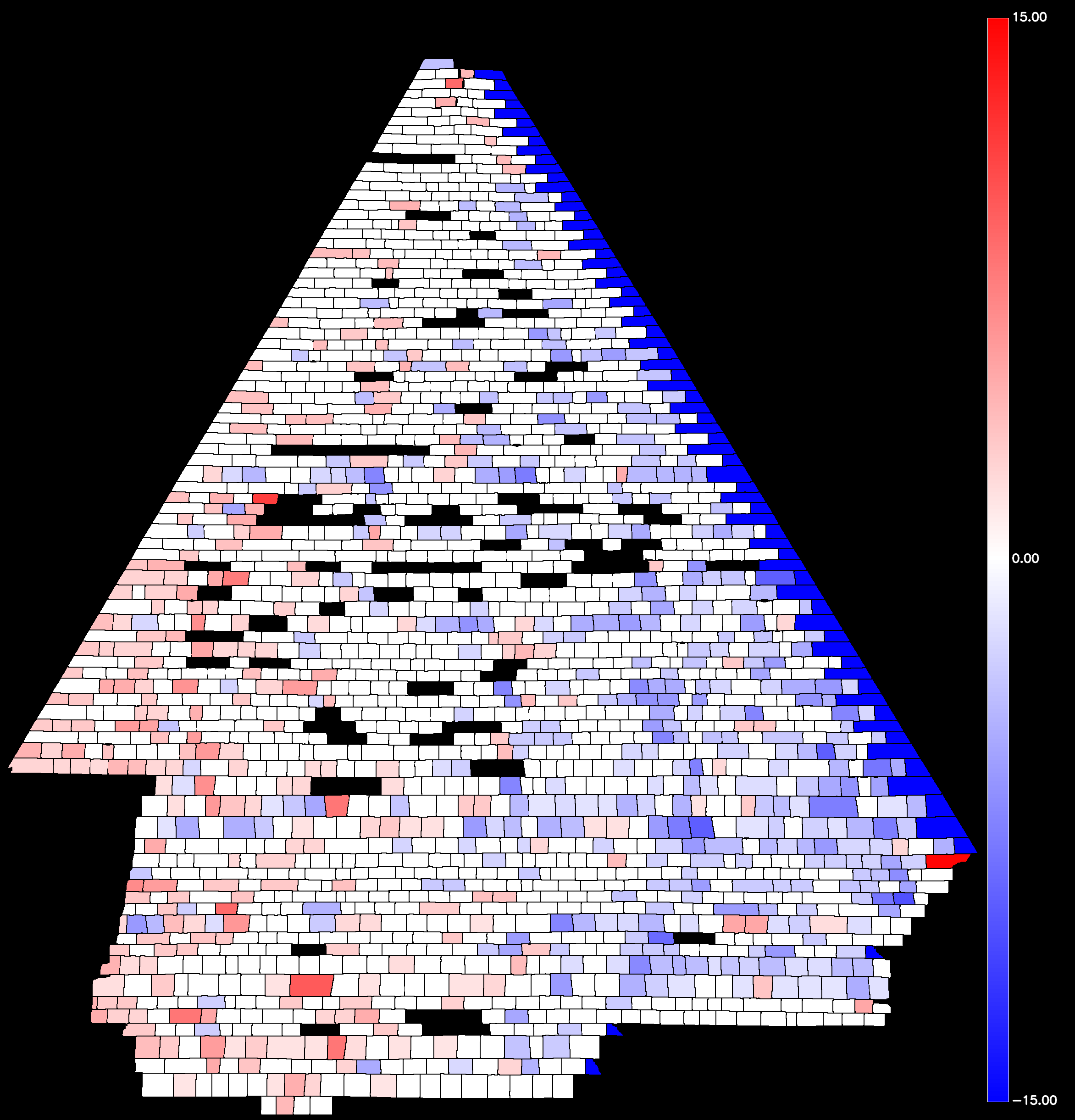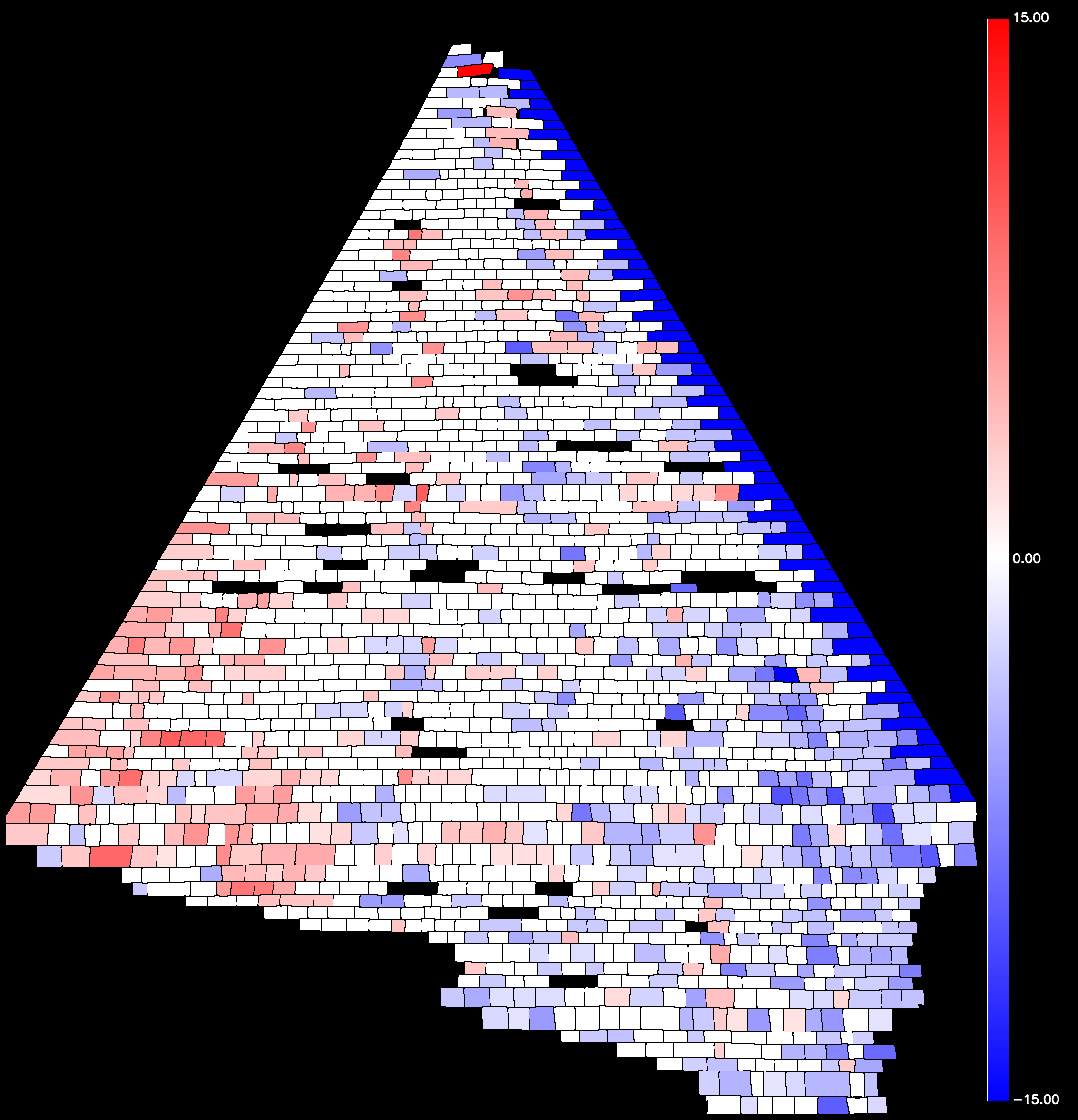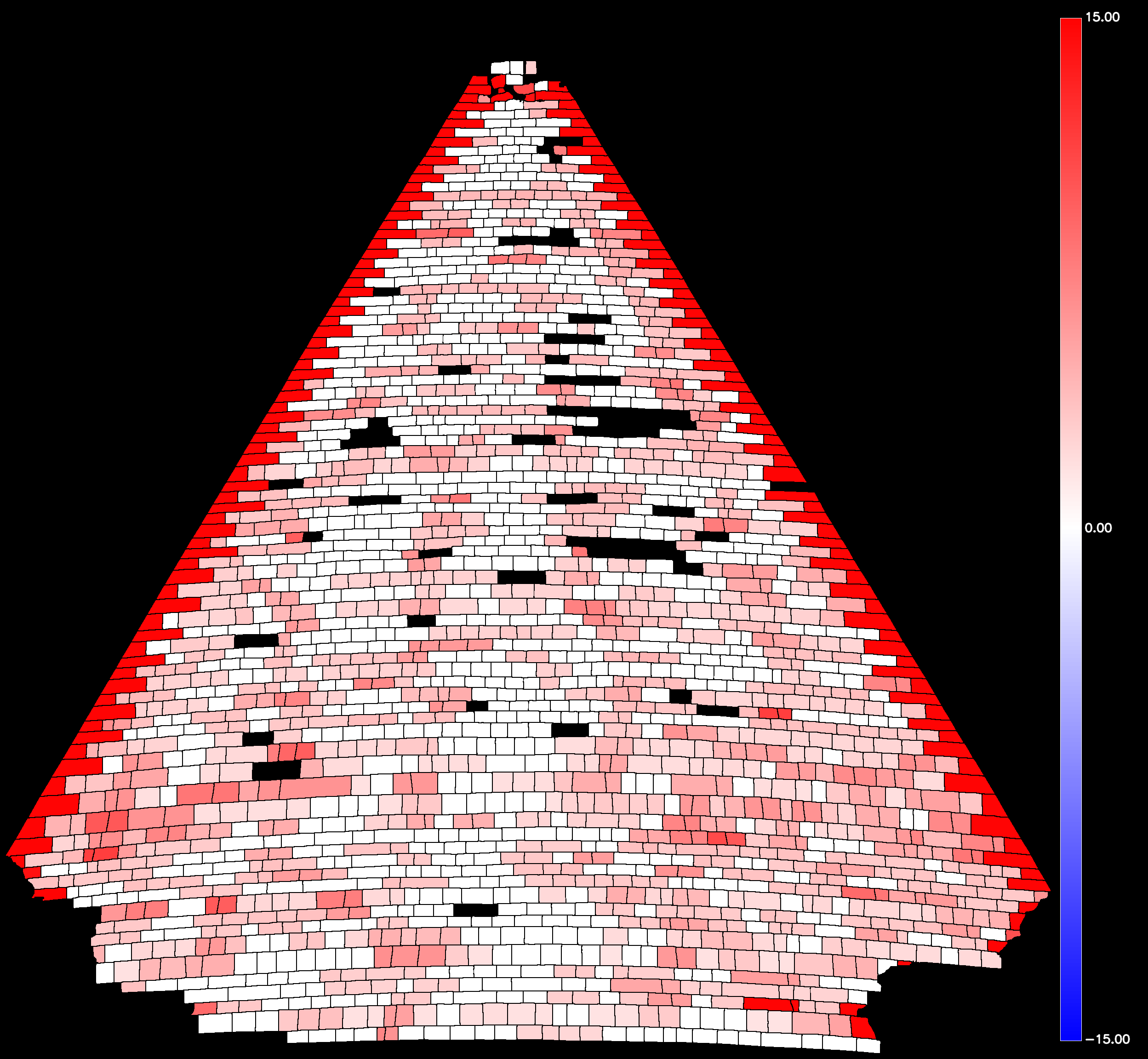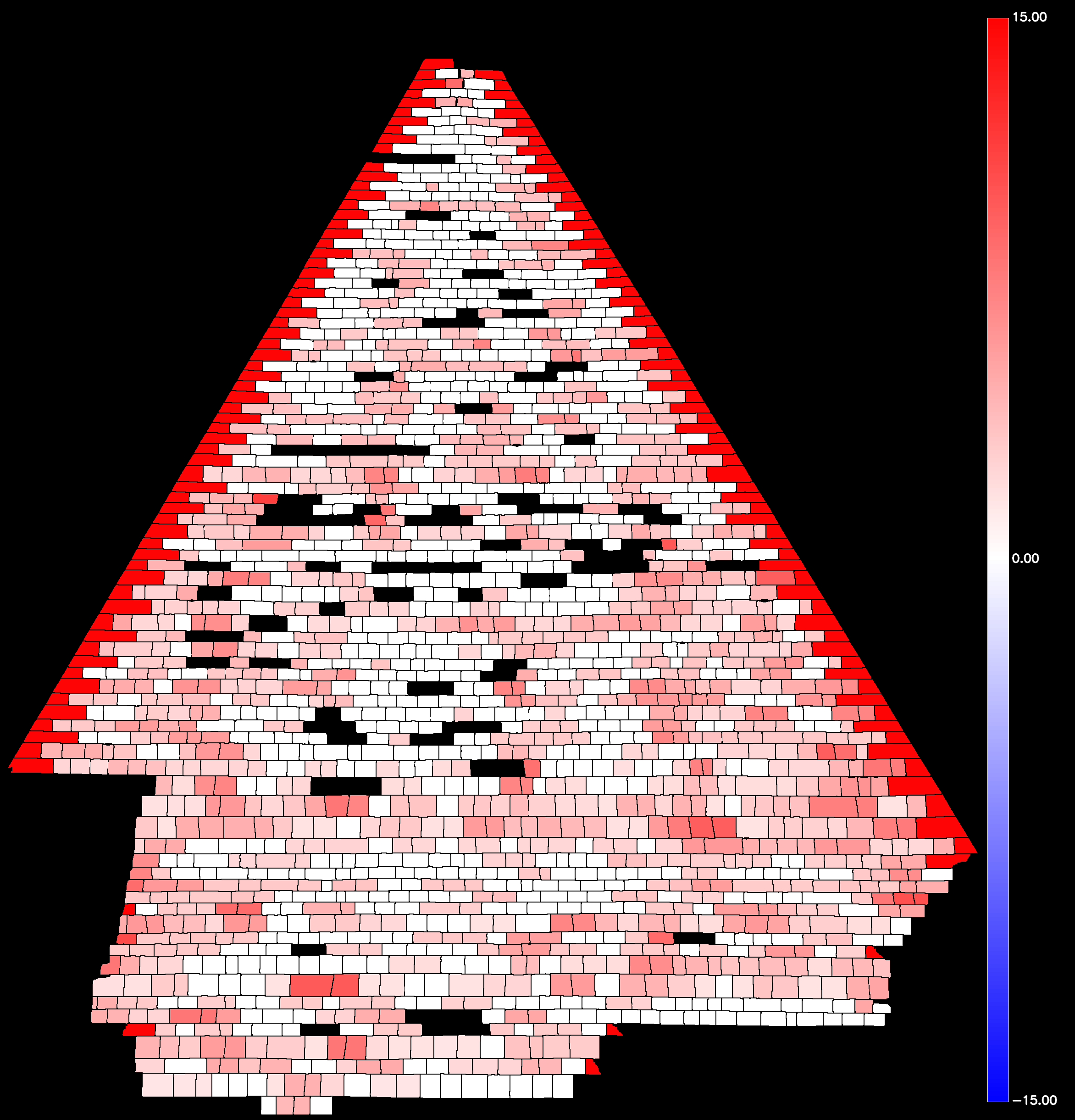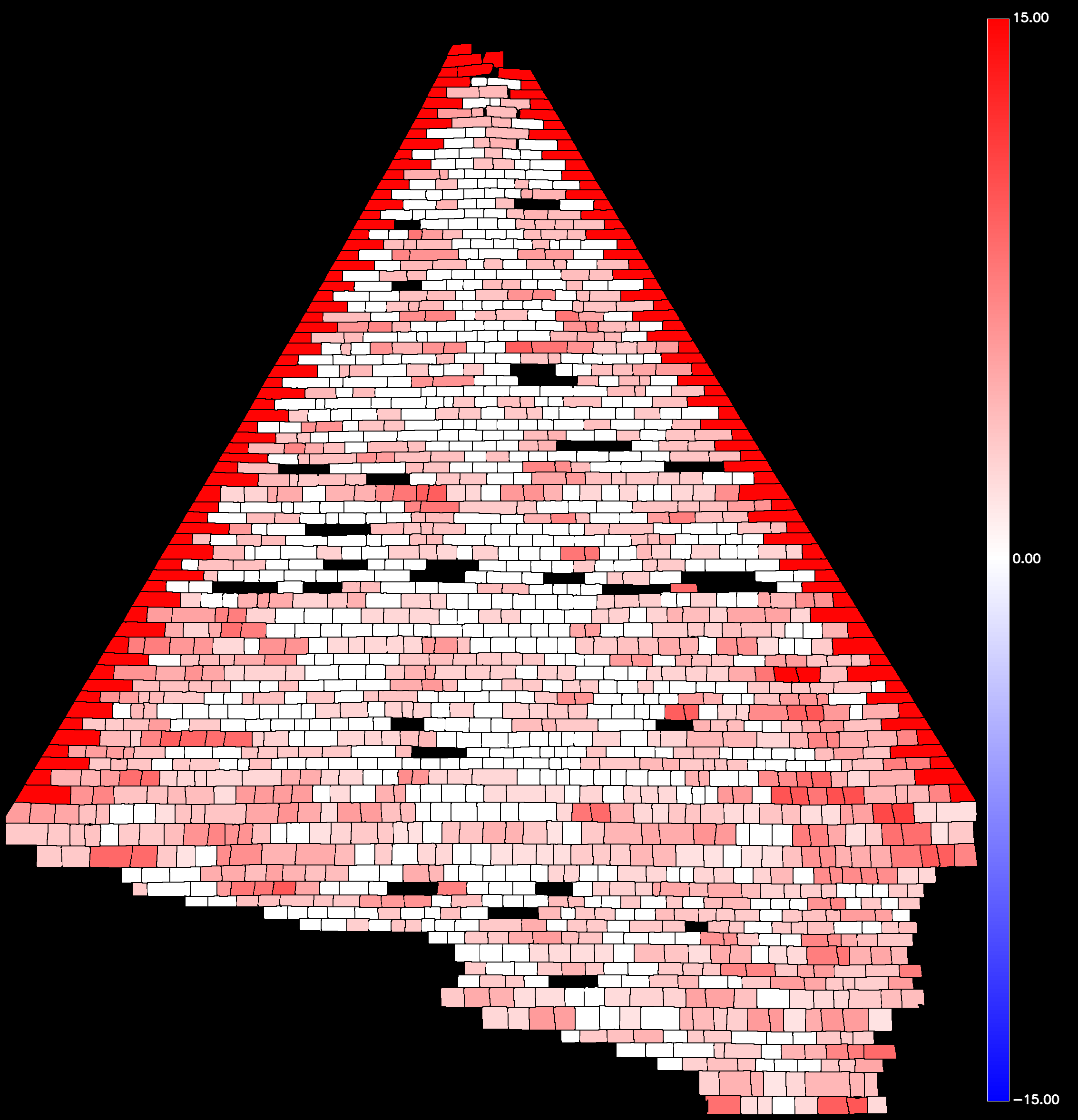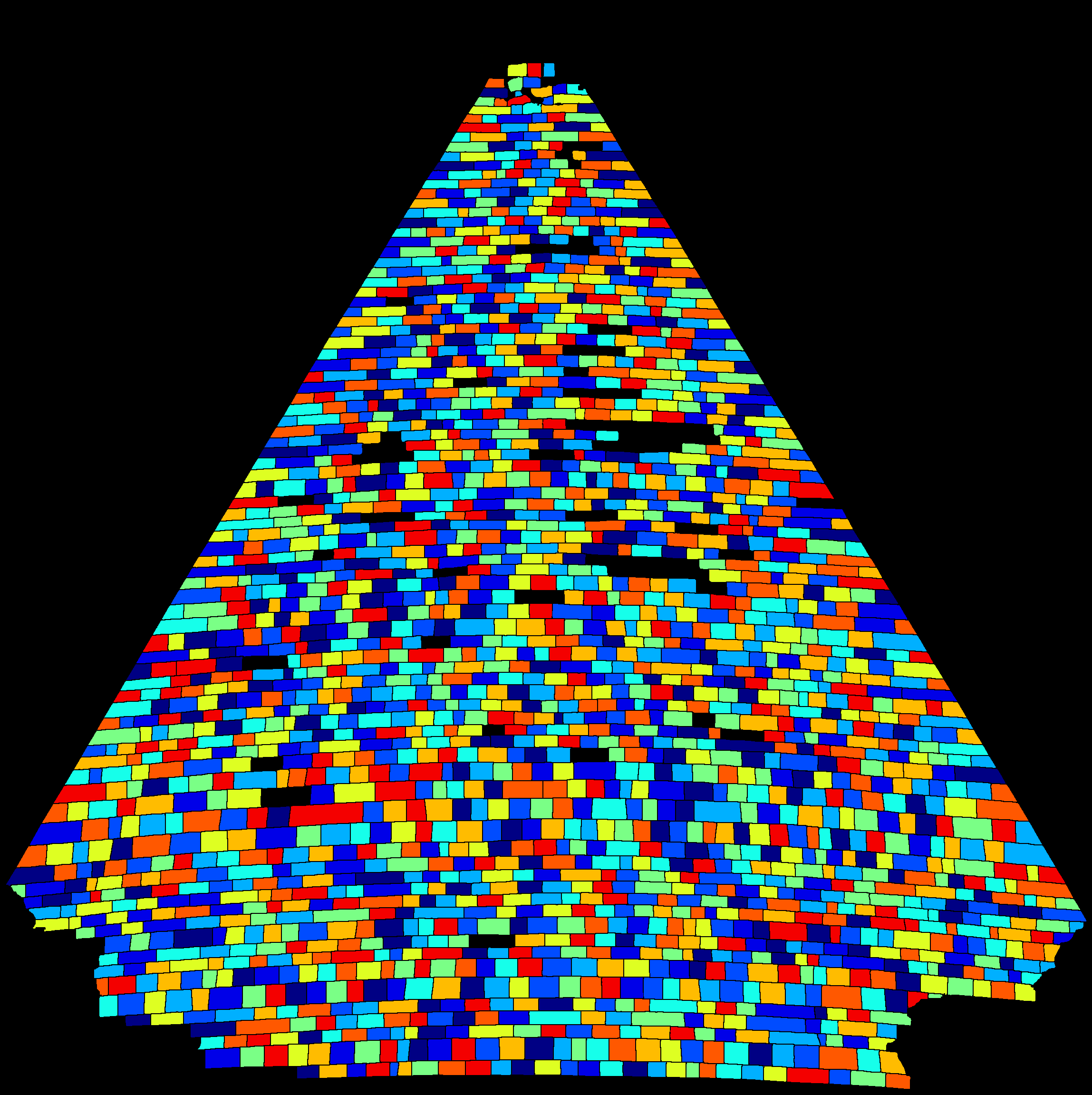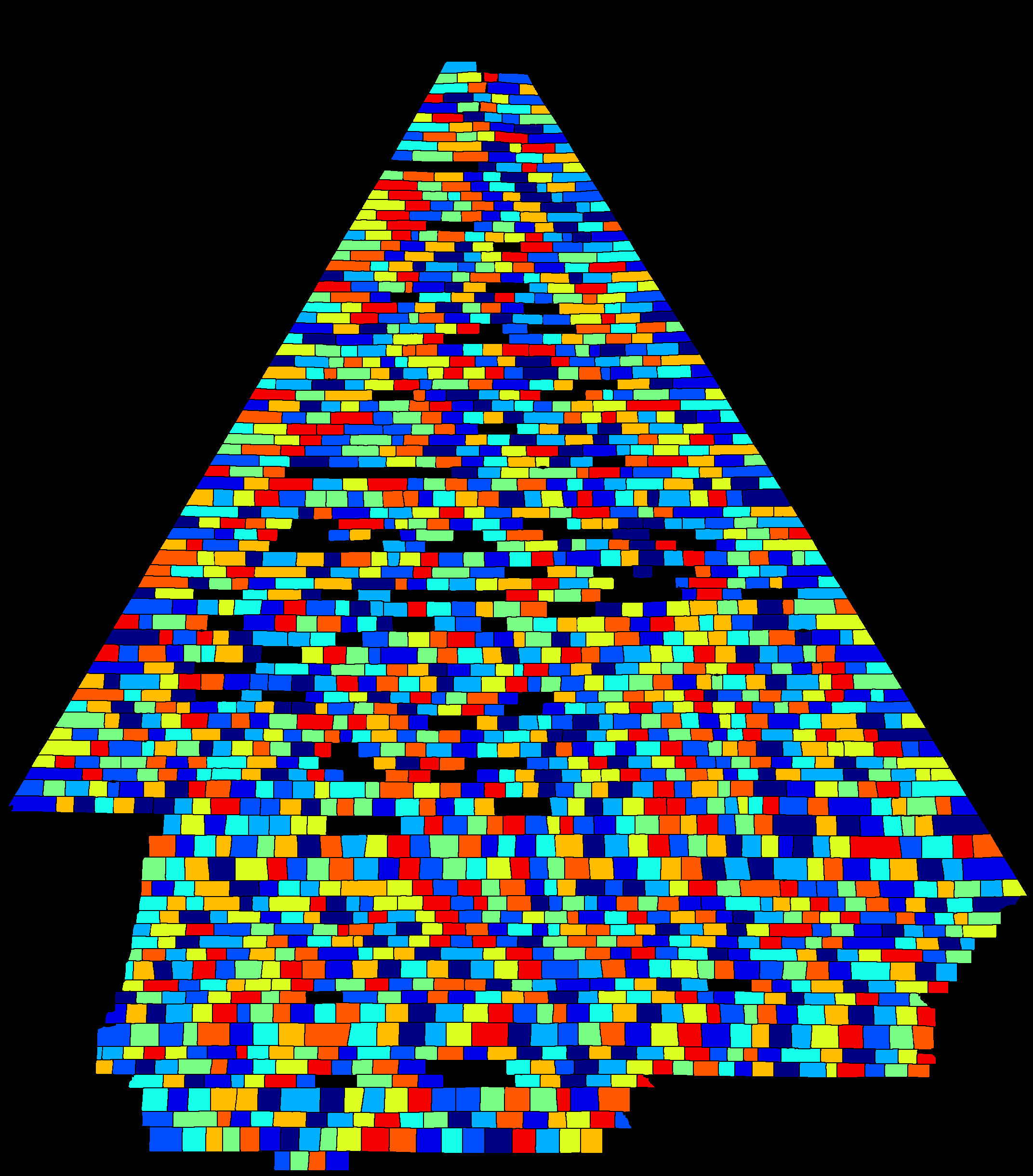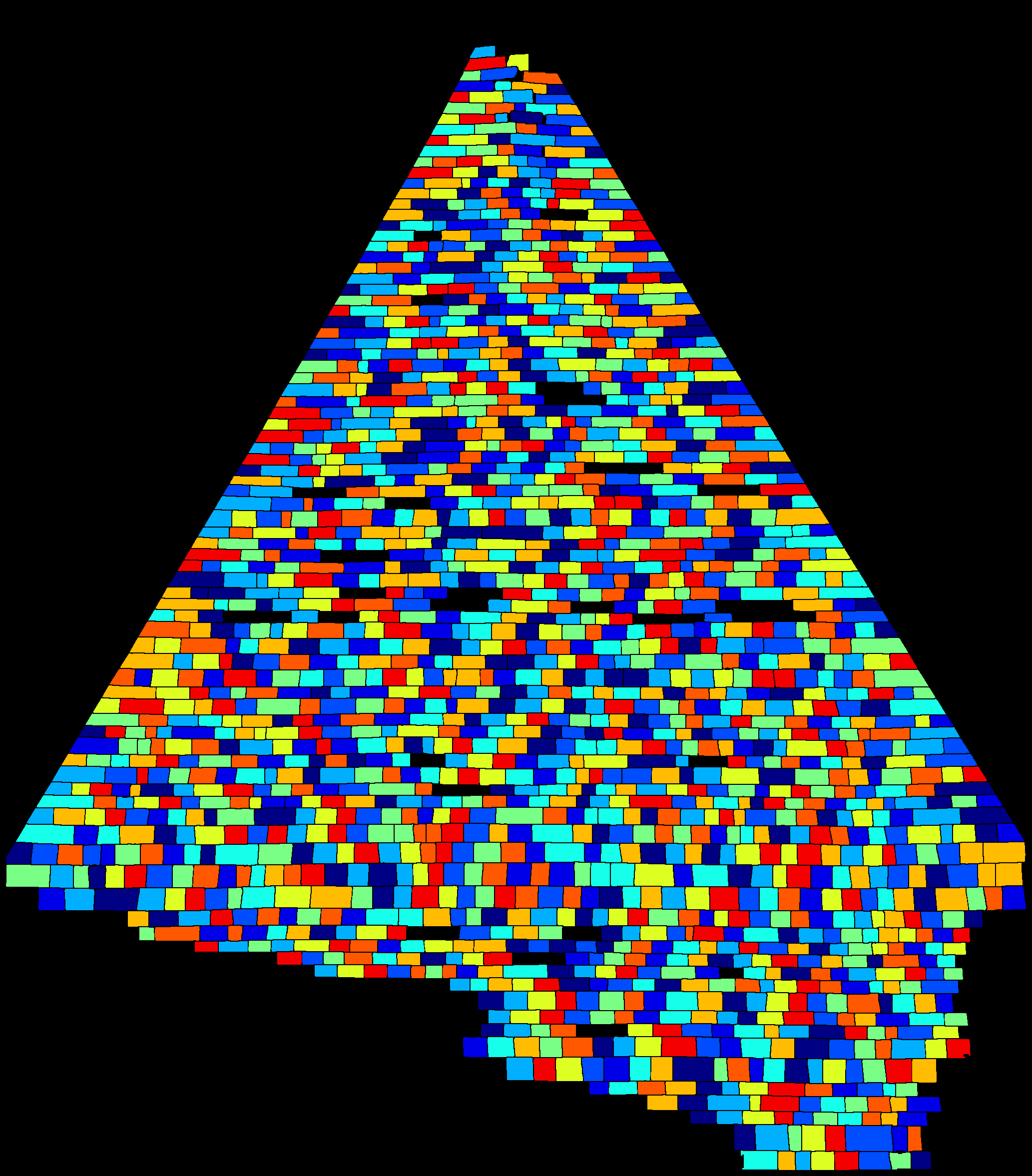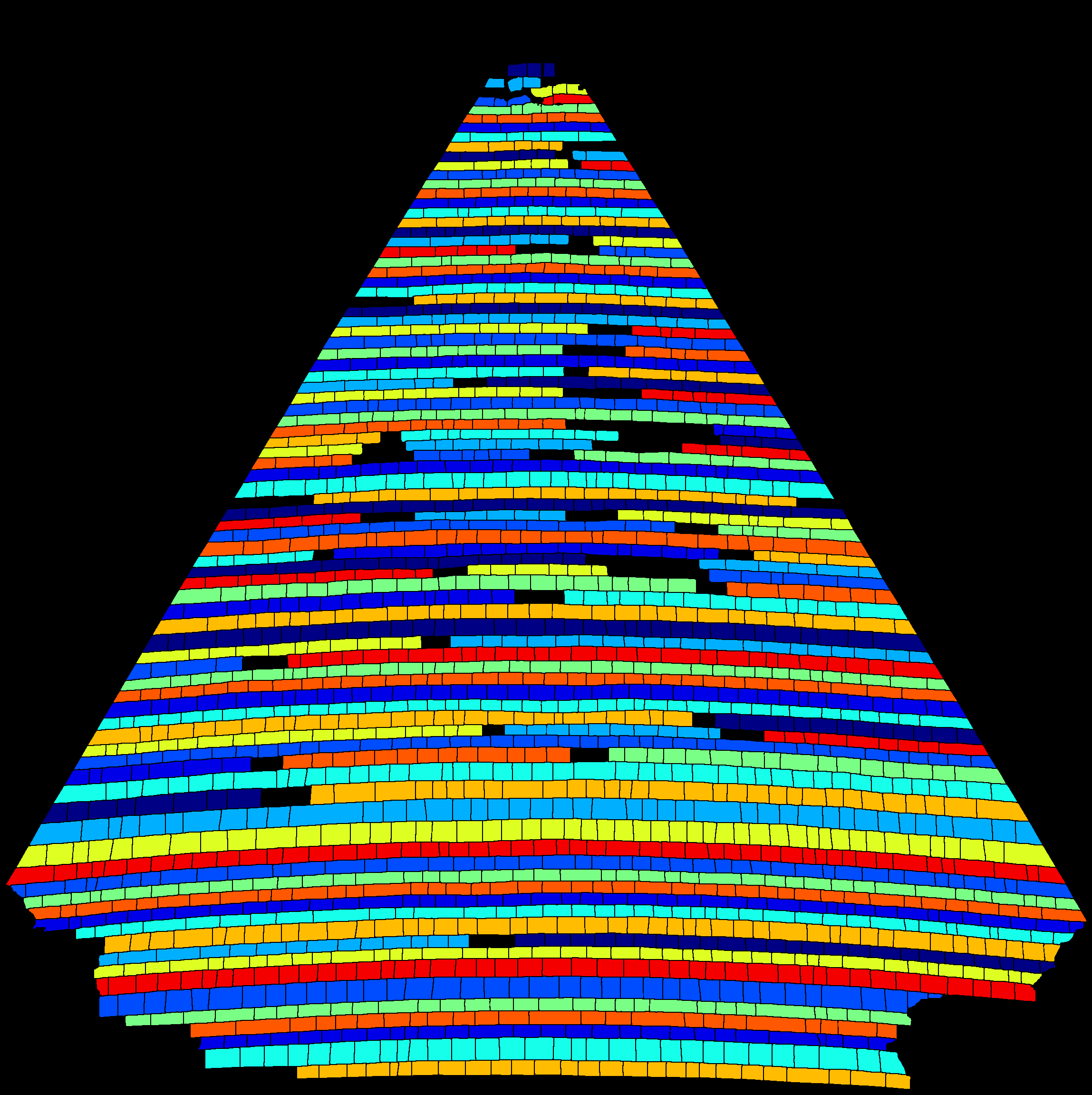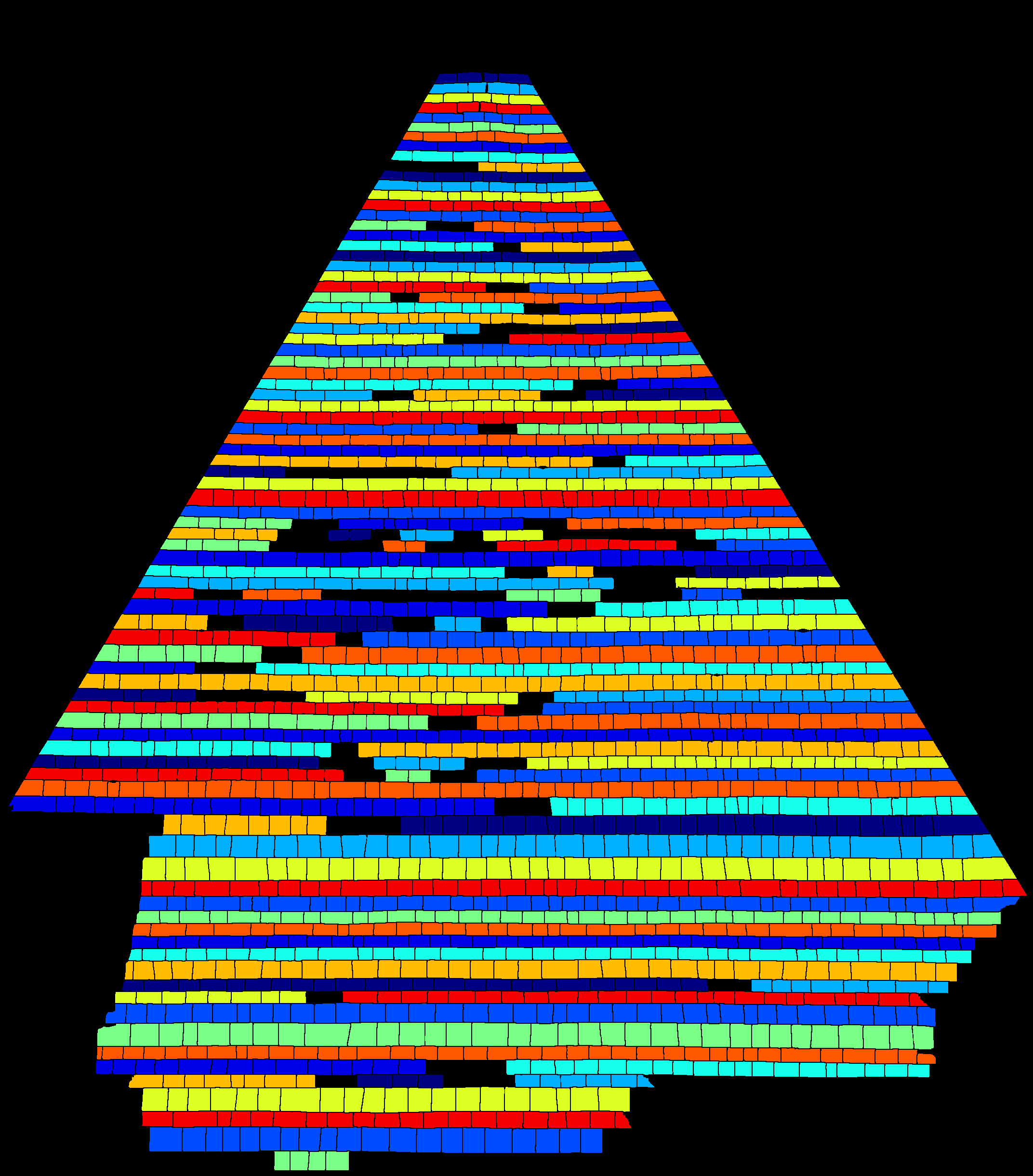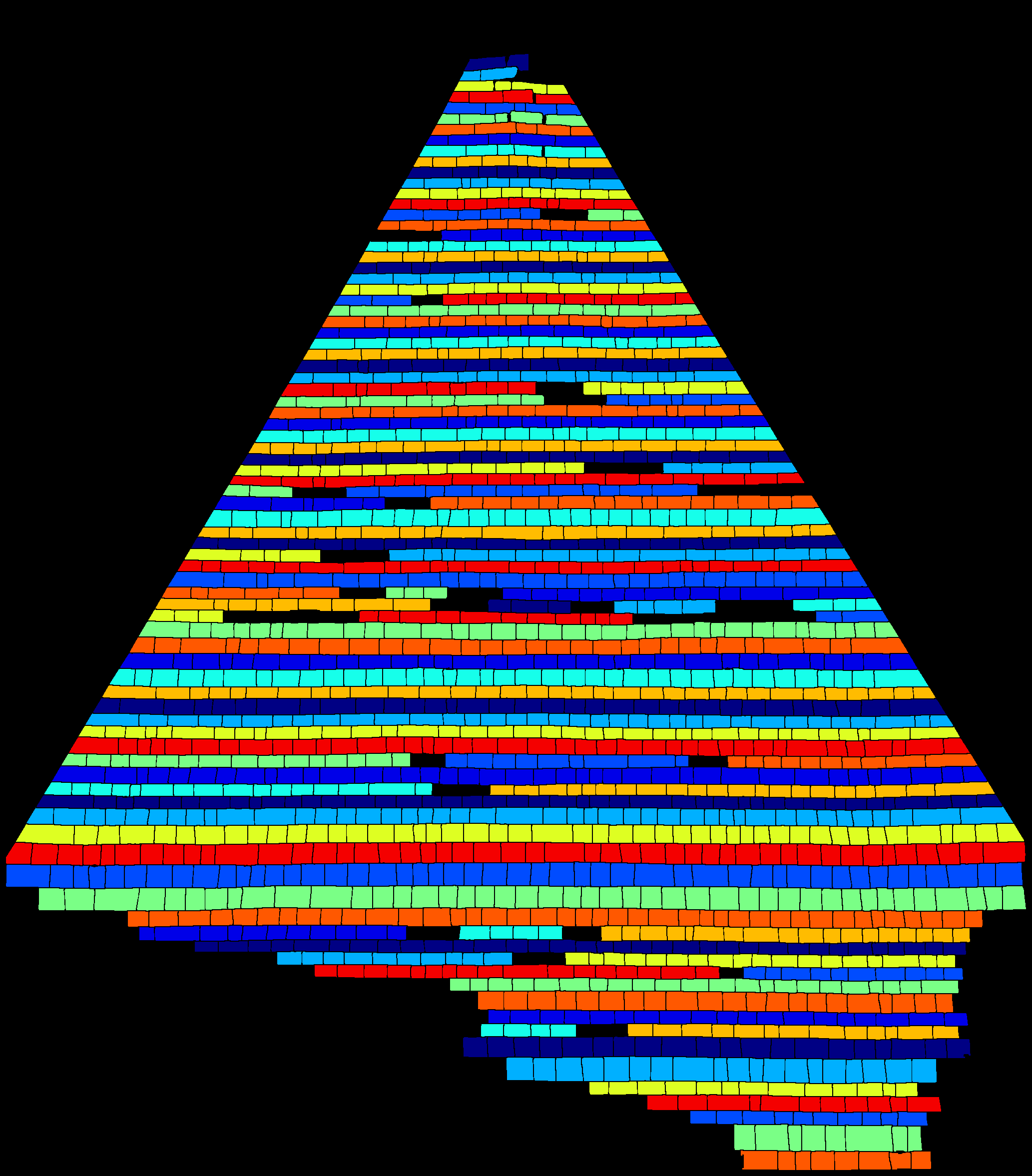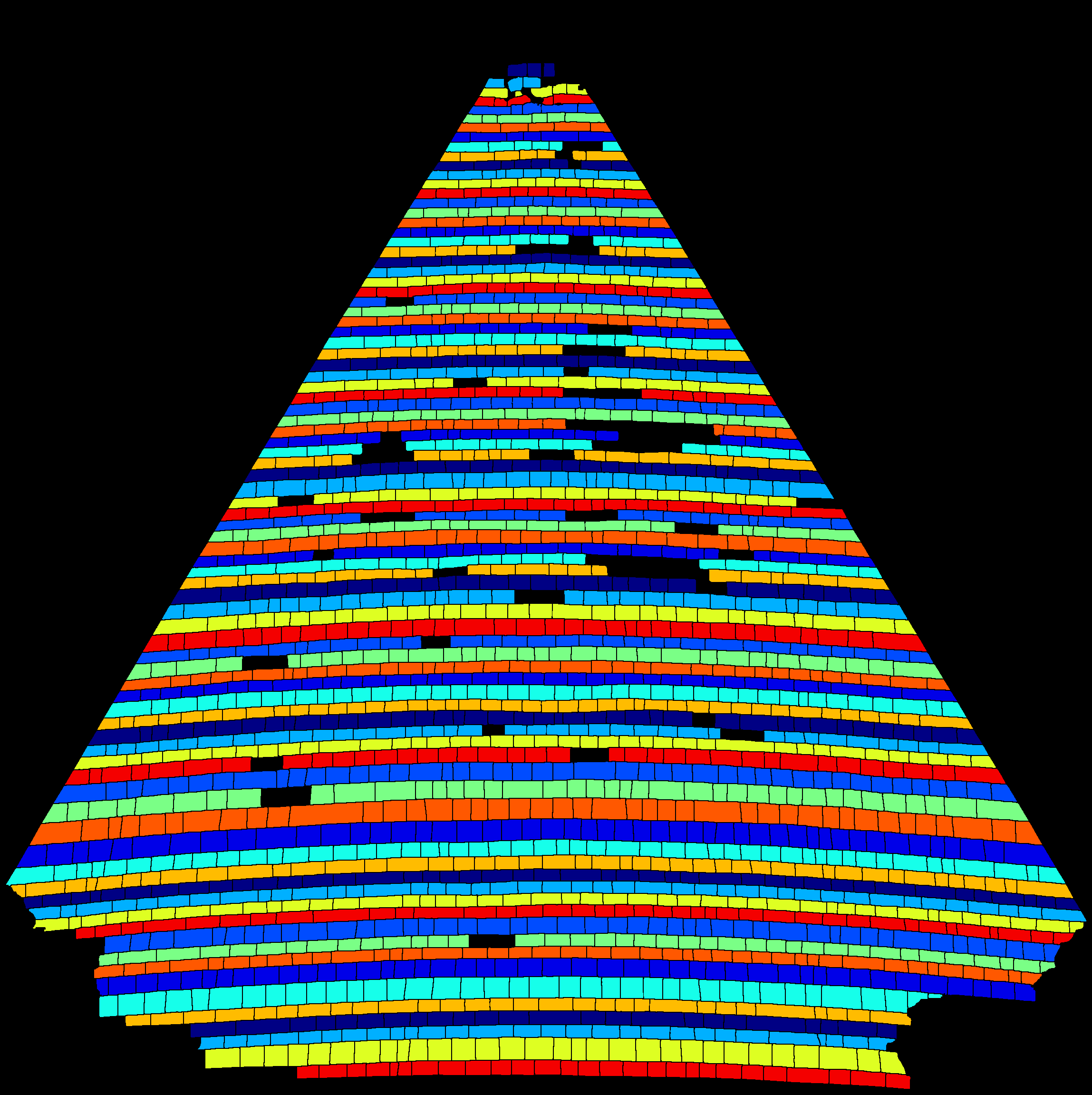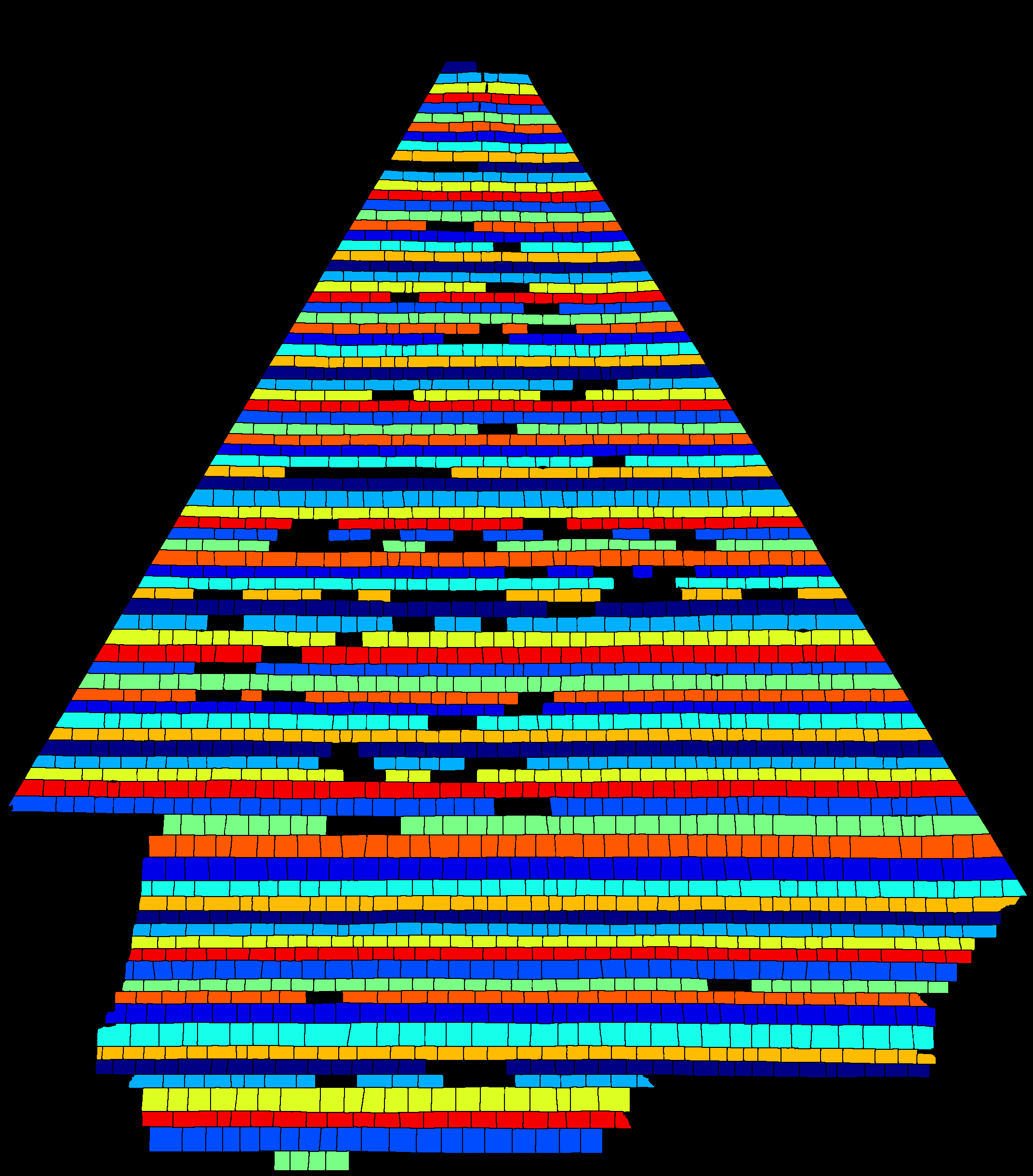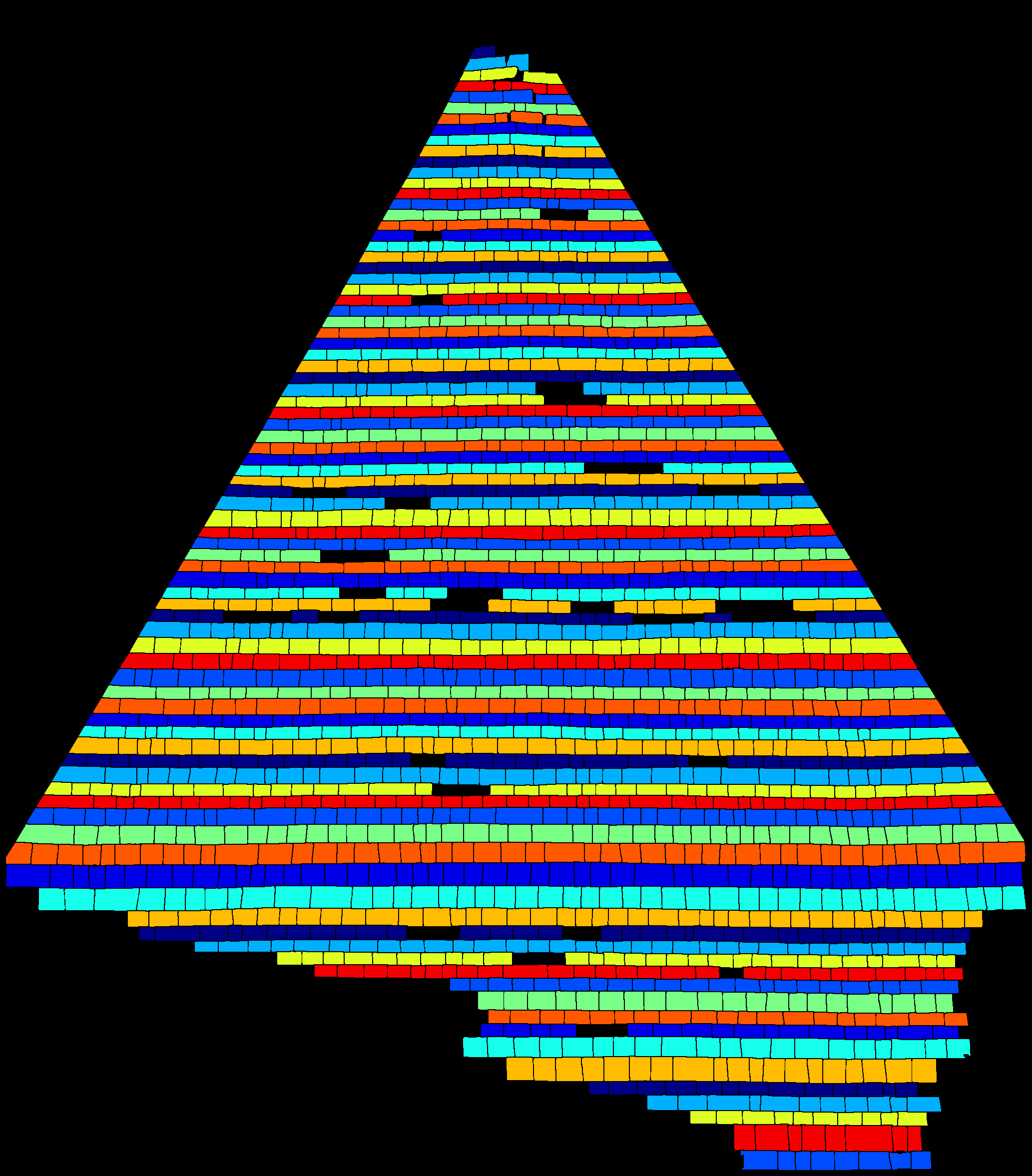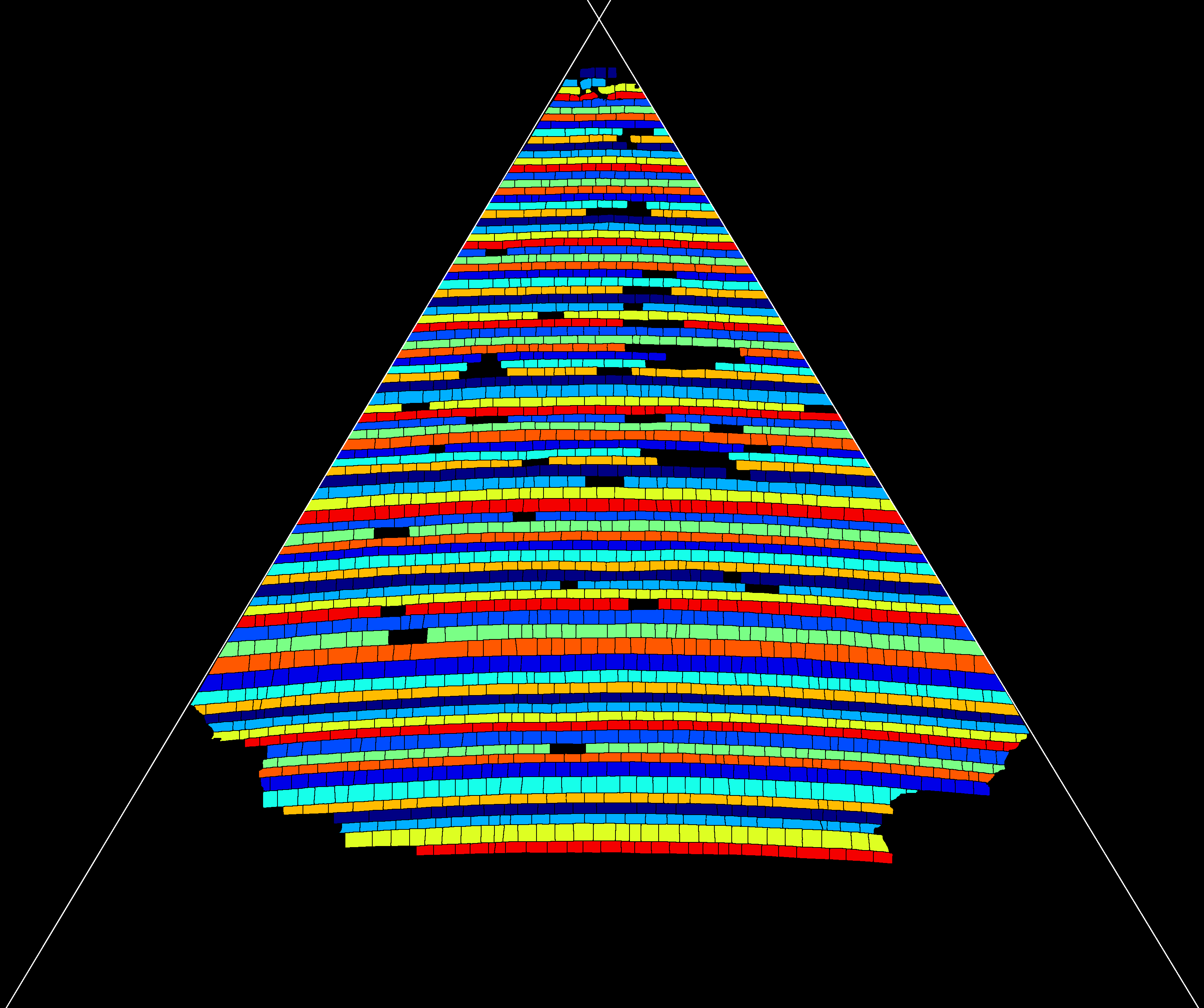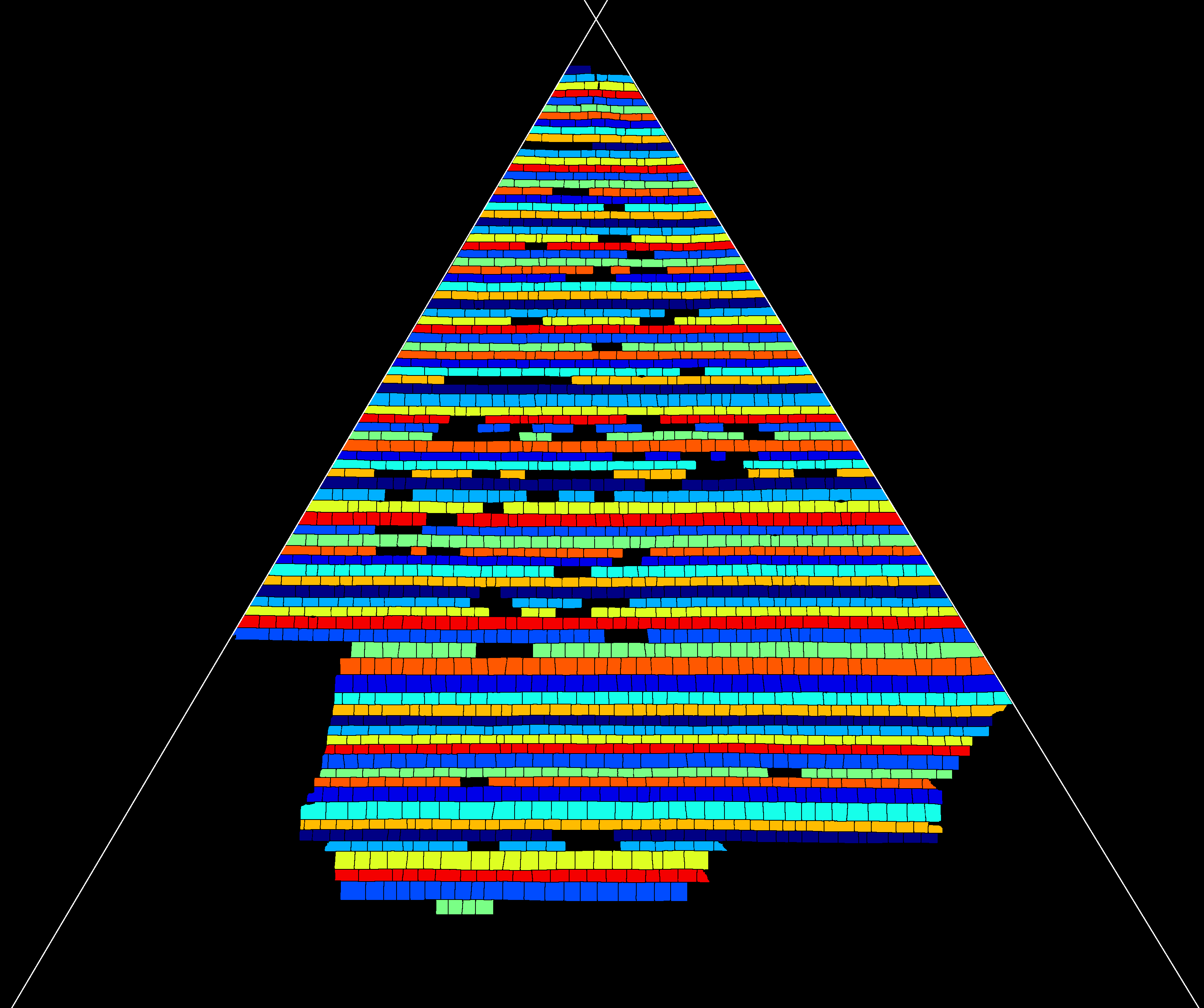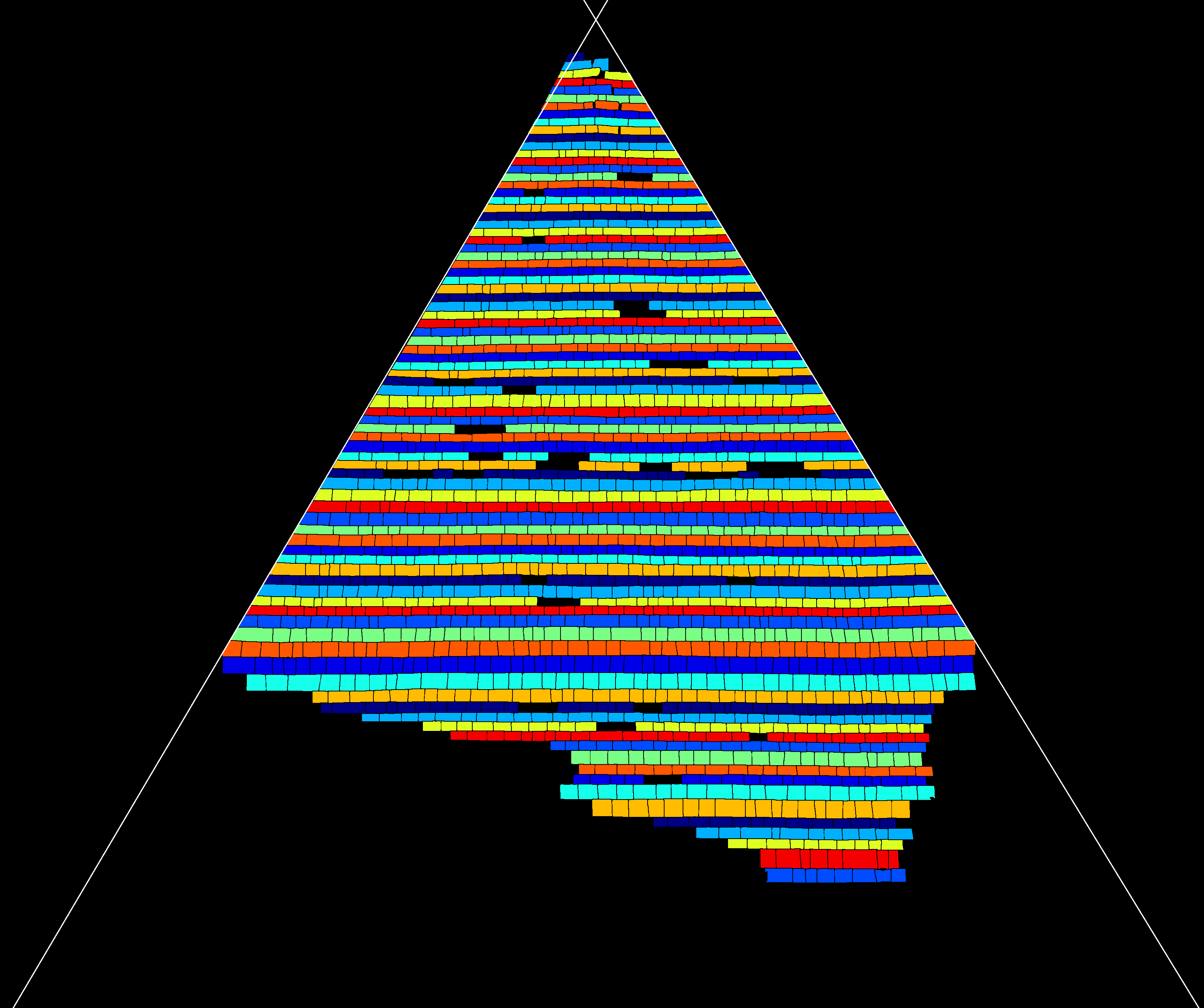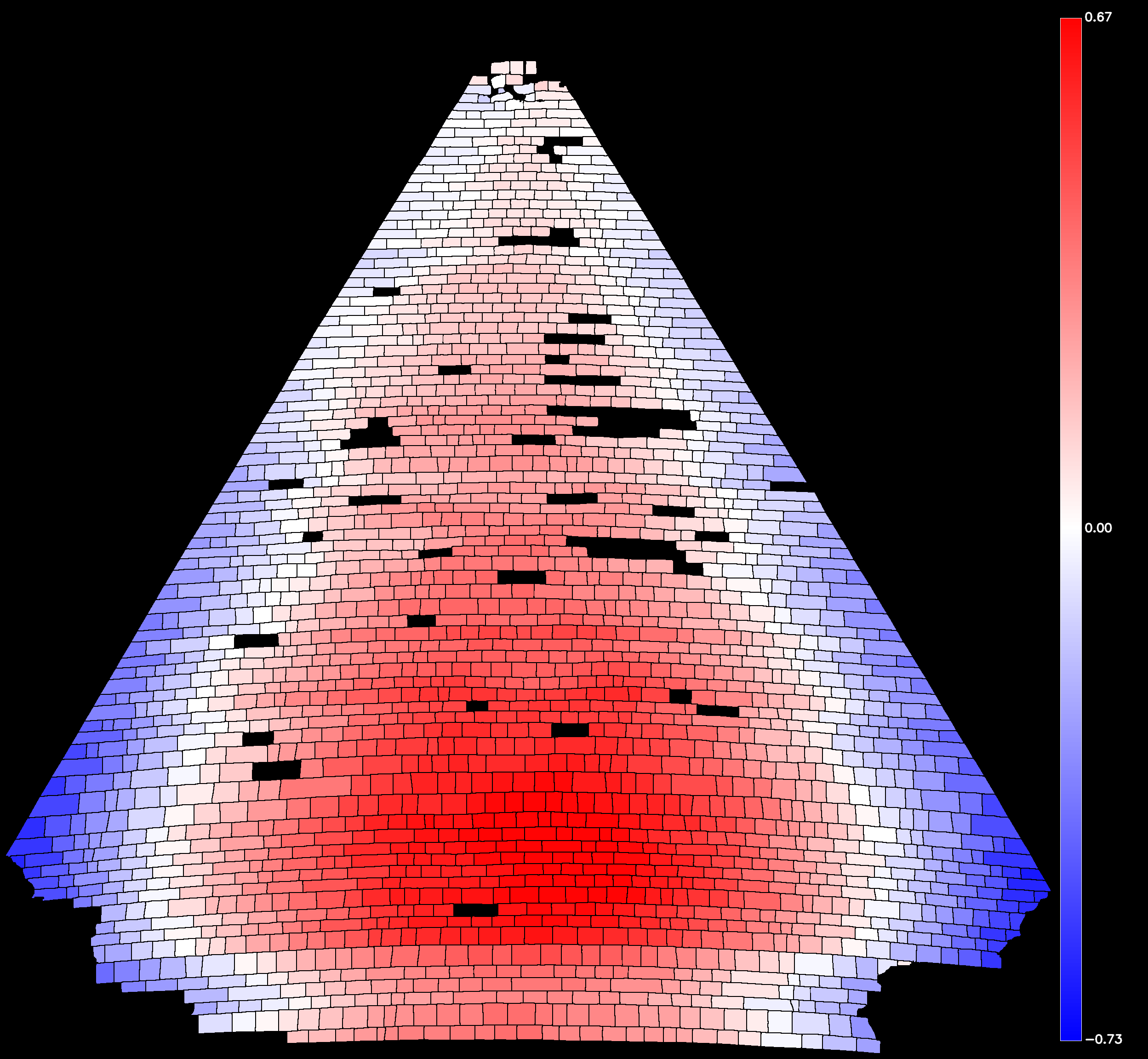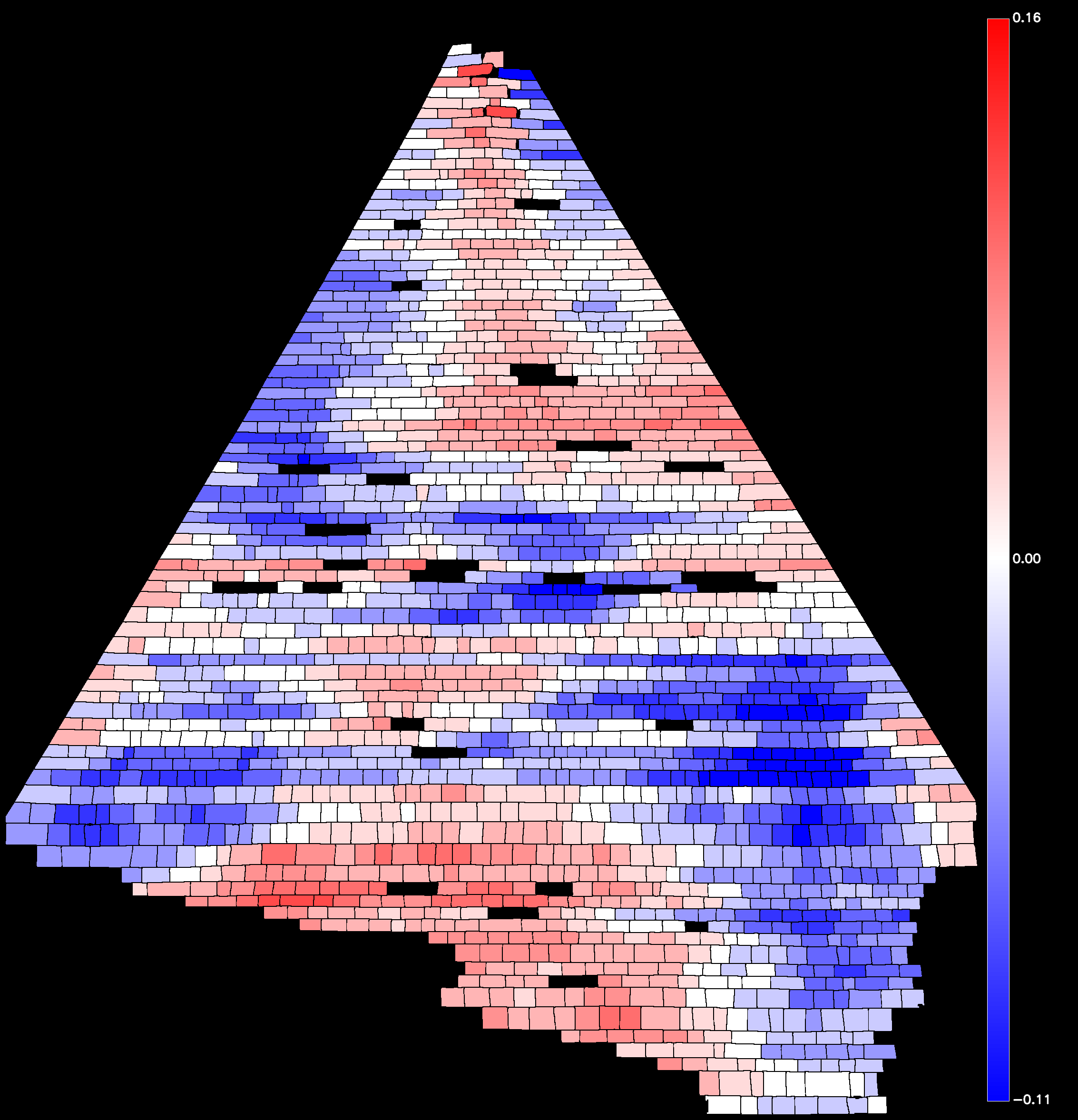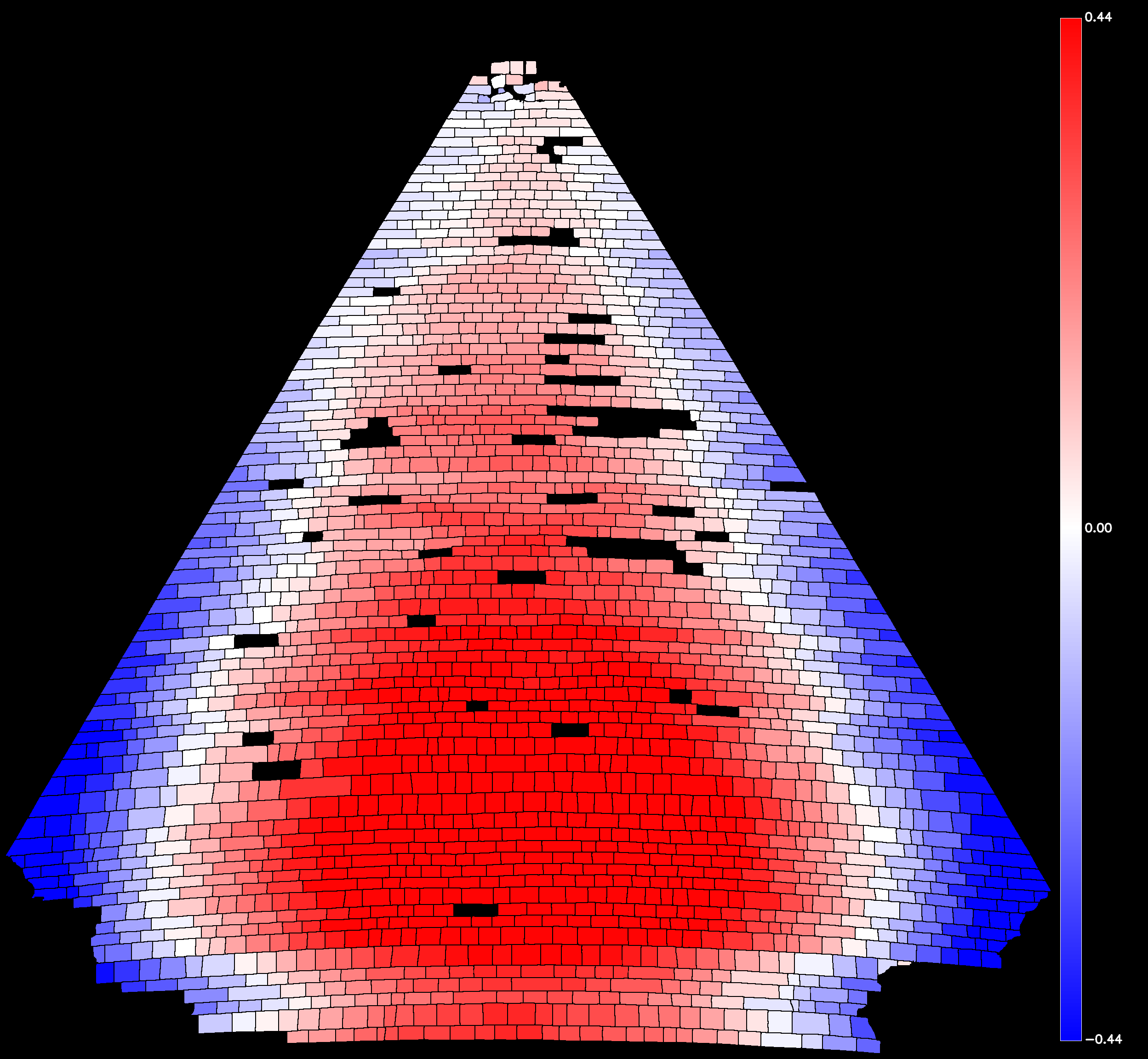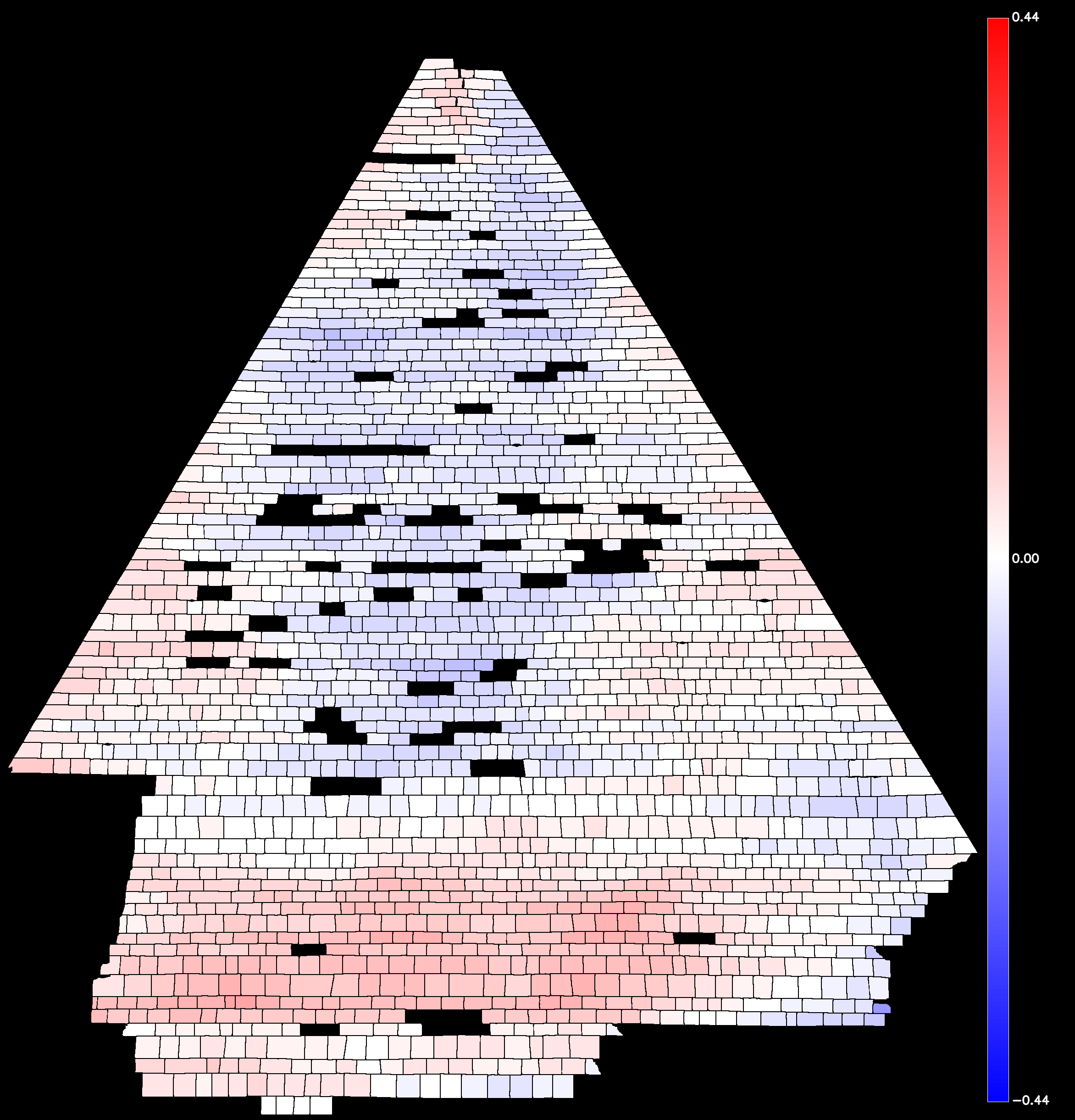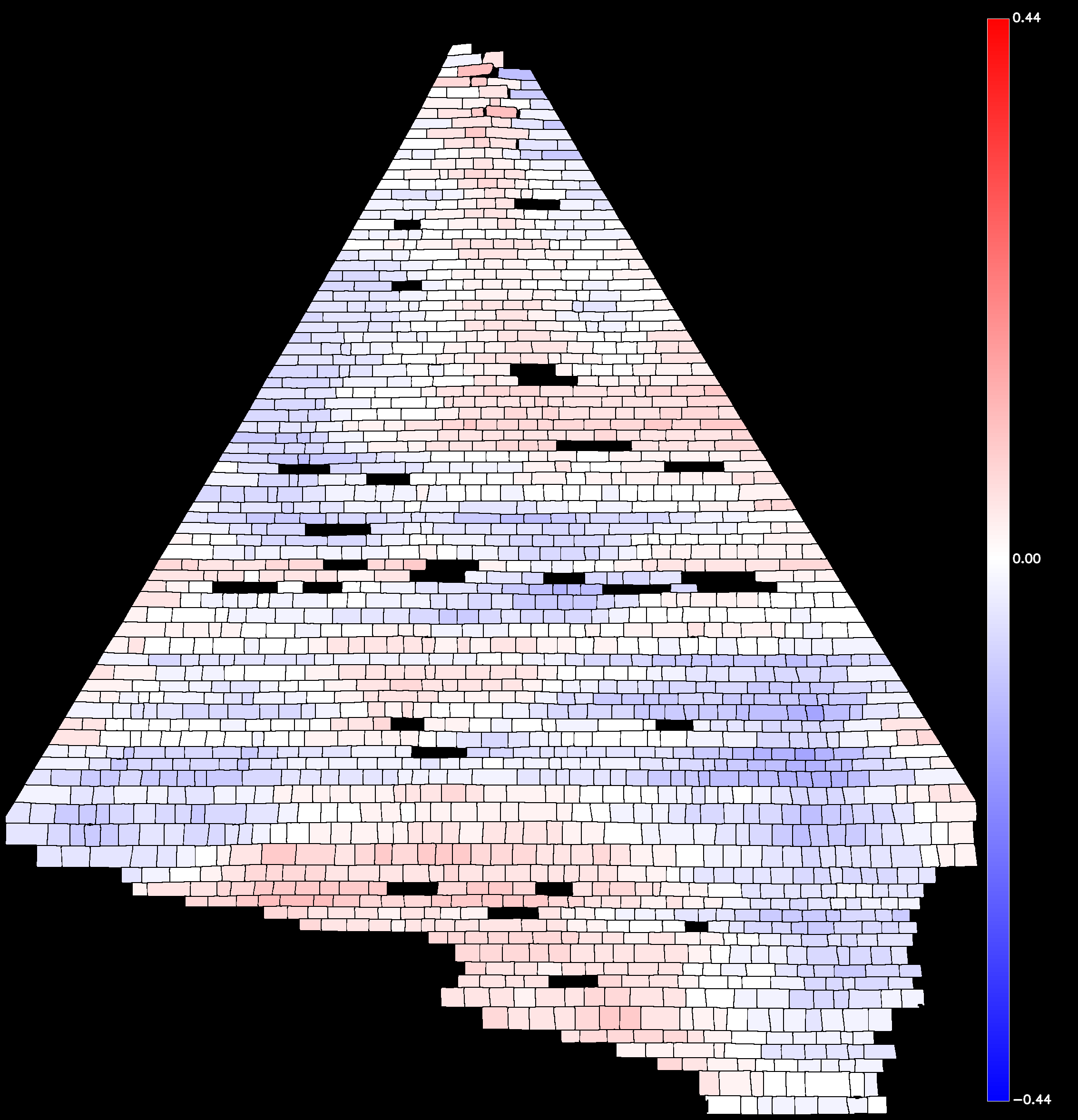A Statistical Analysis of The Pyramid of Khafre's Casing Stones

Introduction
The Pharaohs of the Old Kingdom's 4th Dynasty built towering, artificial sacred mountains of stone on the plateau overlooking their capital, Memphis. A pyramid was a symbol of their power and their dominance over both the physical world in which they resided and the intangible horizon that segregated the earth from the heavens.
Khafre oversaw the building of the second-largest pyramid on bedrock ten metres higher than Khufu's, allowing his construction to rise above his predecessors'. Roughly the top third of the smoothed outer casing stones are still present at the top of his pyramid, and I have been inspired to do some basic analysis of these casing stones based on recent line-drawings produced by History for Granite. (Note that there is no line-drawing or analysis for the West Face.)
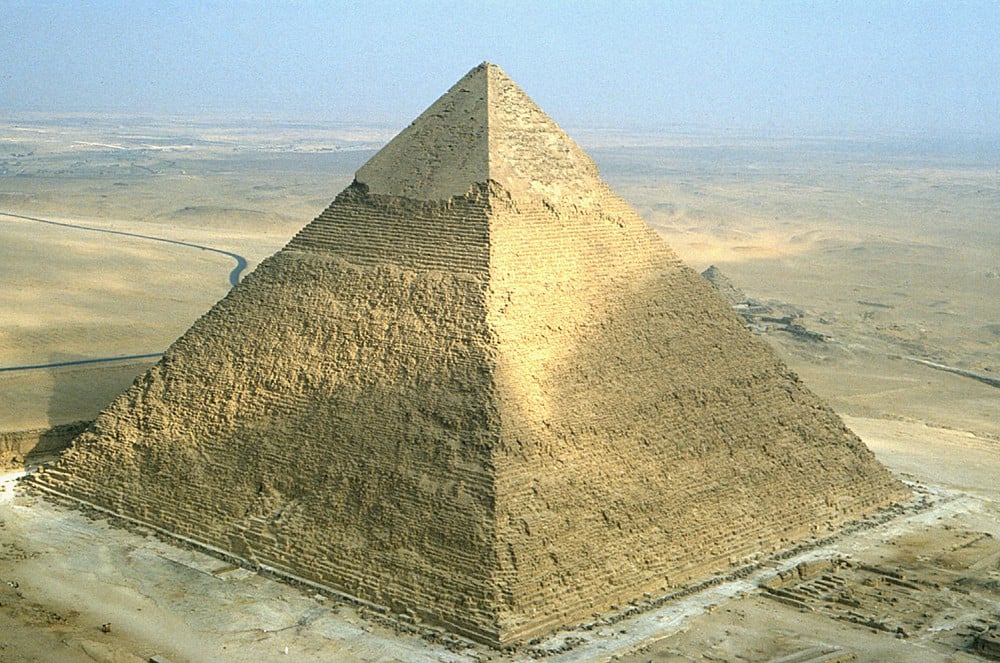
Most images are available in a larger form if you "right click" -> "open image in new tab".
Contents
- Main Observations
- Overview and Comparison of Faces
- Data and Methodology
- All Observations
- Acknowledgments
Main Observations
- Construction Consistency
- Bulging in the North Face
- Joining, or fitting, stones
- Alternating corner pattern
- Angles on the vertical edges of stones
- Chains of offset stones
Construction Consistency
The construction of the casing stones still remaining is, in many ways, much more consistent than we might expect from only the second ever attempt at building such a large structure. These casing stones are still here 4500 years later, and the majority of courses are straight, even, and well-fitted.
With that said, there are also significant consistency issues with what we can see of the North Face and, to some extent, the South Face. The East Face, in contrast, is much neater. The North Face appears to have significant upward bulging of the centre of its stone courses and multiple sections of "wobbly" masonry above this area, which is likely due to the difficulty of juggling between a desire for straight, even courses and needing to correct for the earlier bulging issues. The South Face is straight on average but also contains several "wobbly" masonry courses, mostly centred around individual stones that are taller or shorter than they should be.
| North Face | South Face |
|---|---|
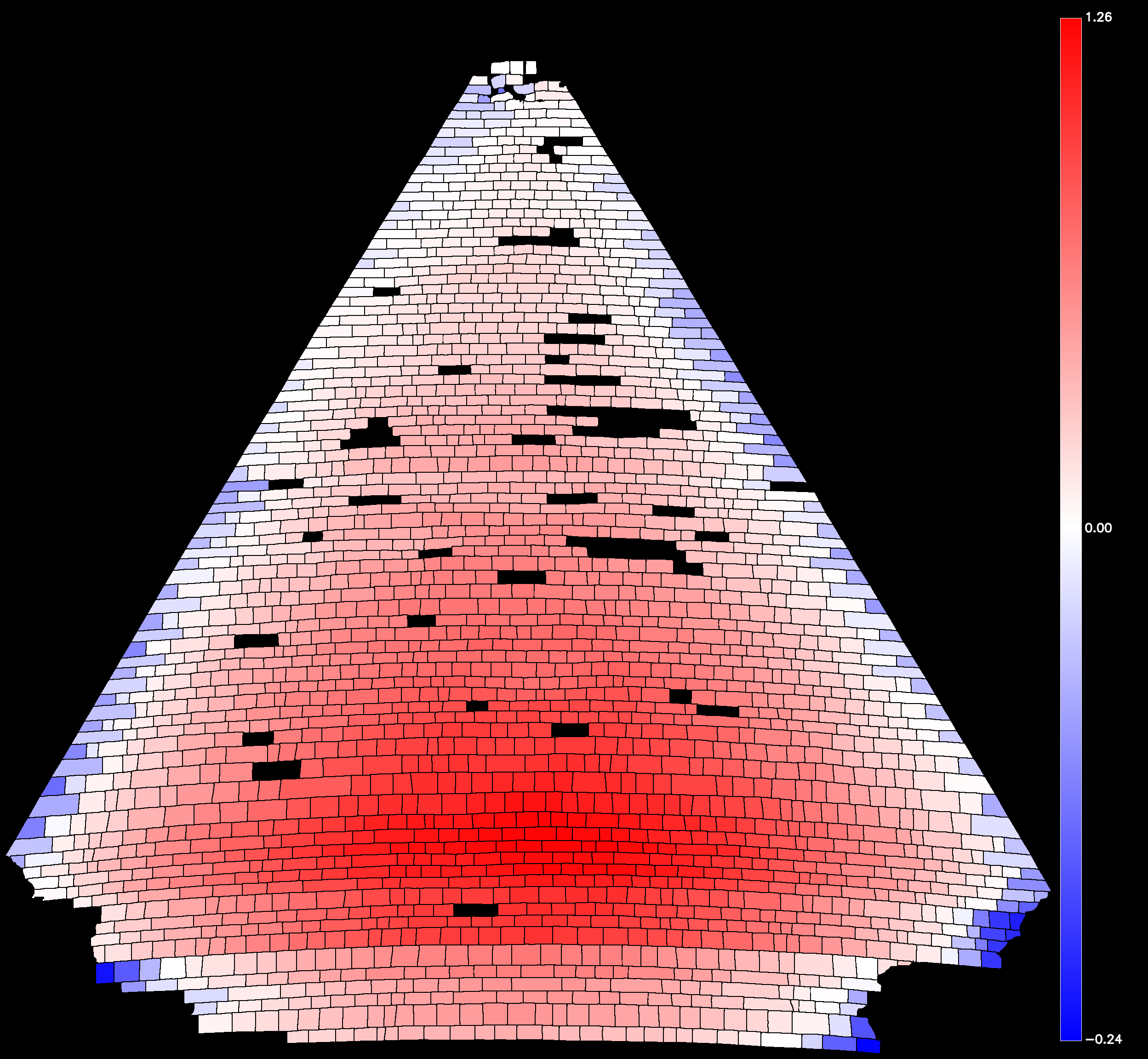
|
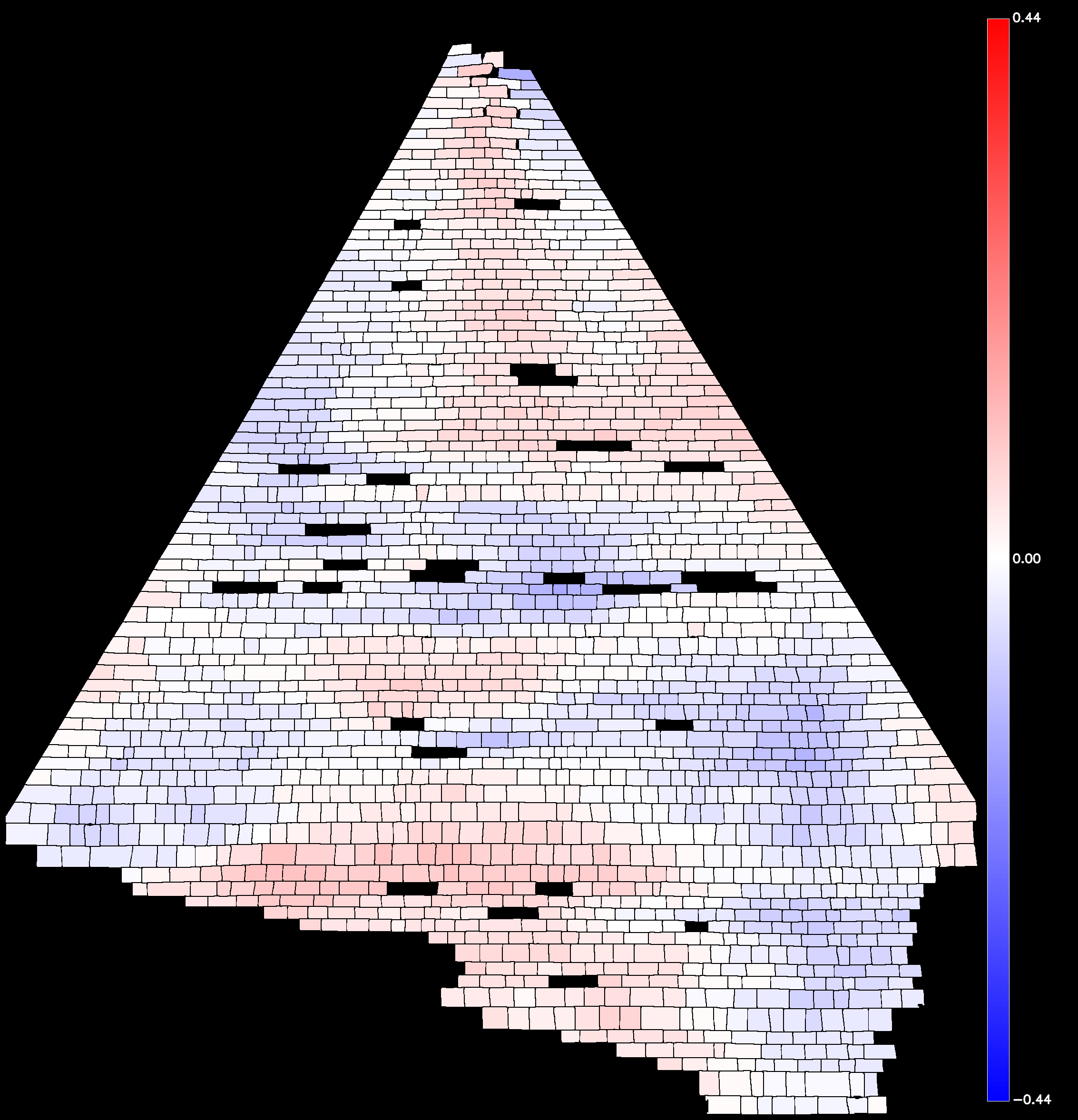
|
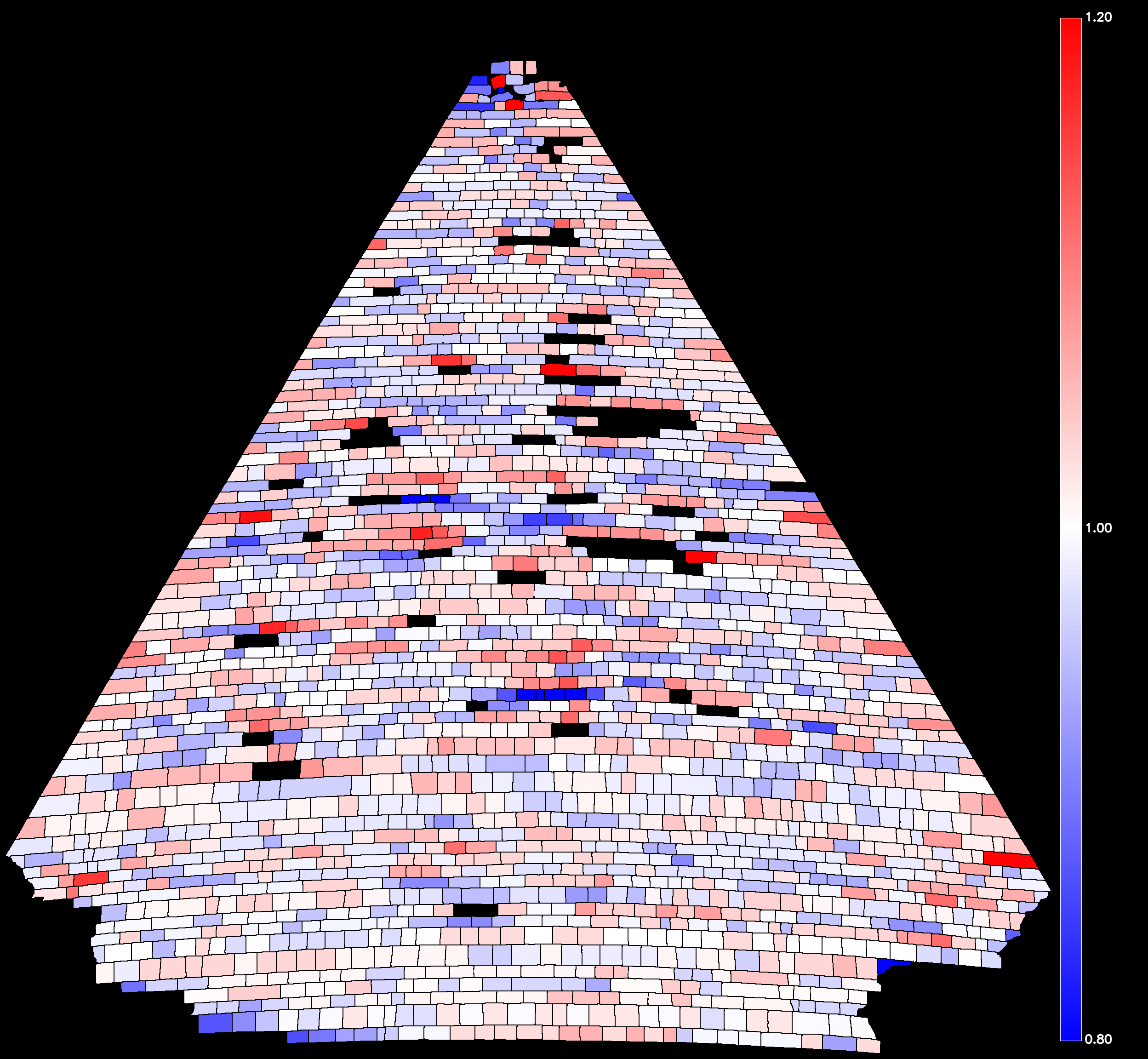
|
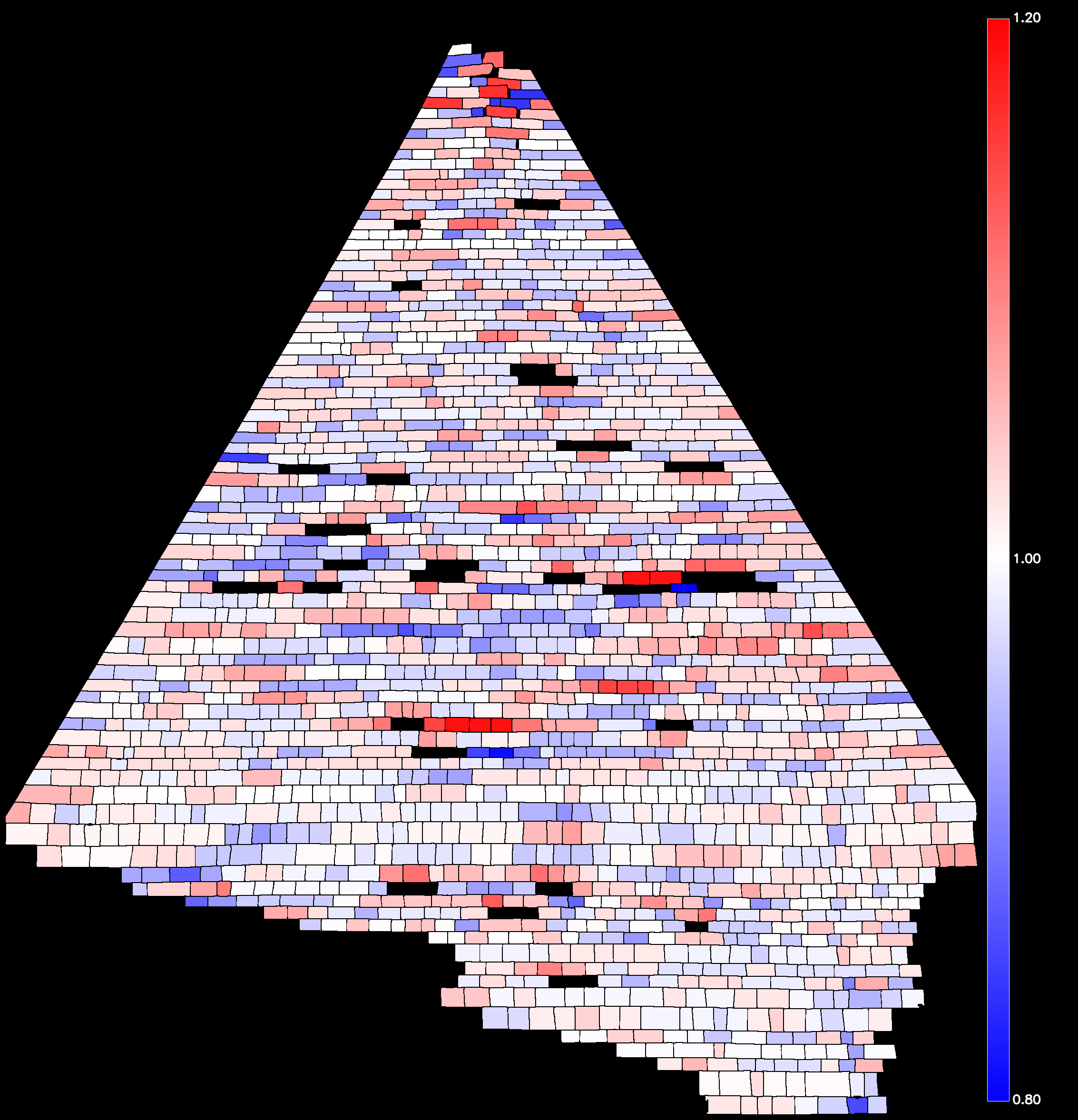
|
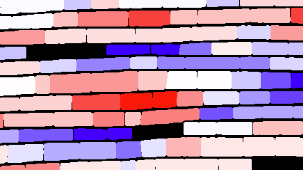
|
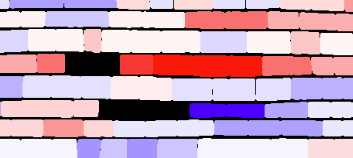
|
The height of the casing stones is maintained within a course around the faces of the pyramid (i.e., from north to east to south; see chart below), and the statistical distribution of the stones within each of these unified courses appears to be consistent. This suggests a singular source and quarrying directive supplying each unified course.
There appears to be a standard, or minimum, course height, which the builders calculated linearly based on the course (yellow highlight below). It makes sense for the size of stones used to decrease up the pyramid as the difficulty of transporting and manoeuvring the stones increases.
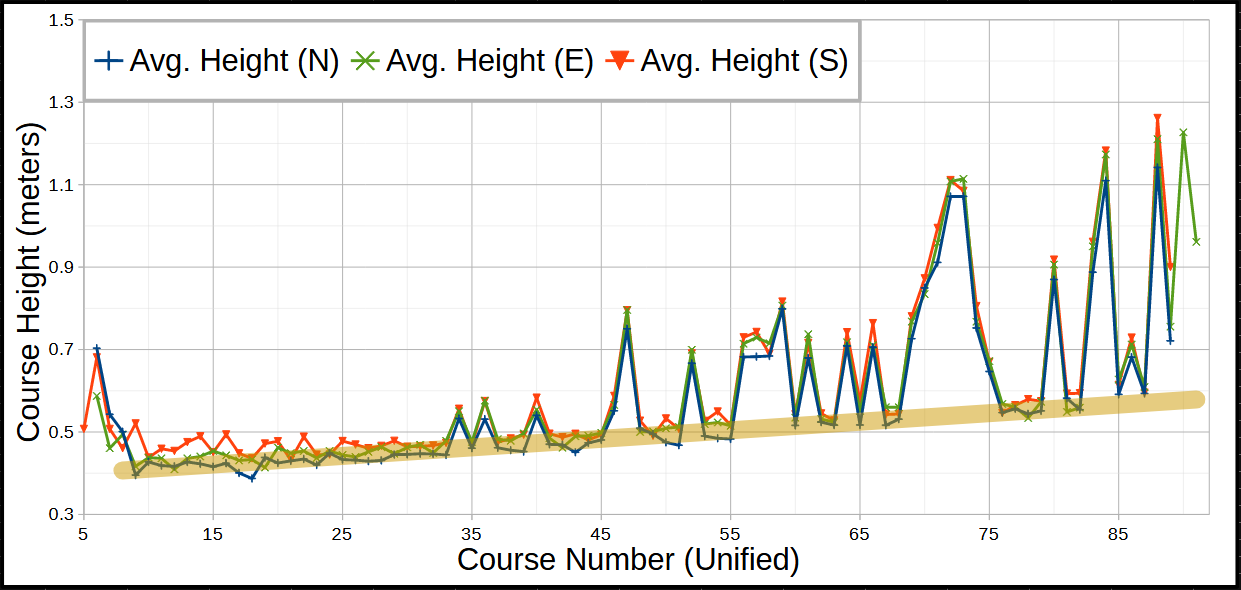
The region of the green arrow has a much more consistent distribution of average stone widths. This region (56+; note that the deviations at 85+ result from missing stones) does not align with any particularly defined region on the chart (above) of course heights.
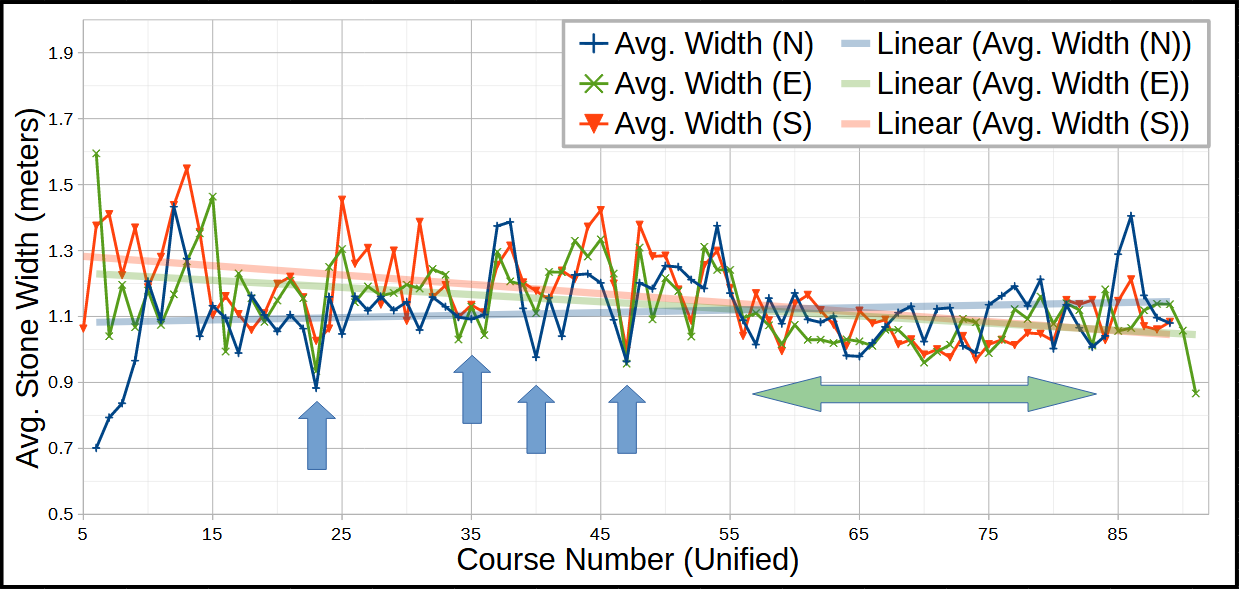
The right of the South Face joins with the left of the East Face. The angles between these two do not align, as the East is level while the South is angled clockwise. This suggests that at these upper levels, the southern courses are slightly higher than the corresponding eastern courses. Note also that the top left stones of the South Face, have slid to the left of their original positions.
North Face, East Face, South Face: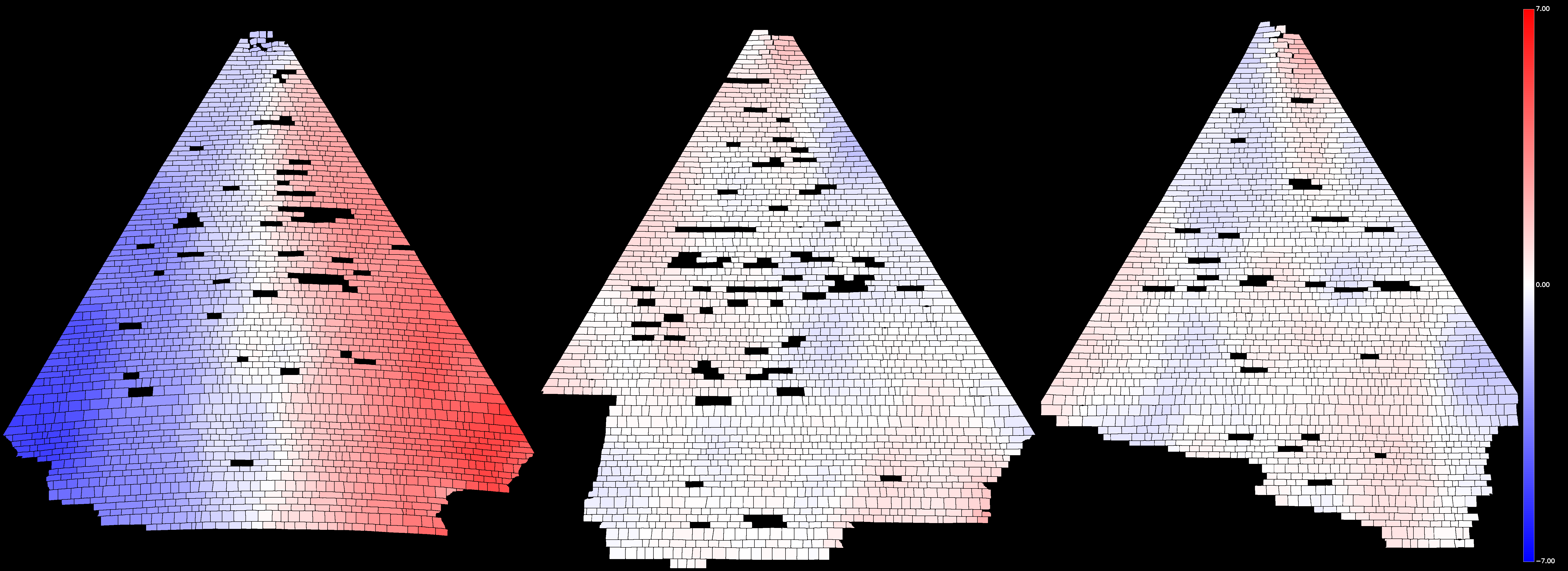
For more: Construction consistency, Similarity in stone widths across faces, Gaps at top of South Face, Distribution of course heights, Distribution of stone width by course, Height variation of stones within a course
Bulging in the North Face
There is possible upward deflection (bulging) of the courses on the North Face. By examining the expected vertical position of courses based on the height of casing stones, it is clear that the corners of the courses are in the correct position, and the centre is located higher up than it should be. This construction issue began below the current level of the casing stones and is not present on the other faces (I also visually inspected photos of the West Face and couldn't see any). It is hard to tell if this is just an artificact of the imaging processs (i.e., lens distortion) or actually present, but it does not appear in images of the other faces.
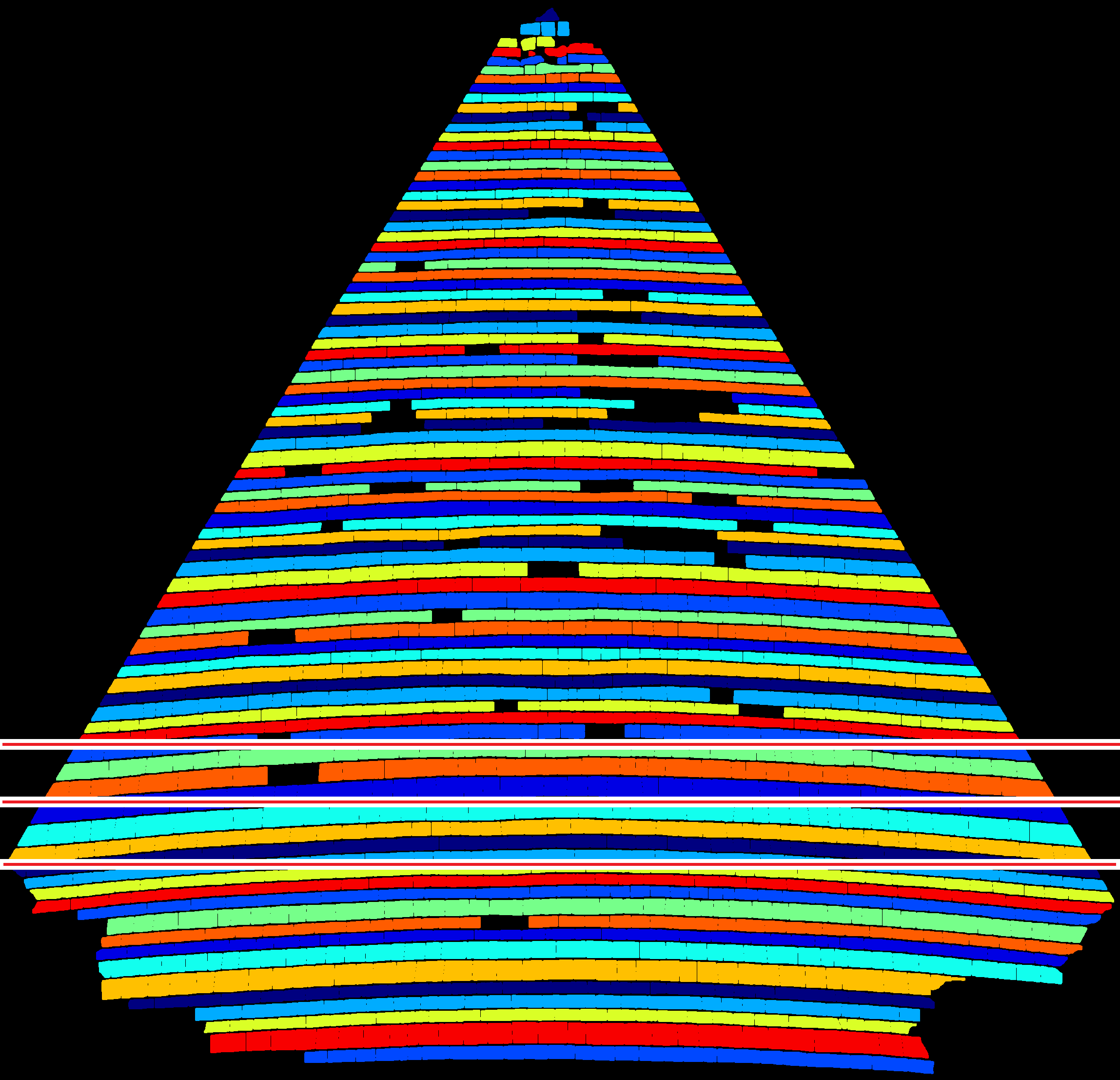
| Orientation of each stone | Local orientation around each stone |
|---|---|
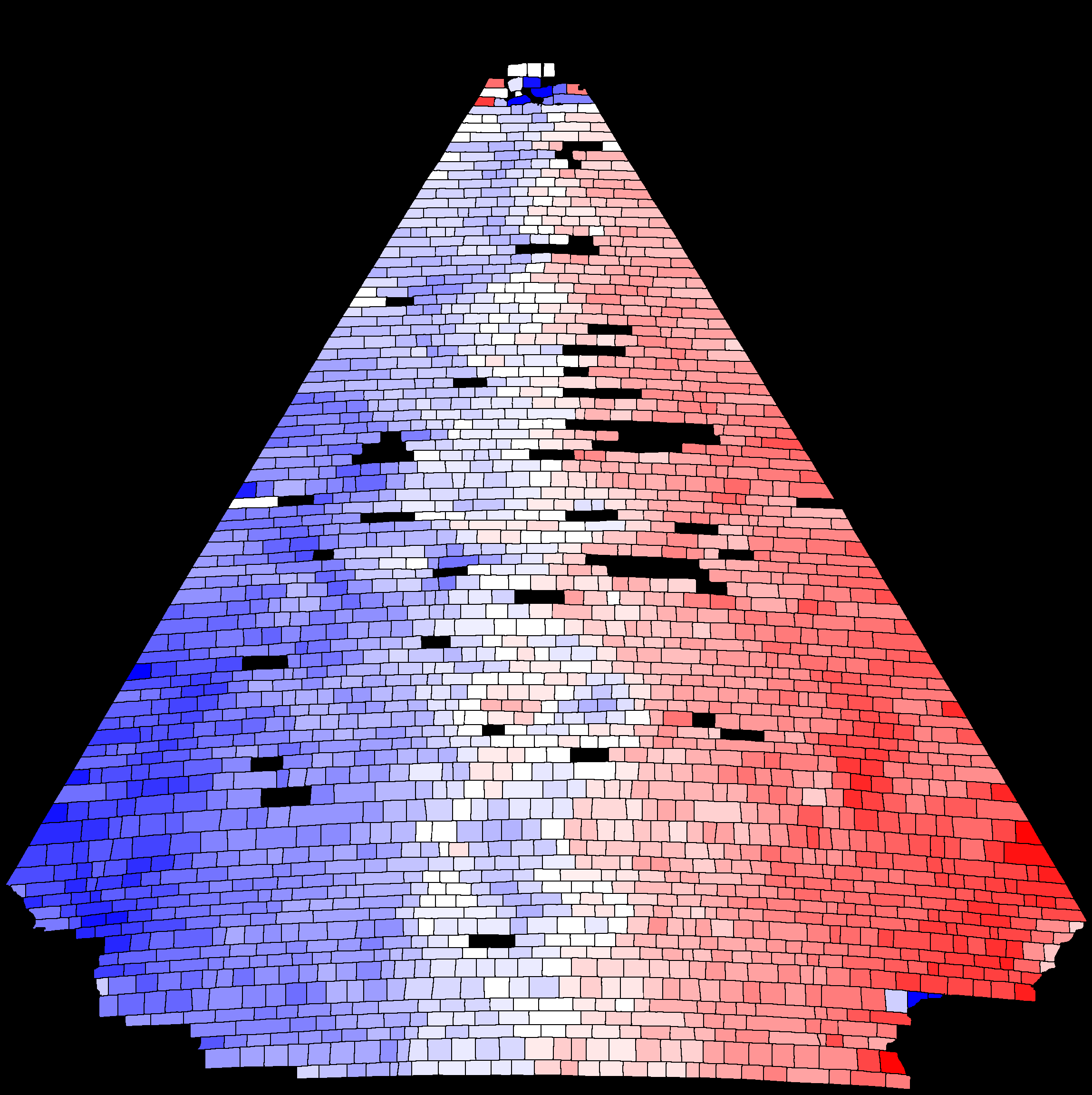
|
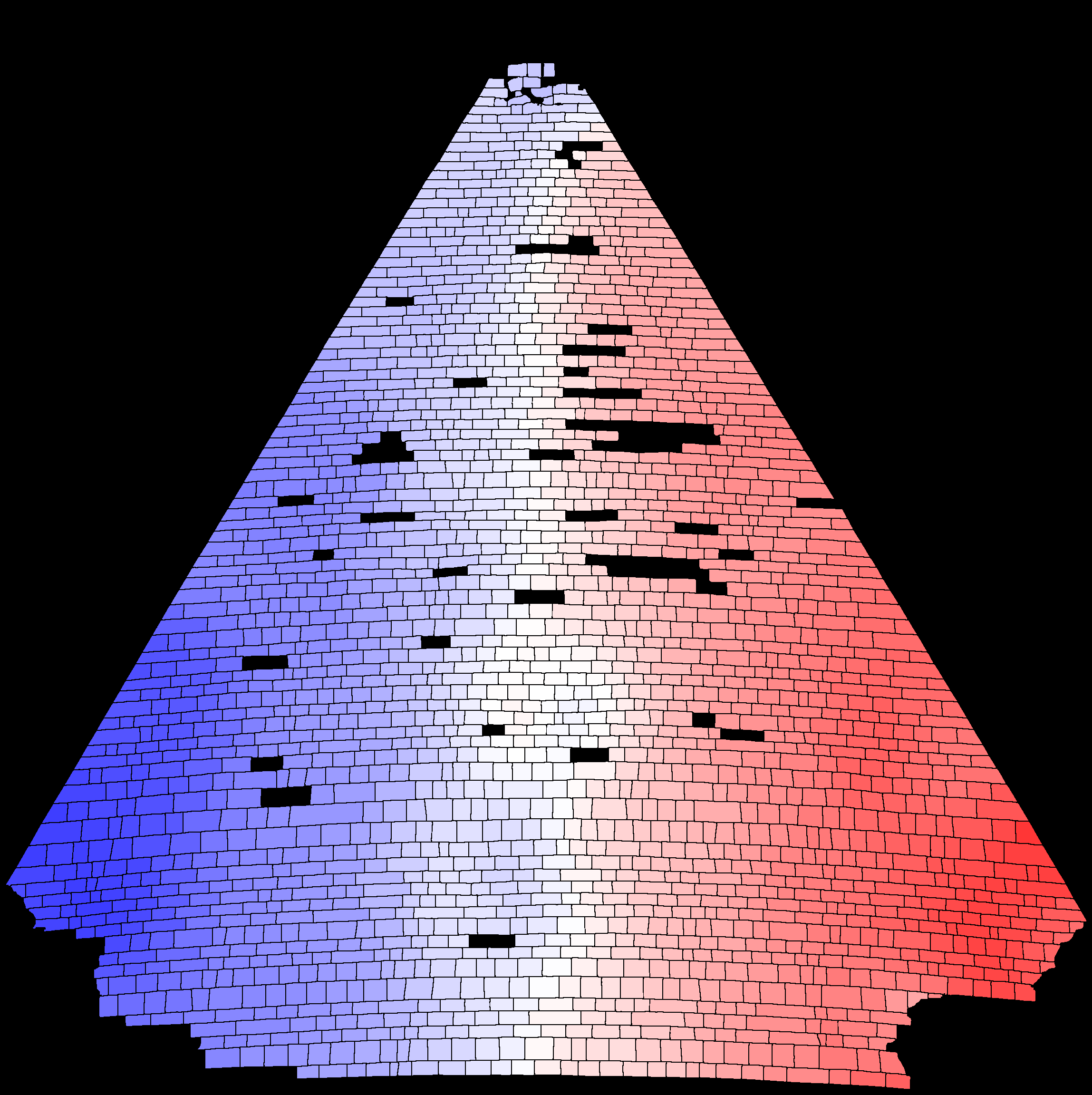
|
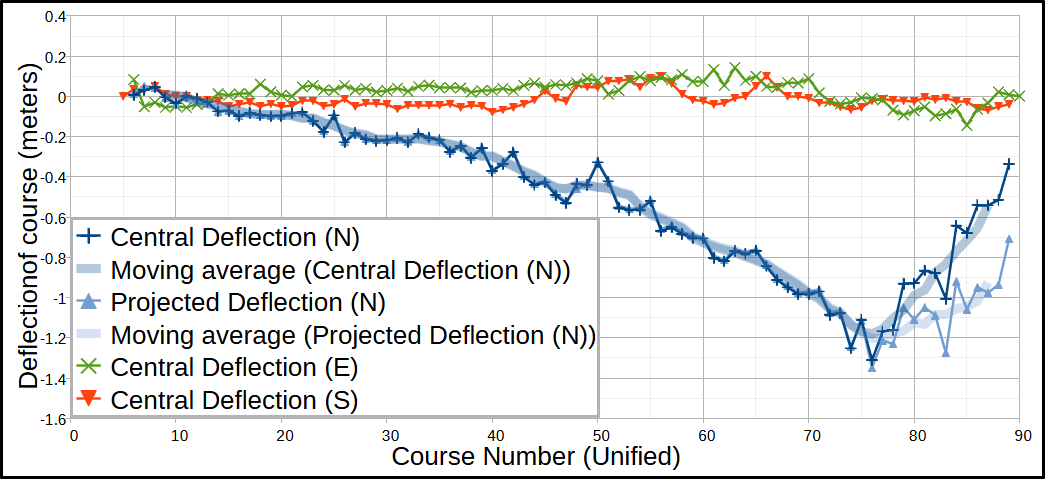
The above graph charts the deflection of the courses numerically. Note that below course 75 on the North Face, the courses are missing the outside casing stones. This obscurs the measurement as the current outer stones of the lower courses are higher than the original outer stones. The lighter blue on the graph shows the extrapolated deflection if there were no missing stones.
The deflection series for East and South show only minor amounts of deflection.
In the North Face, the upward deflection was increasing up until course 75, and it is likely that at this point the magnitude of the issue was recognised by the builders and a concerted effort was made to incrementally correct it.
For more: Bulging in the North Face, Vertical offset of stones relative to their course
Joining, or fitting, stones
As has been noted by the YouTube channel "History for Granite" in his video on the casing stones, there appear to be smaller stones whose purpose is to join sections of masonry that were built concurrently.
These smaller stones may be used to join regions of a course built by separate workcrews, as the distribution of these stones is consistent with the vertical partitioning of the face into sections of more even size.
By attempting to plot lines that separate the face into sections (below right), you can see a somewhat symmetrical pattern, suggesting there was some attempt by the builders to spread the workcrews evenly across the available space. The fact that these joining stones do not usually align in a neat pattern with the courses immediately adjacent above and below suggests that the horizontal courses were often constructed in full or independently before moving on to the next. In some places, such as the top right of the North Face, the alignment of this "join" gives the possibility that either the corner or centre region was constructed in multiple courses ahead of the other region. Comparitively, the chains of offset stones section suggests possible regions of building vertically ahead of horizontally or of aligning carefully from course to course.
| Smaller Stones (North) | Possible regions (North) |
|---|---|
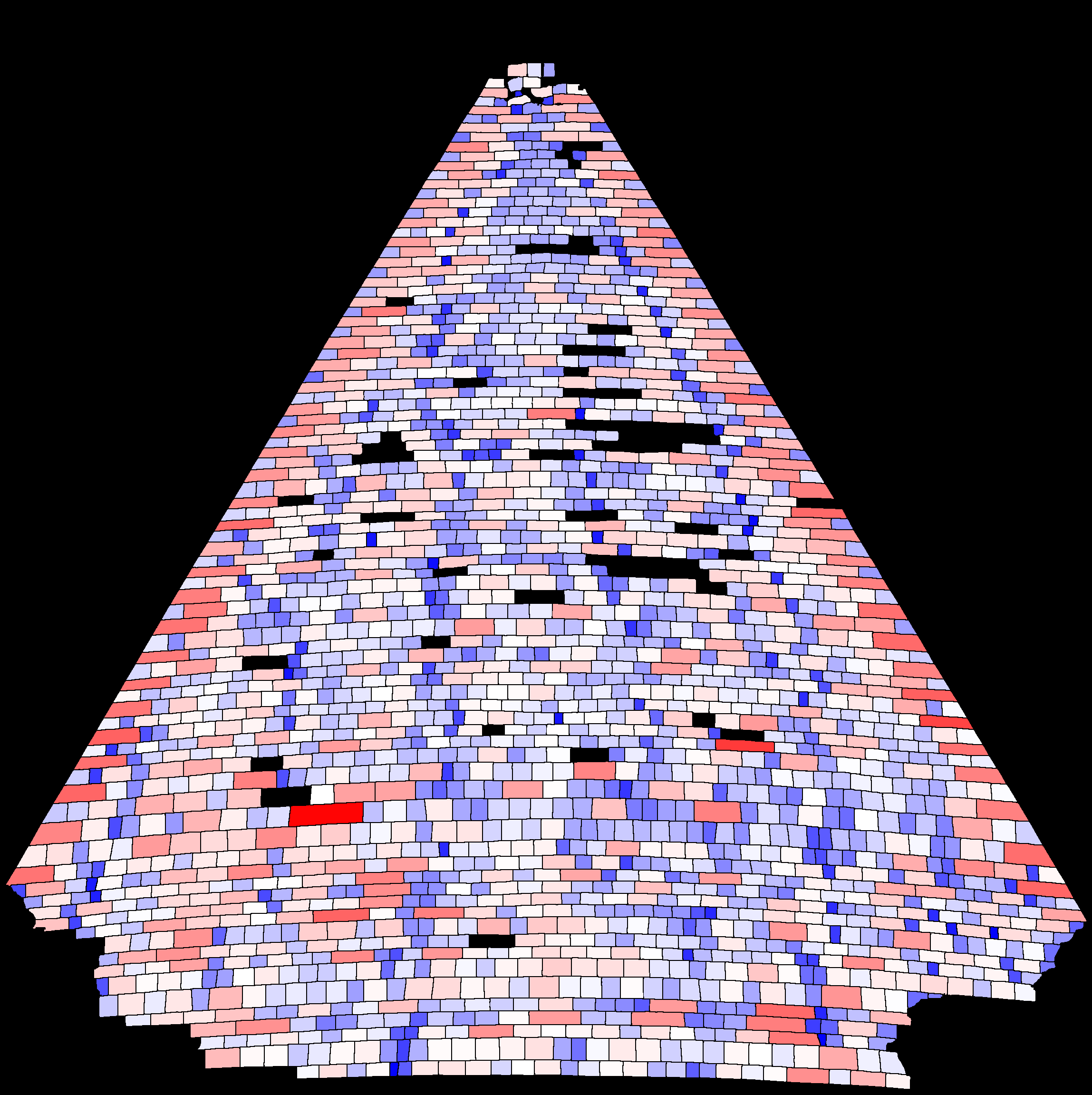
|
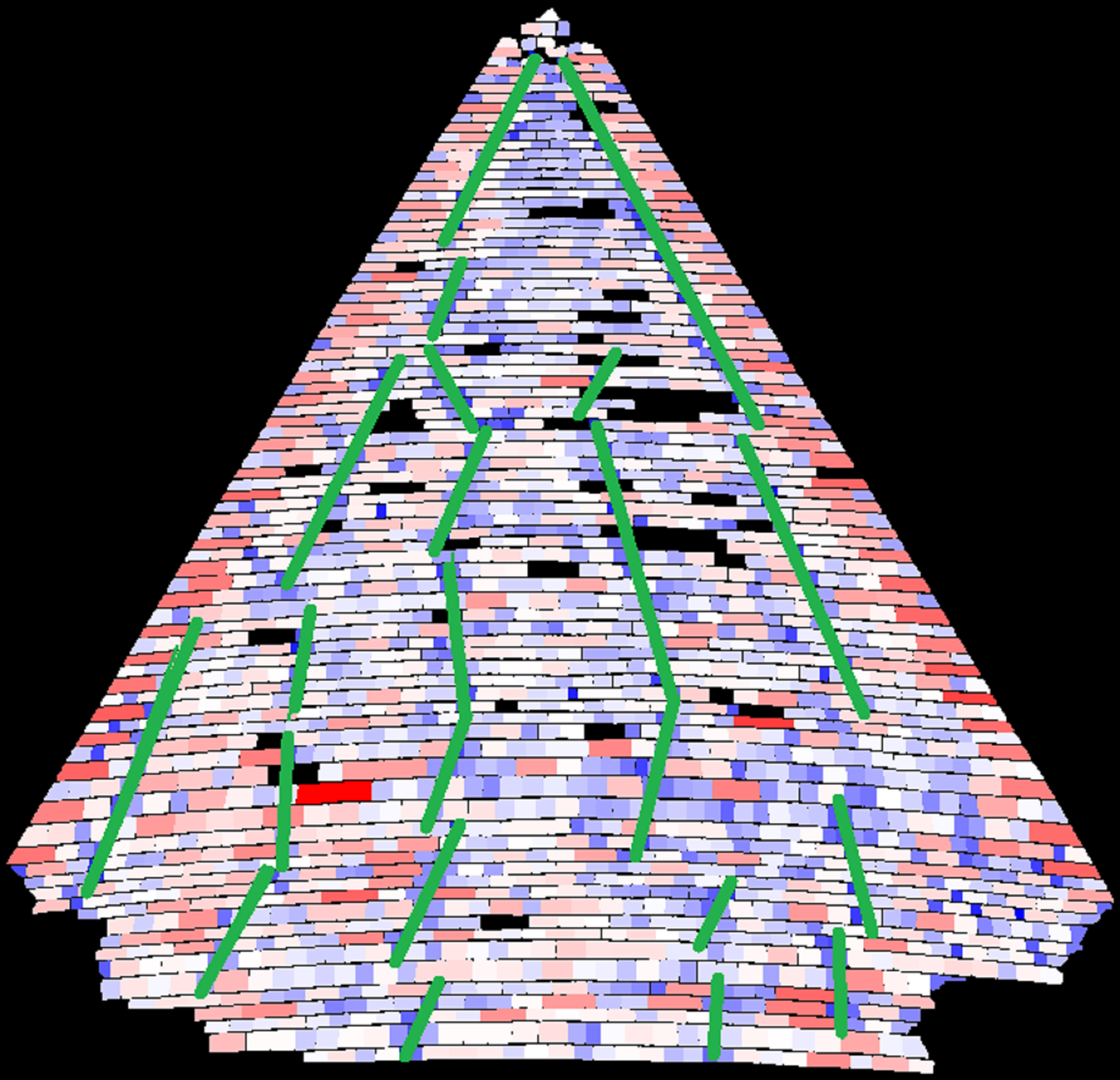
|
| Stone Width (East) | Stone Width (South) |
|---|---|
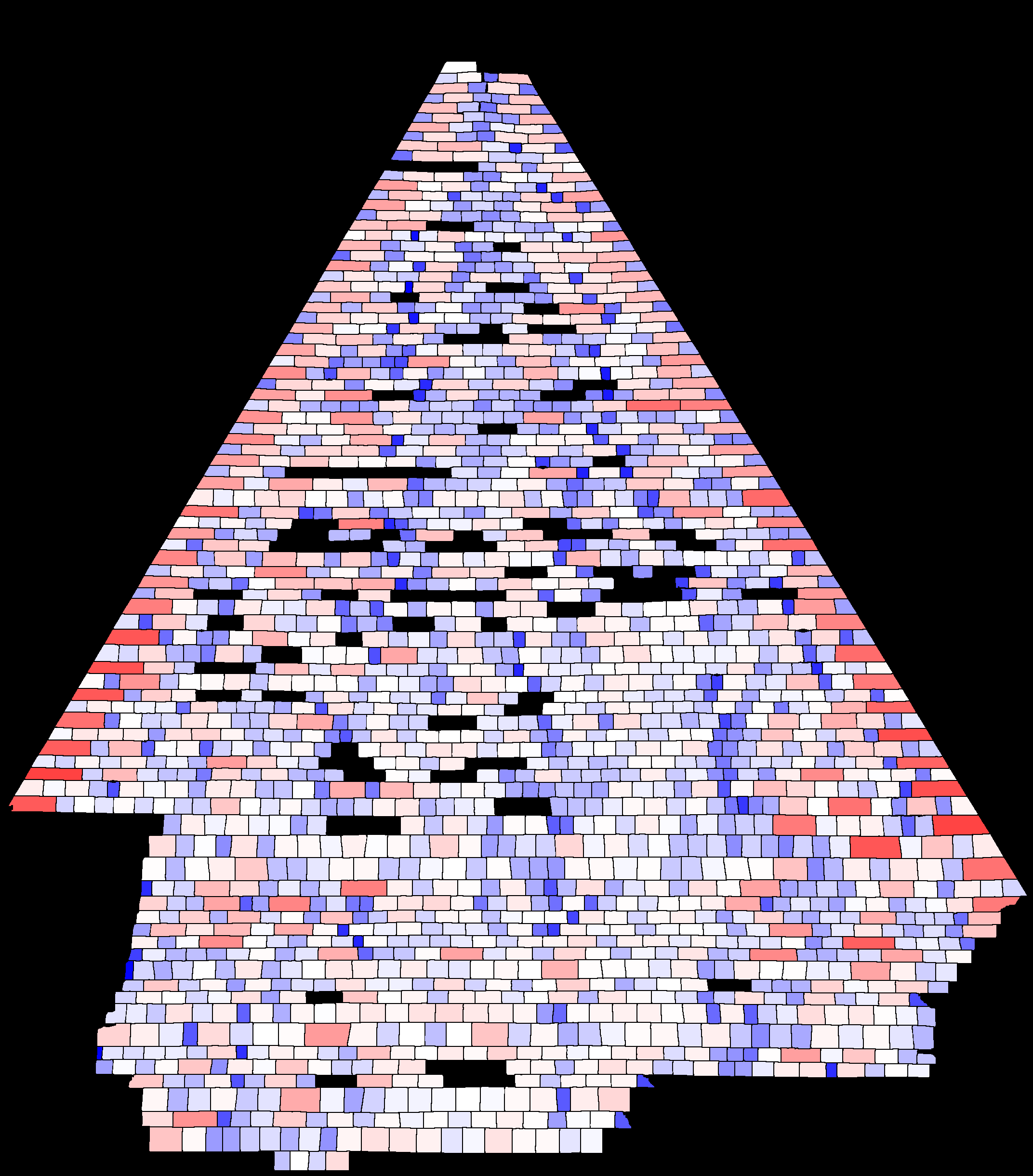
|

|
A closer look at several of these stones:
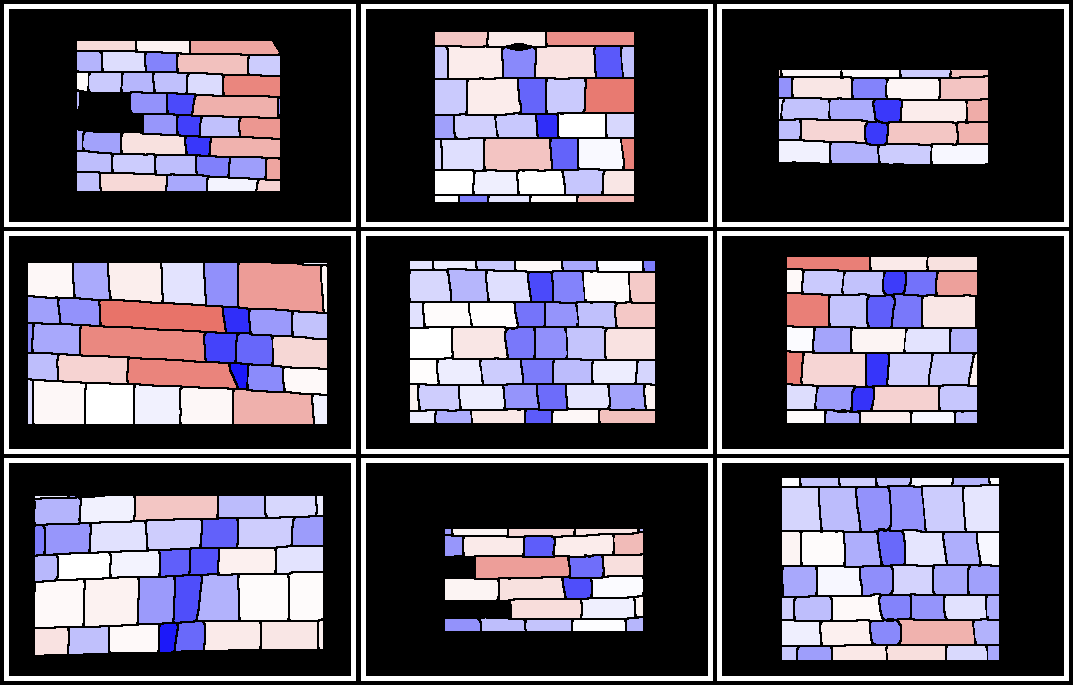
In comparison, just below this, the builders used two joining stones instead of just one (as seen in the area highlighted by the red box).
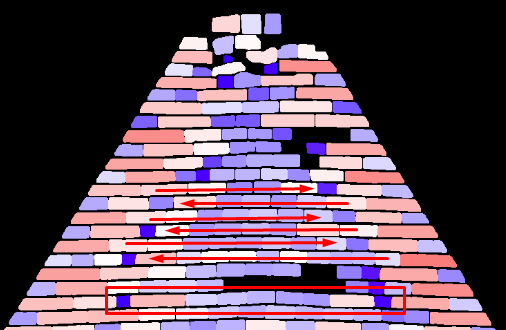
For more: Joining or fitting stones
Alternating corner pattern
The edges of each course follow a distinctive alternating pattern. A wide corner stone is then followed above by a narrower corner stone and a second (and sometimes third) stone that extends to overlap the first stone.
Zoomed image of North Face (left) and South Face (right). The North Face courses are from high up on the casing stones, and the South Face courses are from lower down.
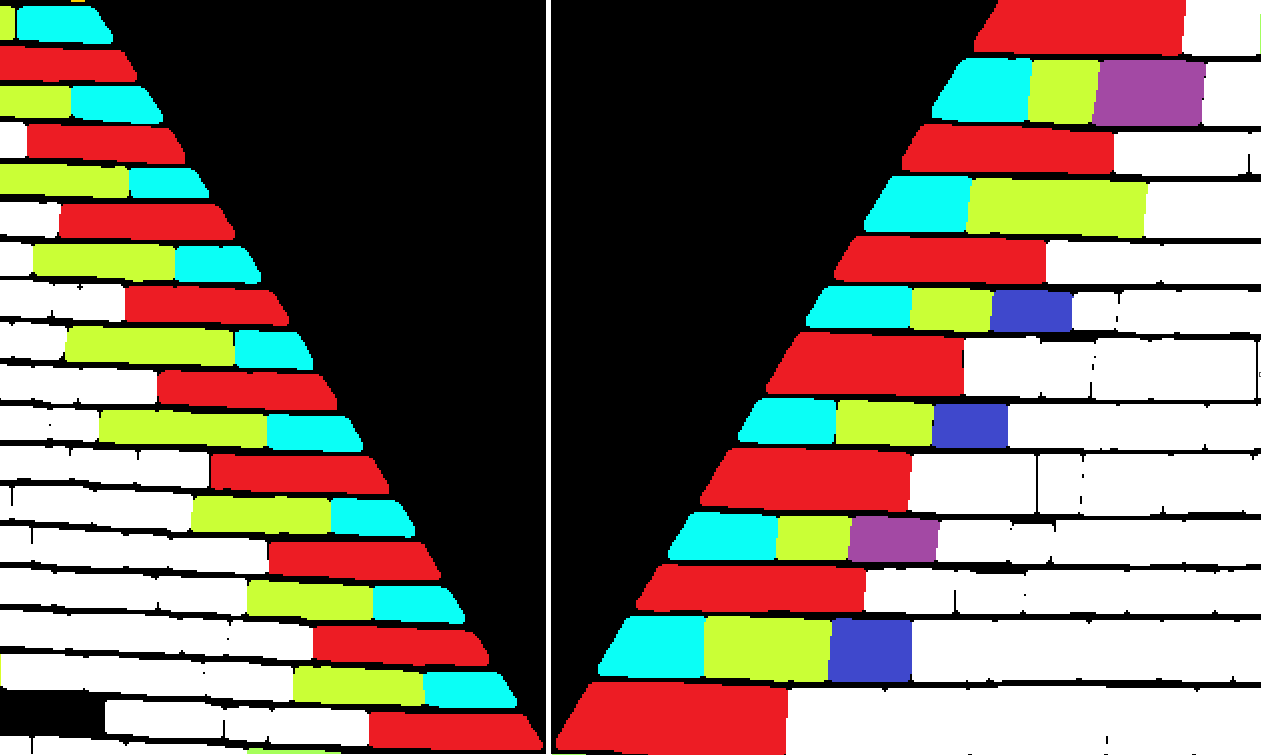
Around course 35 and below, there is a shift in the width of the corner stones. Both wide and narrow corner stones are wider on average below course 35, and the wide corner stones in particular are significantly wider. Conversely, the "1st Overlapping Stone" (in green above) is narrower in some sections further down the pyramid.
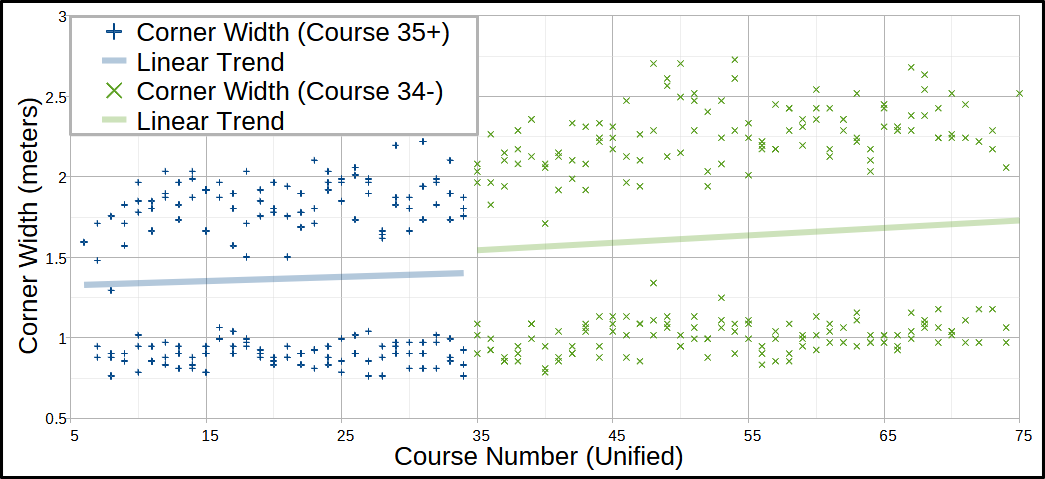
| Stone Width (North) | Stone Width (East) | Stone Width (South) |
|---|---|---|

|
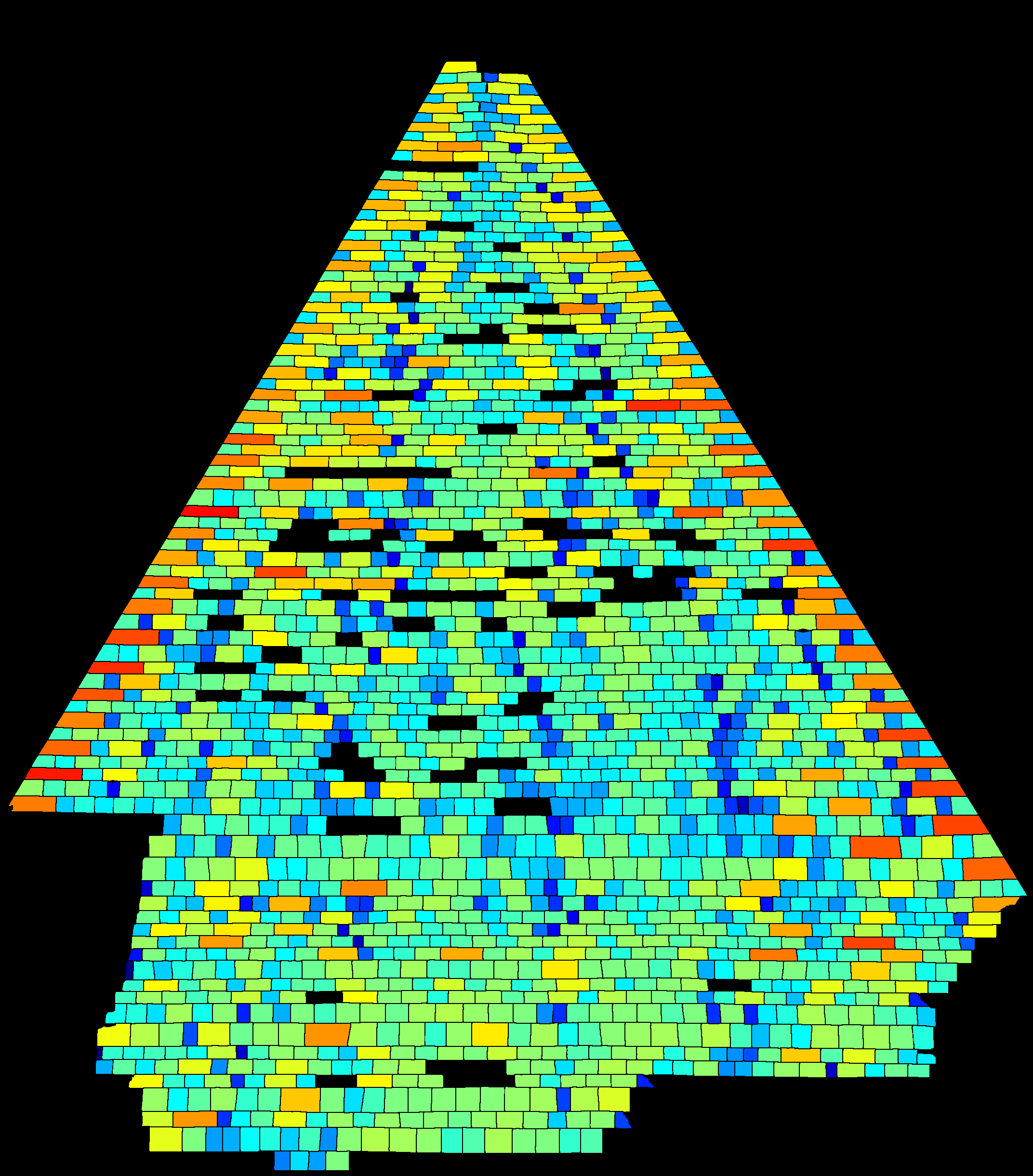
|
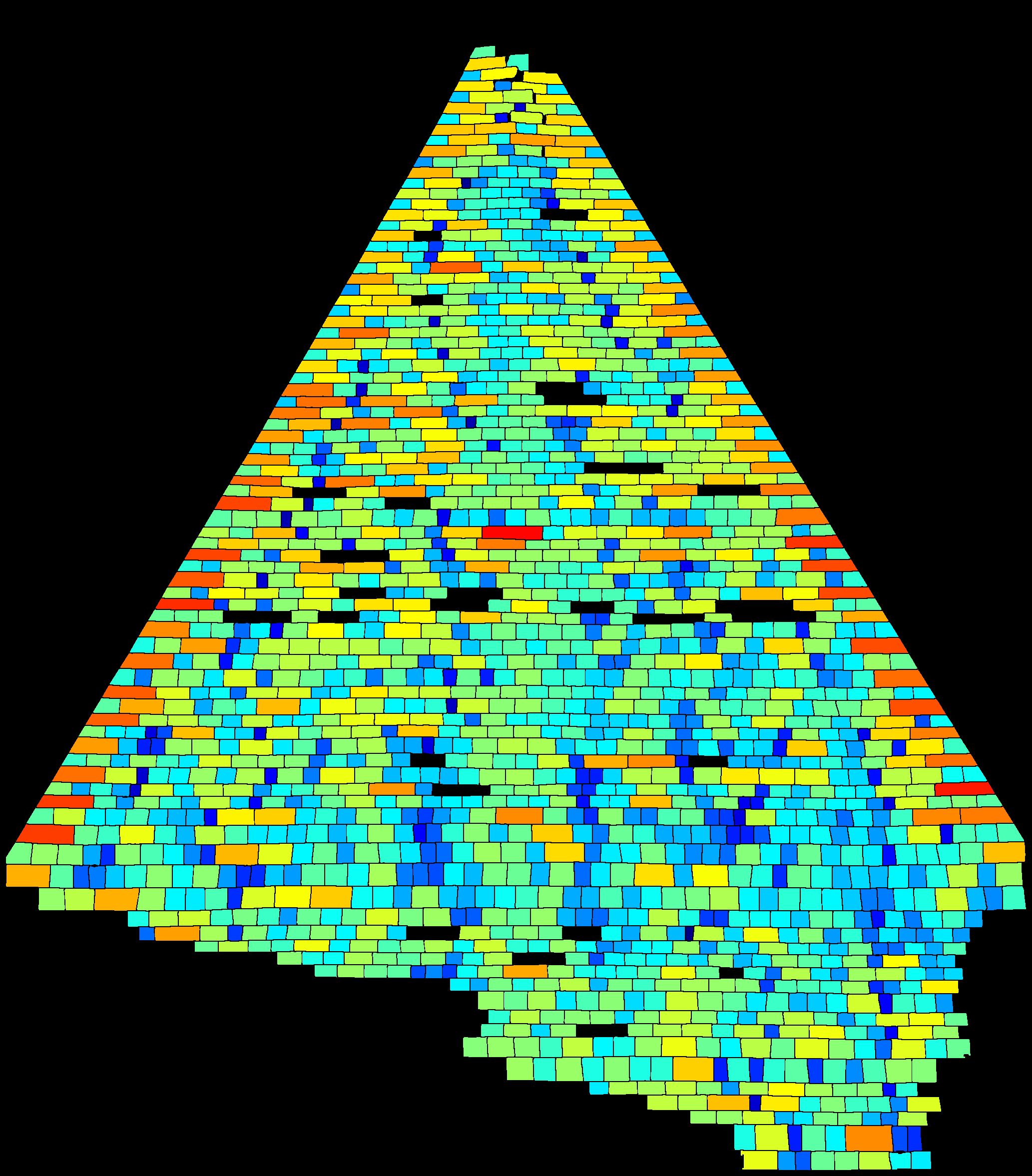
|
Note how the wide corner stones are a darker red or orange lower down and a lighter colour higher up, illustrating this shift in their width.
For more: Alternating corner pattern, Alignment of stones around corners, Change in the corner pattern
Angles on the vertical edges of stones
Overall, the left edges (of stones) are on average slightly clockwise rotated, and the right edges are slightly anti-clockwise rotated, which makes sense due to the strongly angled edges of the cornerstones. Without the cornerstones in the analysis, edge angles average out to be vertical.
When considering stones on the left half of the face versus those on the right, it can be seen that both vertical edges are slightly more likely to be angled in the same direction as the nearest edge of the face (by around 1.2°). This tendency for edges to be angled in the same direction as the pyramid edge is also exhibited on the corner stones' non-corner edge.
| Left Edge Angles | Right Edge Angles |
|---|---|
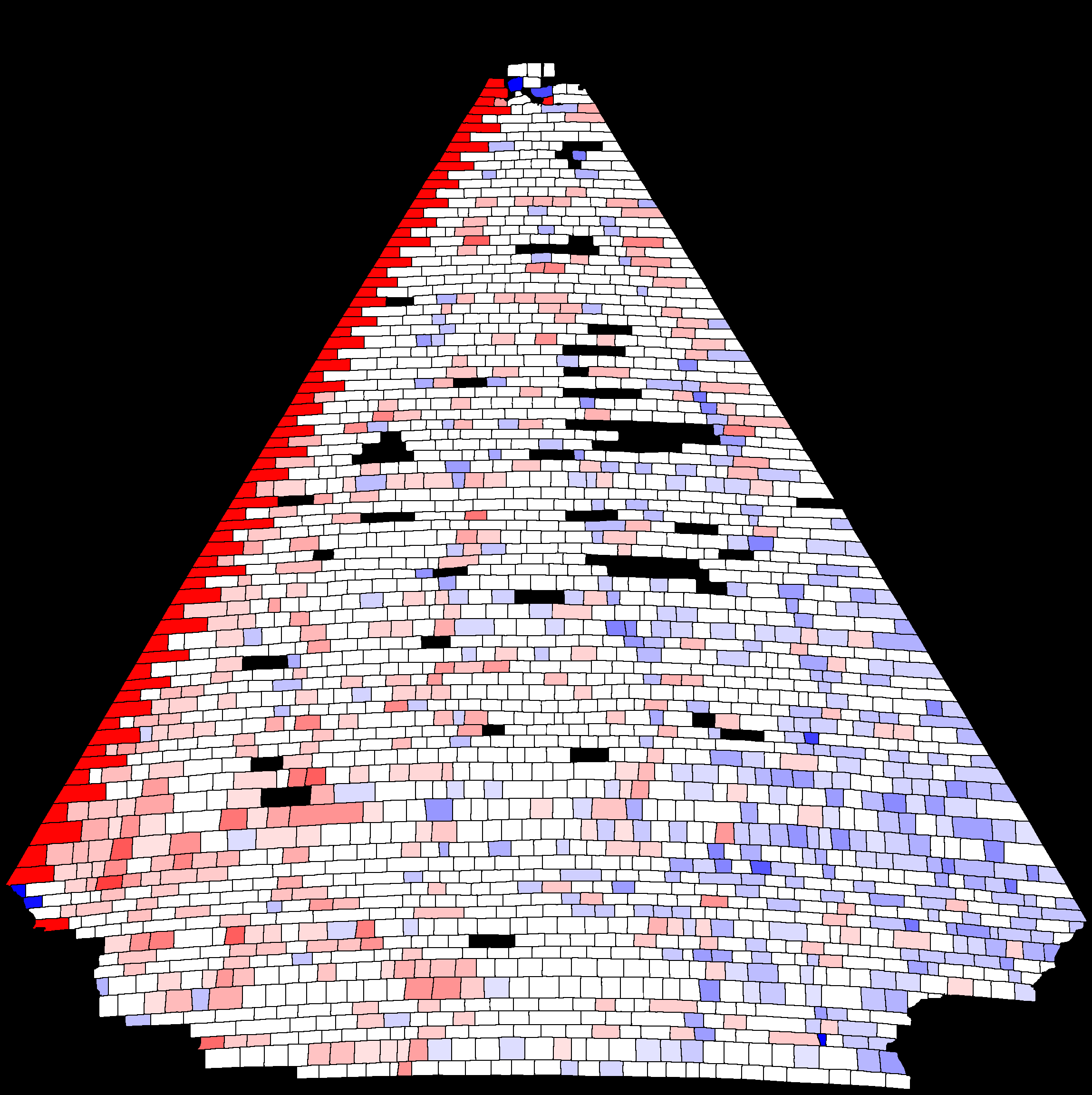
|
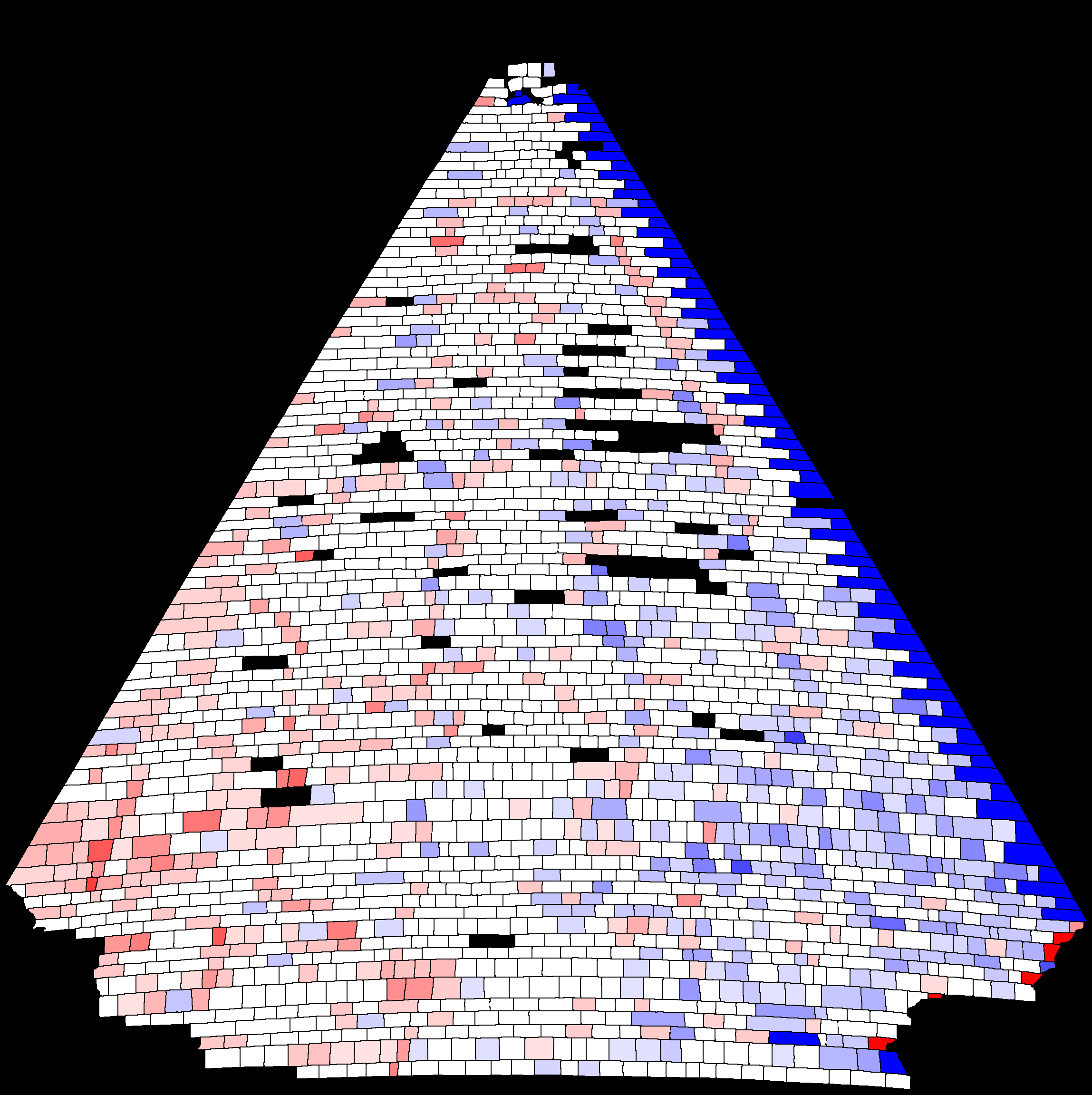
|
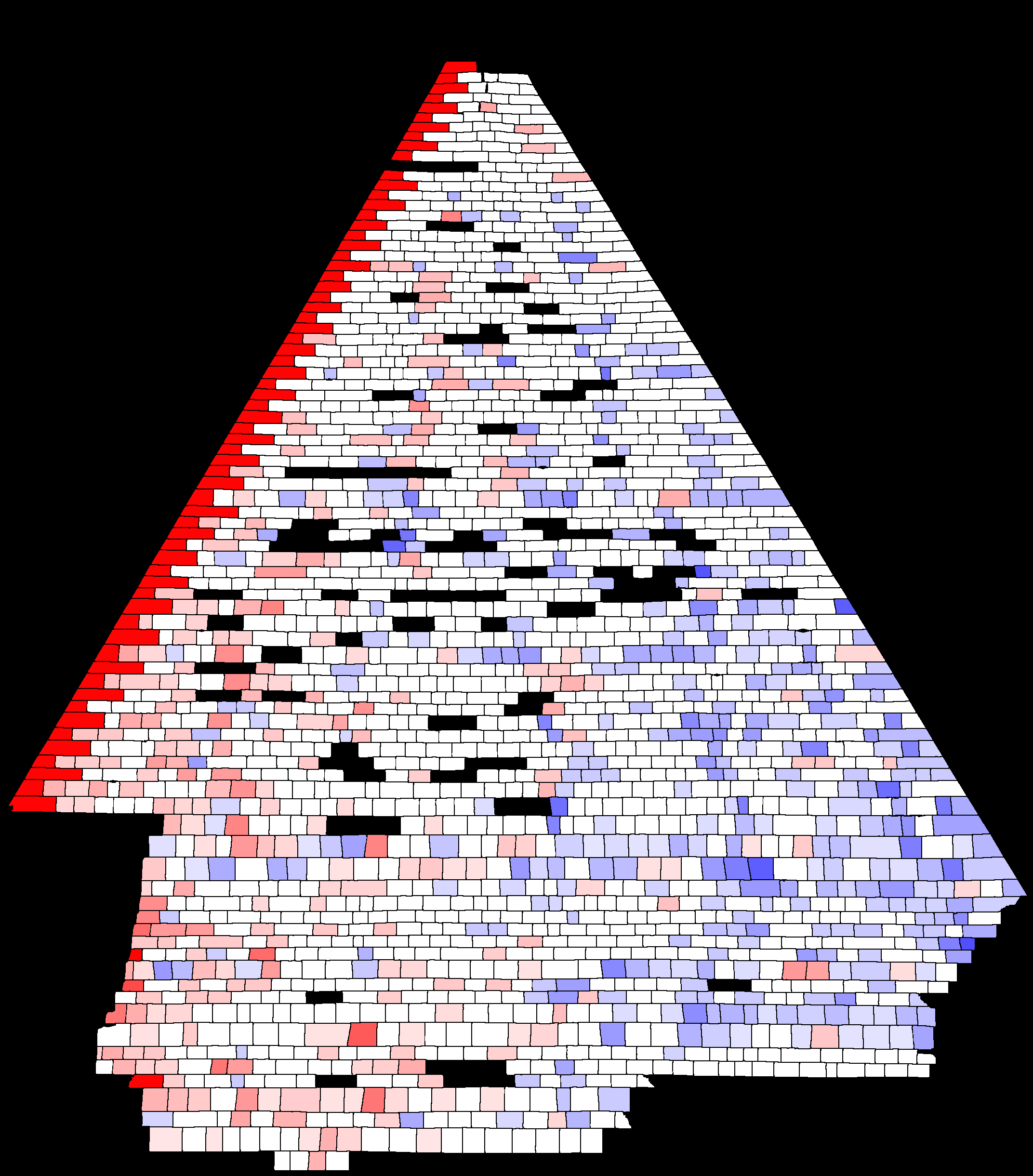
|
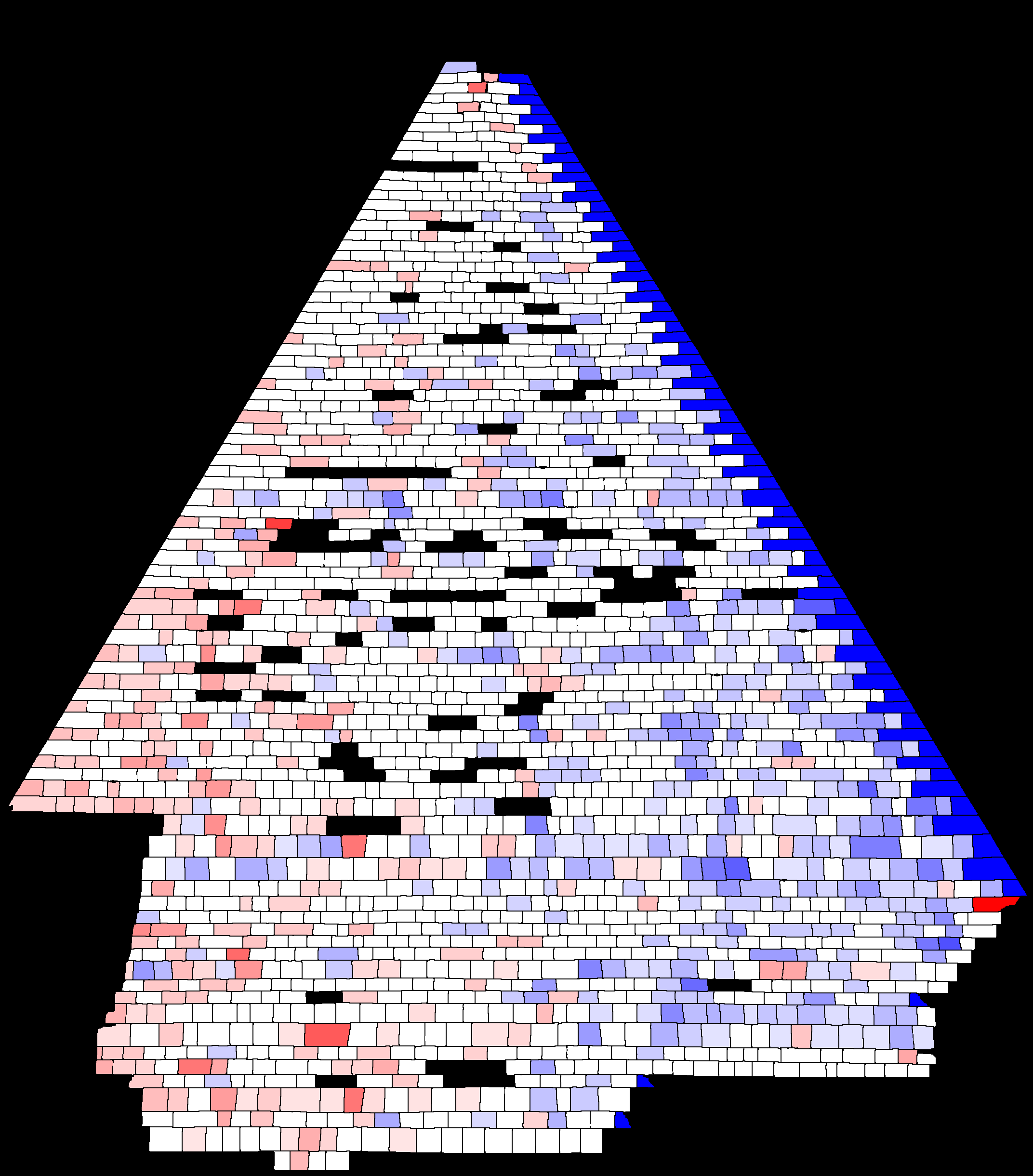
|
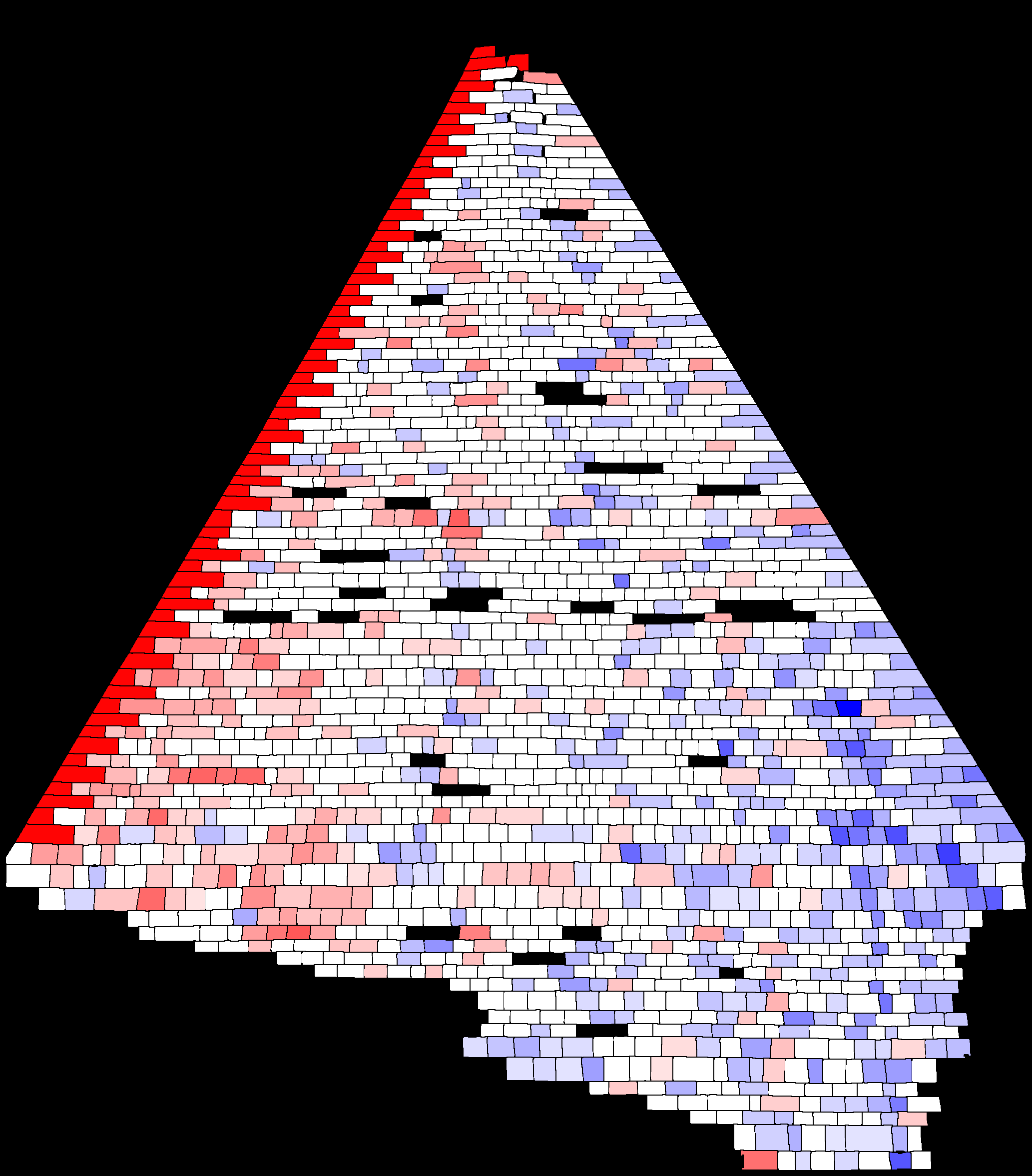
|
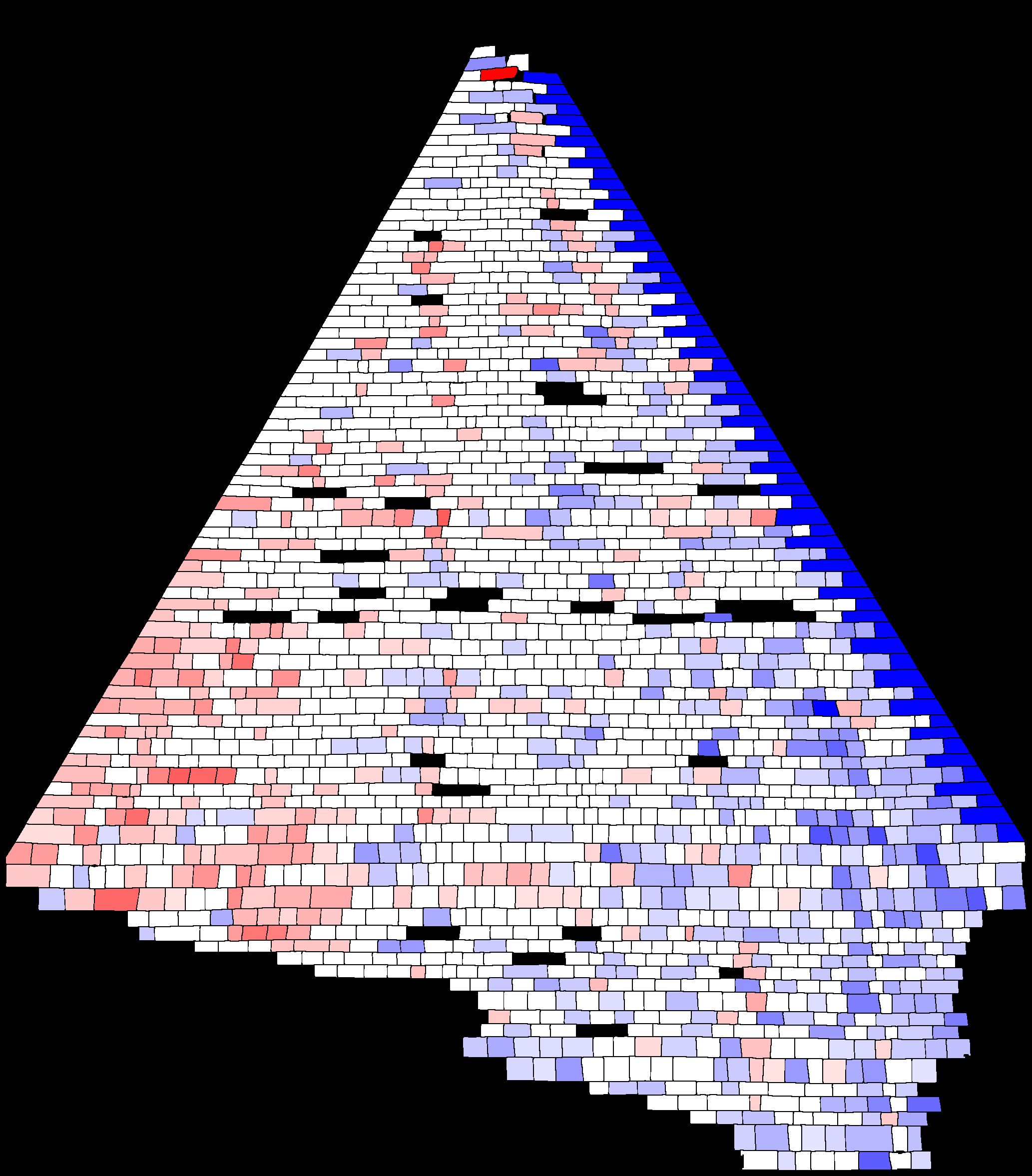
|
The above images show the clustering of clockwise angles (red) on the left half of the face and anticlockwise angles (blue) on the right half. This phenomenon is not random chance, but it seems too small to be a conscious effort by the builders. This leaves either an unintentional effect of the construction process or "external" causes such as slumping or earthquakes. If the (internal) central part of the pyramid was not solid enough, then the weight of the pyramid would have caused the greatest settling in the centre, gradually as weight was piled up on the pyramid. Even if the builders accounted for this issue by re-levelling each course as they went, it could leave these angular defects.
For more: Angles of stone’s vertical edges, Angles on corner stones, Vertical edge angle distribution by size of stone
Chains of offset stones
There are "chains" of stones, wherein each stone in the chain is offset from the previous by a set amount, and the sizes of the stones in the chain are either similar or decrease slowly as you go up courses. The number of chains occurring suggests these aren't random chance, and are somehow related to the construction strategy of the casing stones.
Below, some examples from North (left), East (middle), and South (right) Faces:

For more: Chains of offset stones
Overview and Comparison of Faces
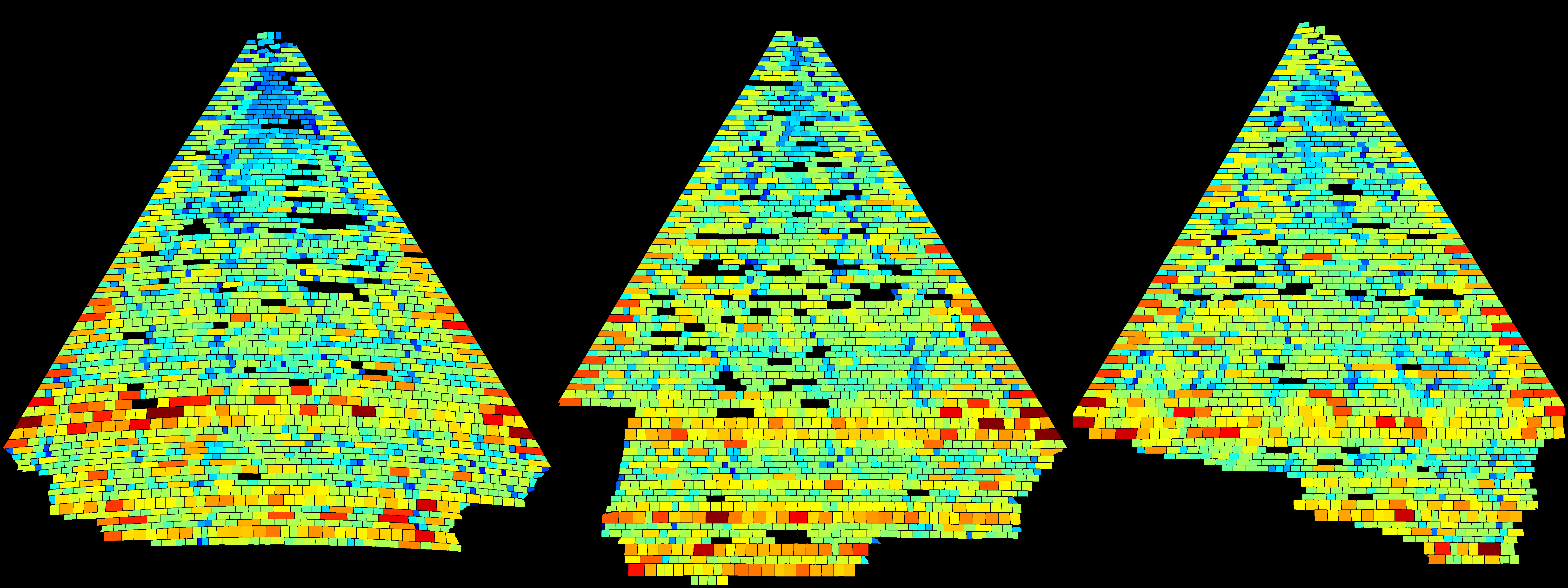
| Statistic | North | East | South |
|---|---|---|---|
| Angle of left pyramid edge (clockwise, from hor.) | 59.0° | 59.4° | 59.5° |
| Angle of right pyramid edge (anticlockwise, from hor.) | 58.8° | 58.6° | 58.6° |
| Percent of stones missing | 12.64% | 17.15% | 15.69% |
| Courses (incl. partial) remaining | 83 | 85 | 84 |
| Stones | 2003 | 1876 | 1724 |
| Avg. stone width | 1.11m | 1.10m | 1.12m |
| Avg. stone height | 0.63m | 0.66m | 0.65m |
| Avg. stone area | 0.73m² | 0.75m² | 0.76m² |
| Widest stone | 3.54m | 2.70m | 2.77m |
| Tallest stone | 1.17m | 1.28m | 1.31m |
| Largest stone | 3.77m² | 2.68m² | 2.81m² |
| Avg. absolute edge angle | 2.10° | 1.97° | 2.09° |
| Skew of edges towards nearest pyramid edge angle | 1.15° | 1.28° | 1.26° |
North Face
Look through the images of this face coloured by various properties
East Face
Look through the images of this face coloured by various properties
South Face
Look through the images of this face coloured by various properties
West Face
It is hard to take good photos of the West Face. This is because the areas where it would be good to stand are restricted. The best I could find was this photo by Aidan McRae Thomson.
Because of this, there was no line drawing for this face, and so I did not analyse the casing stones on the West.
The left face in the linked photo is the West Face, and it can be seen that it is more badly damaged and missing more casing stones than the other faces. If you plot some straight lines across it, you can see that it doesn't appear to be "bulging" like the North Face.
Data and Methodology
Explanation of data and methods
I started from some hand-traced line drawings of the casing stones, made by "History for Granite" and found in this youtube video. I did some cleaning and editing of these images before using them in this analysis.
I mainly used OpenCV to do the image processing.
| Face (South) | Line Drawing | Courses overlaid on photo |
|---|---|---|
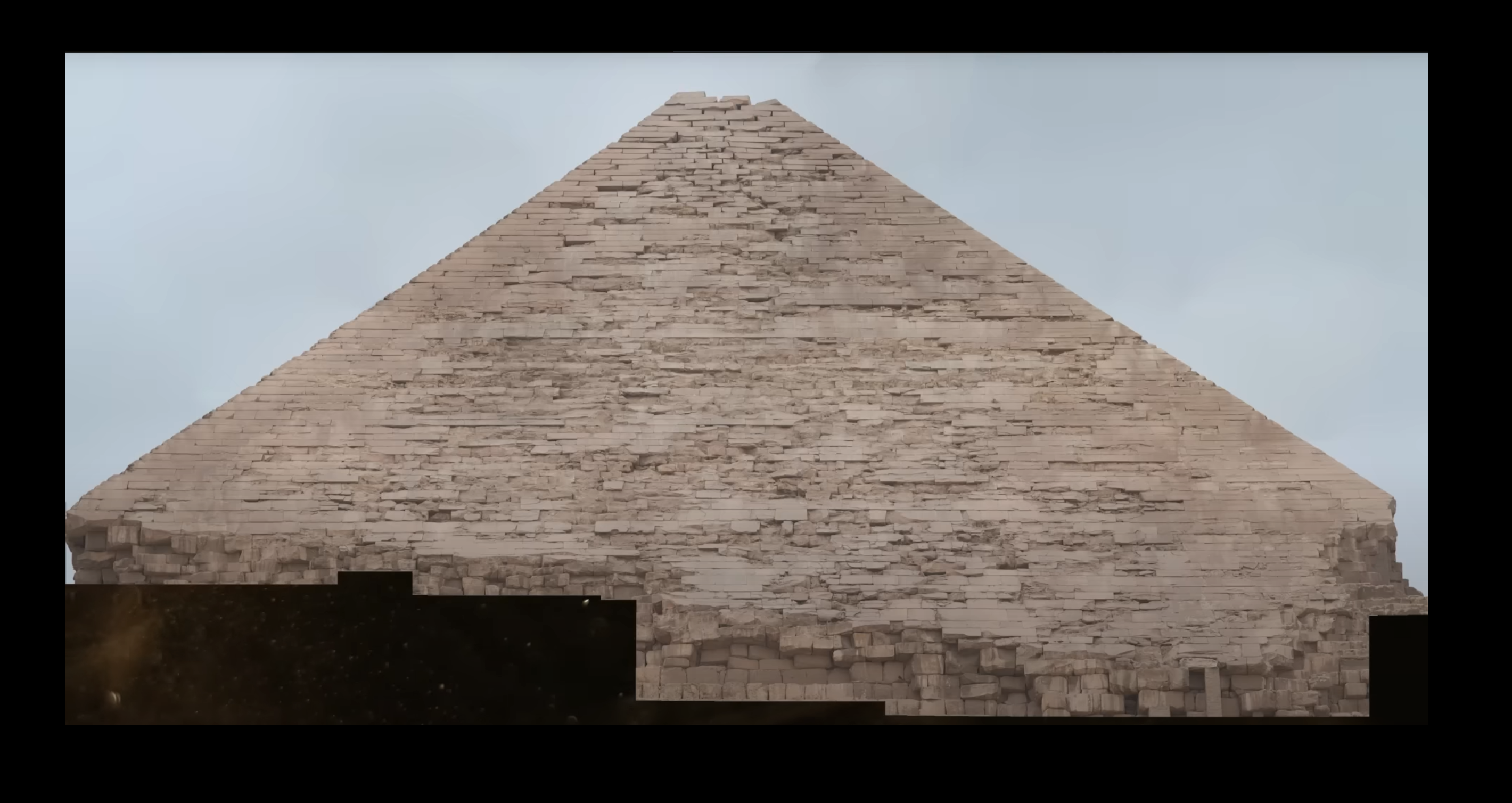
|
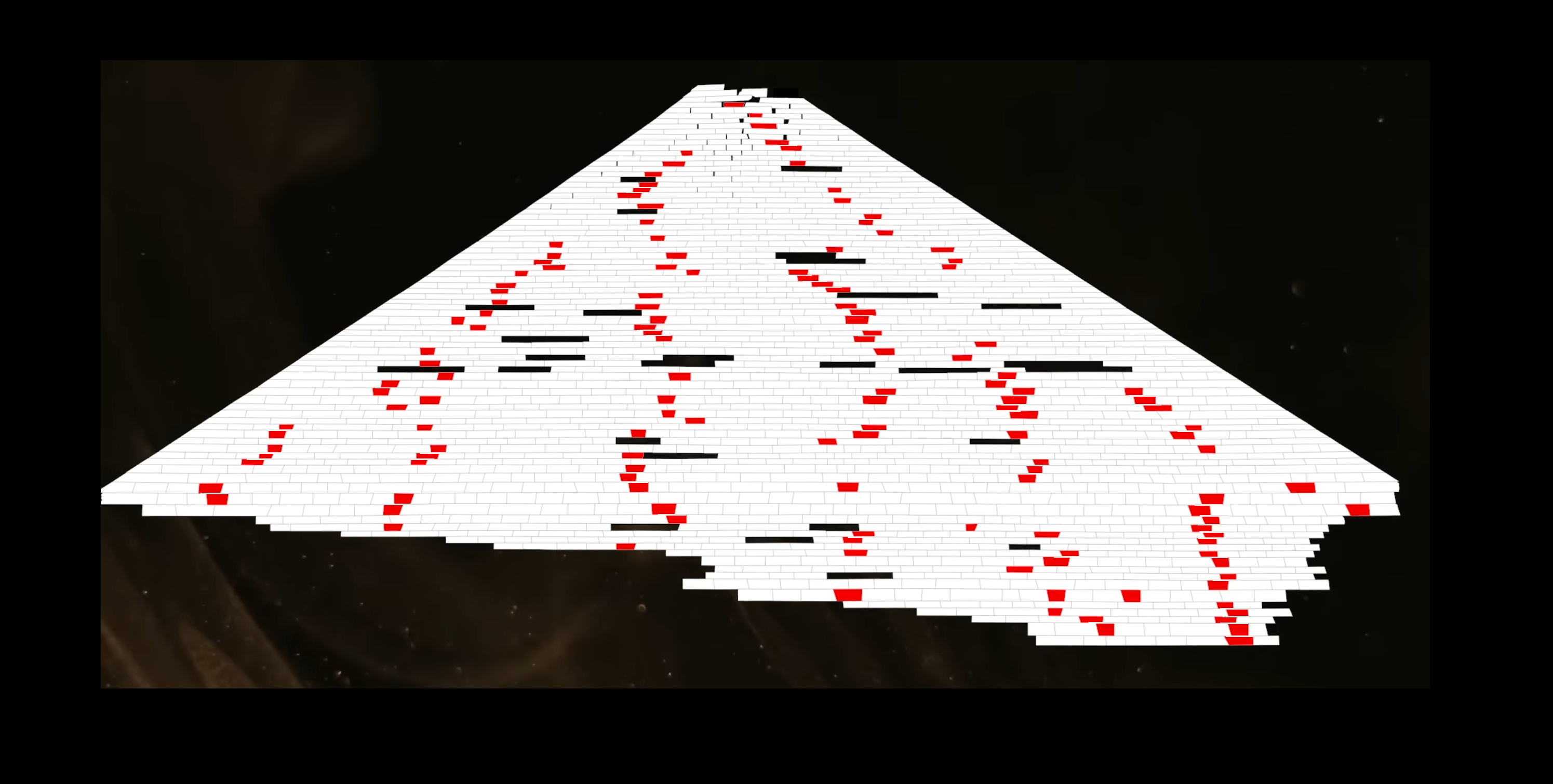
|
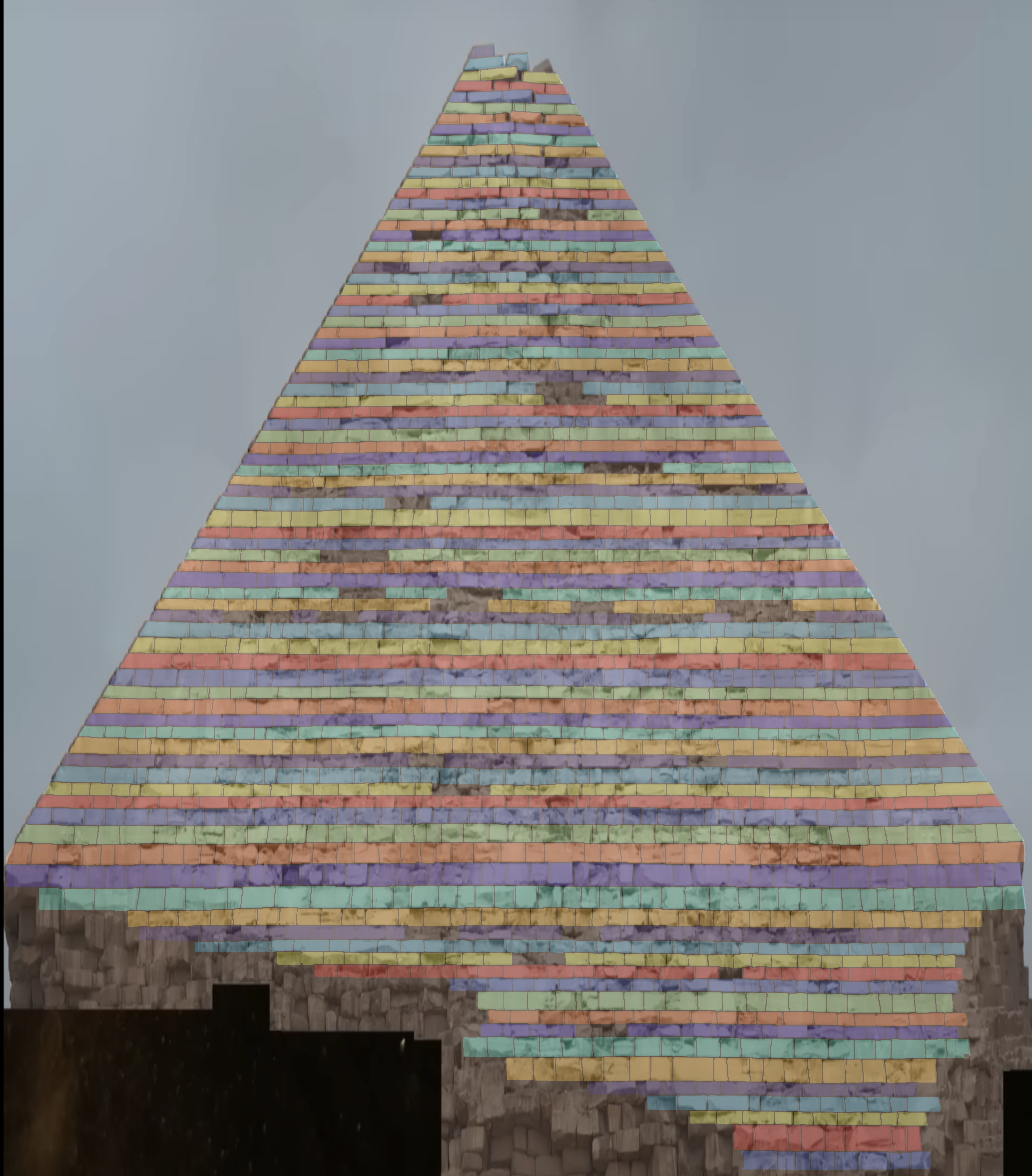
|
Image scaling and pyramid dimensions
| Internal Dimensions | Pyramid Face Dimensions |
|---|---|
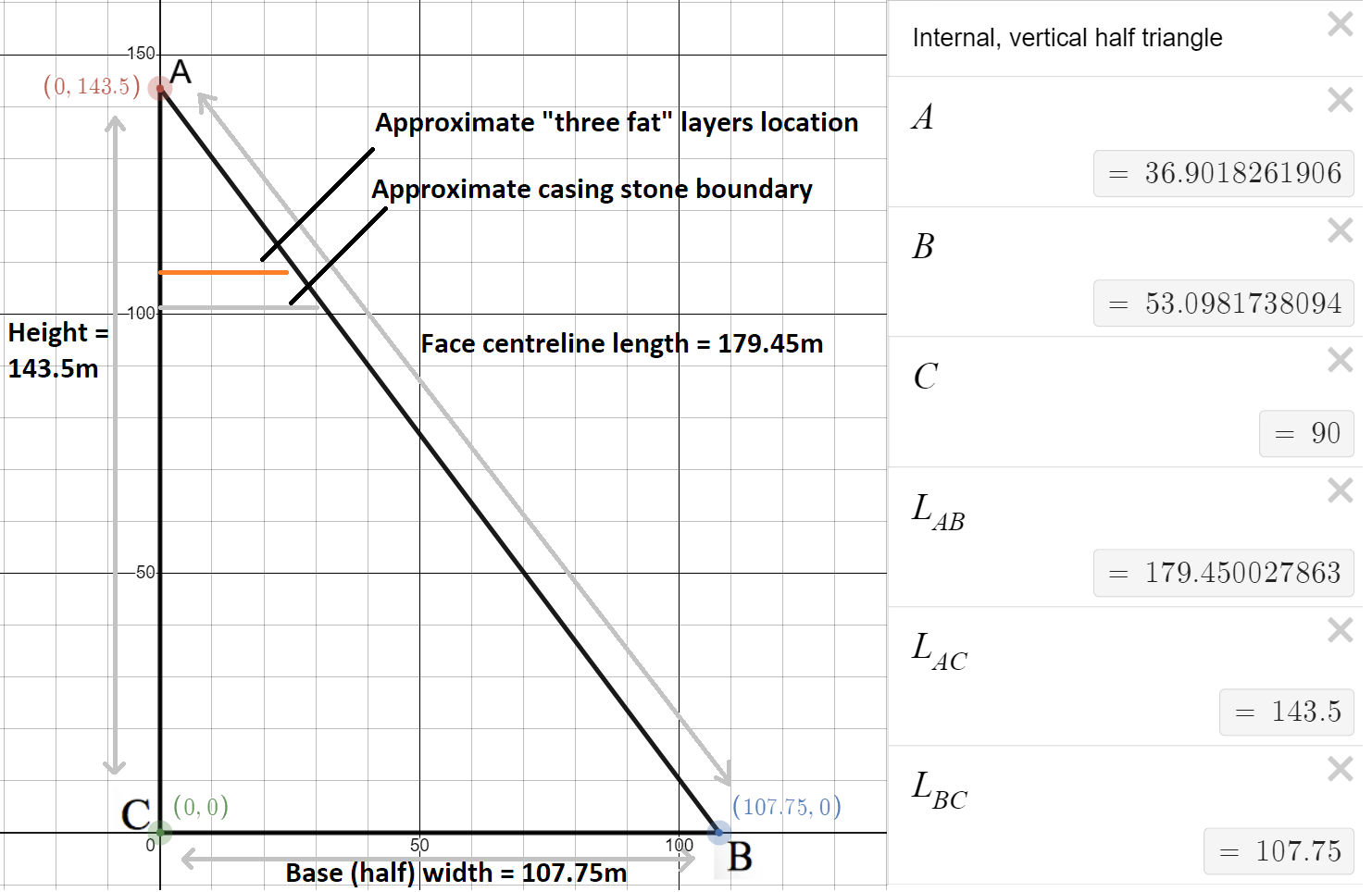
|
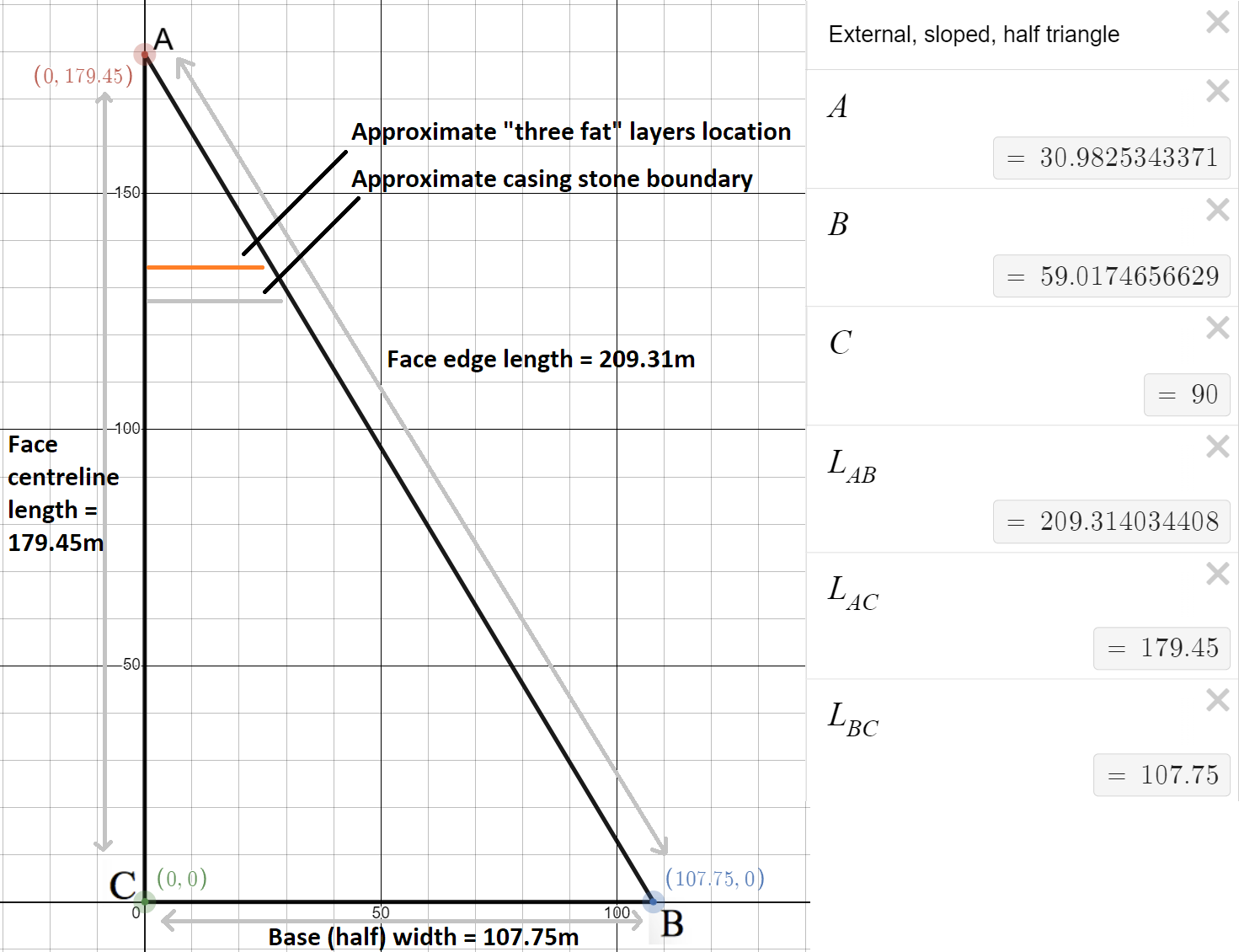
|
The original height of the pyramid was 143.5m. The angle between the face and the horizontal is approximately 53.15°, with different sources providing slightly different exact numbers. If you calculate the length along the centerline of a face of the pyramid, up to the apex, you get 179.45m (from the base length and the vertical height). The ratio of these two lengths is 1:1.25, or 0.8:1. This seems like a good, simple ratio (4 to 5) for the pyramid builders to use, so I used this ratio (approx. 53.13°) when scaling the image data I had.
I used the three tall consecutive courses (courses 71-73) of casing stones as an anchor for scaling the images. From visual inspection, the casing stones make up the top 28-30% of the pyramid height, and the three tall courses occur approximately 75% down the casing stones. This puts the three tall courses approx. 39m below the apex, as measured along the angled face, and approx. 31.2m vertically below the apex. The width of the casing stone courses at this point is approximately 46.9m. Note that the effective angle of the edge of the face itself, when measured in the plane of the face, is 59°.
Tabulated Statistics
There is a google sheets containing various statistics: https://docs.google.com/spreadsheets/d/1fJP4EgconIiQgJAgQUeqYThKv-u102JNS3uvlto_l2Y/edit?usp=sharing
Please note that this data had not been cleaned up for presentation.
All Observations
General
- Construction consistency
- Bulging in the North Face
- Similarity in stone widths across faces
- The three large courses
- Joining or fitting stones
- Chains of offset stones
- Gaps at top of South Face
- Depth of casing stones
- Construction of the layer underneath the casing
Corner Pattern
Vertical Edge Angles
- Angles of stone’s vertical edges
- Angles on corner stones
- Vertical edge angle distribution by size of stone
Stats by Course
- Distribution of course heights
- Distribution of stone width by course
- Relationship between width of stone and height of course
- Height variation of stones within a course
- Course width by height up the pyramid
- Distribution of breaks in courses
- Vertical offset of stones relative to their course
- Course edges and their alignment
Stats by Stone
- Stone stats by position along course
- Big vs small stones
- Wide vs narrow stones
- Upper vs lower stones
- Right vs left half stones
- Corner stones
- Wide vs narrow corner stones
- Contribution of badly shaped stones
- Width vs height
- Stats by height
- Stats by width
- Stats by size
- Alignment of central stones
Construction consistency
Construction appears much more consistent near the apex of the pyramid and below course 55. The construction near the corners of the pyramid is much more uniform throughout, due to the builders utilising a consistent, repeating pattern in the stonework. Since the top of the pyramid has a higher proportion of its width taken up by these "edge patterns", it appears more uniform.
The image below shows the orientation of the stones across the faces. It is clear the North Face (left) is not straight, but both the East (middle) and South (right) are mostly level.
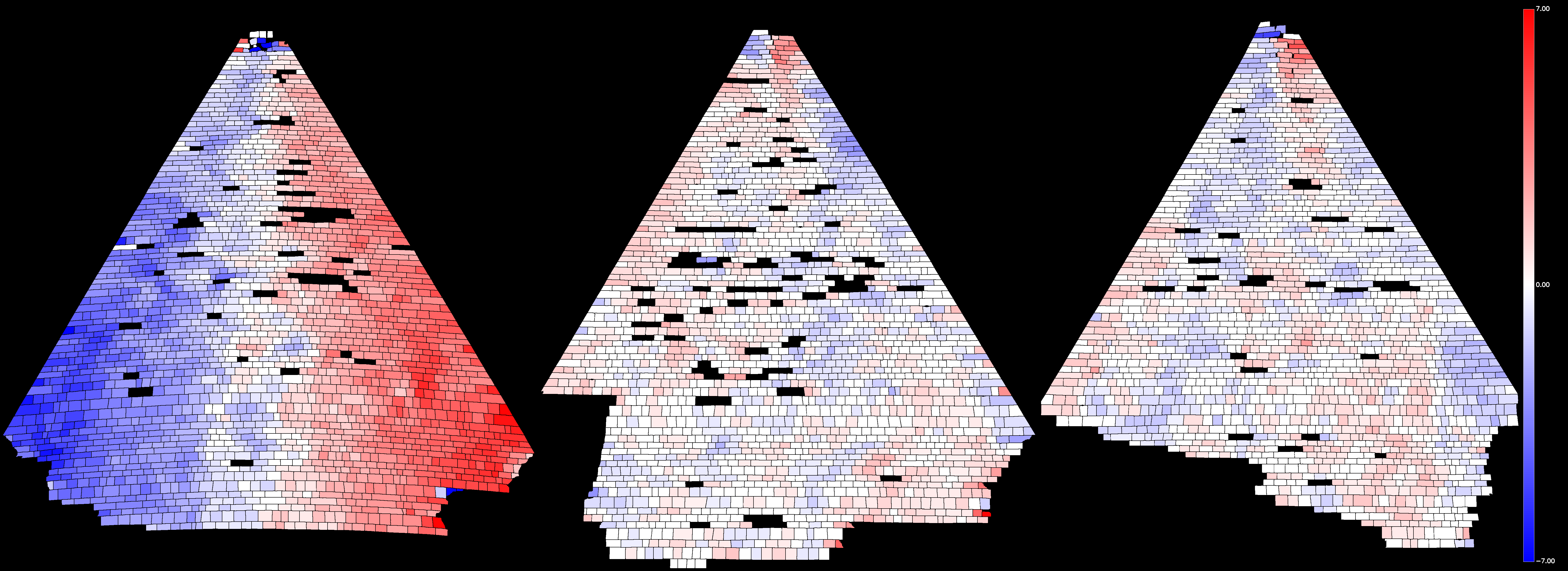
Some statistics on the size of stones used in the construction:
| Area of (in m²) | Mean | Std. Dev. | Min | Max |
|---|---|---|---|---|
| All Stones | 0.75 | 0.31 | 0.08 | 3.77 |
| North Stones | 0.73 | 0.32 | 0.08 | 3.77 |
| East Stones | 0.75 | 0.3 | 0.16 | 2.68 |
| South Stones | 0.76 | 0.3 | 0.17 | 2.81 |
| Corner Stones | 0.89 | 0.45 | 0.34 | 2.62 |
| All Stones (no corners) | 0.74 | 0.29 | 0.08 | 3.77 |
| Left Stones (no corners) | 0.74 | 0.3 | 0.16 | 3.77 |
| Right Stones (no corners) | 0.73 | 0.29 | 0.17 | 2.81 |
| Upper Stones (no corners) | 0.62 | 0.21 | 0.08 | 1.75 |
| Lower Stones (no corners) | 0.81 | 0.32 | 0.11 | 3.77 |
Overall, the three faces show a very similar distribution of stone sizes, as well as the left and right halves of the faces. Lower stones are larger, while upper stones are smaller. Corner stones are also larger on average.
In the below chart, the courses have stones with a more uniform average width below course 55 (green arrow region). Courses 30 to 55 appear to have many taller and wider courses.

Many stones are individually taller or shorter than the rest of their course, as illustrated in the below images.
| North Face | South Face |
|---|---|
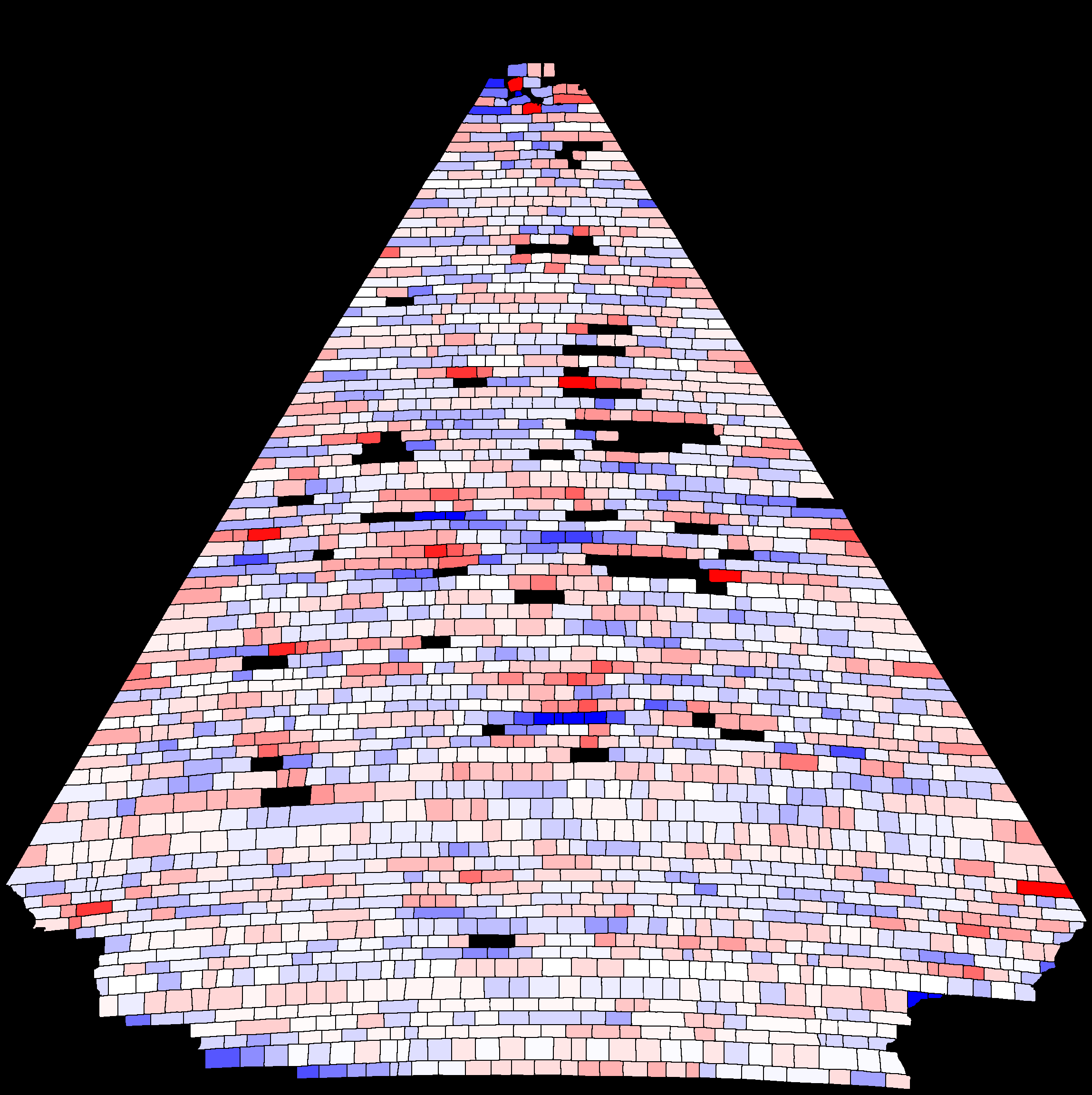
|
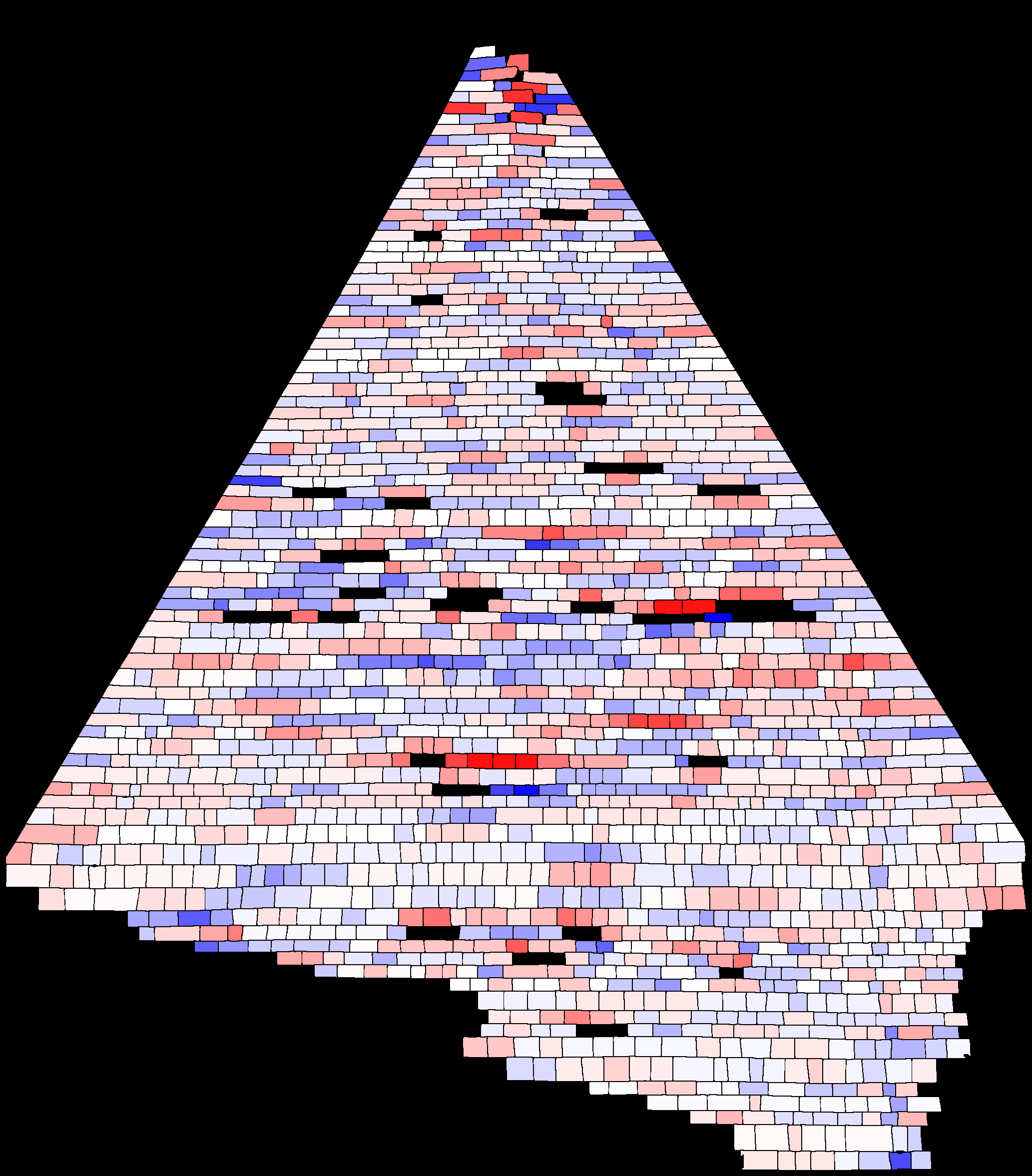
|

|

|
Bulging in the North Face
| Vertical Offset of stones from their course | Relative height of stones vs their course |
|---|---|
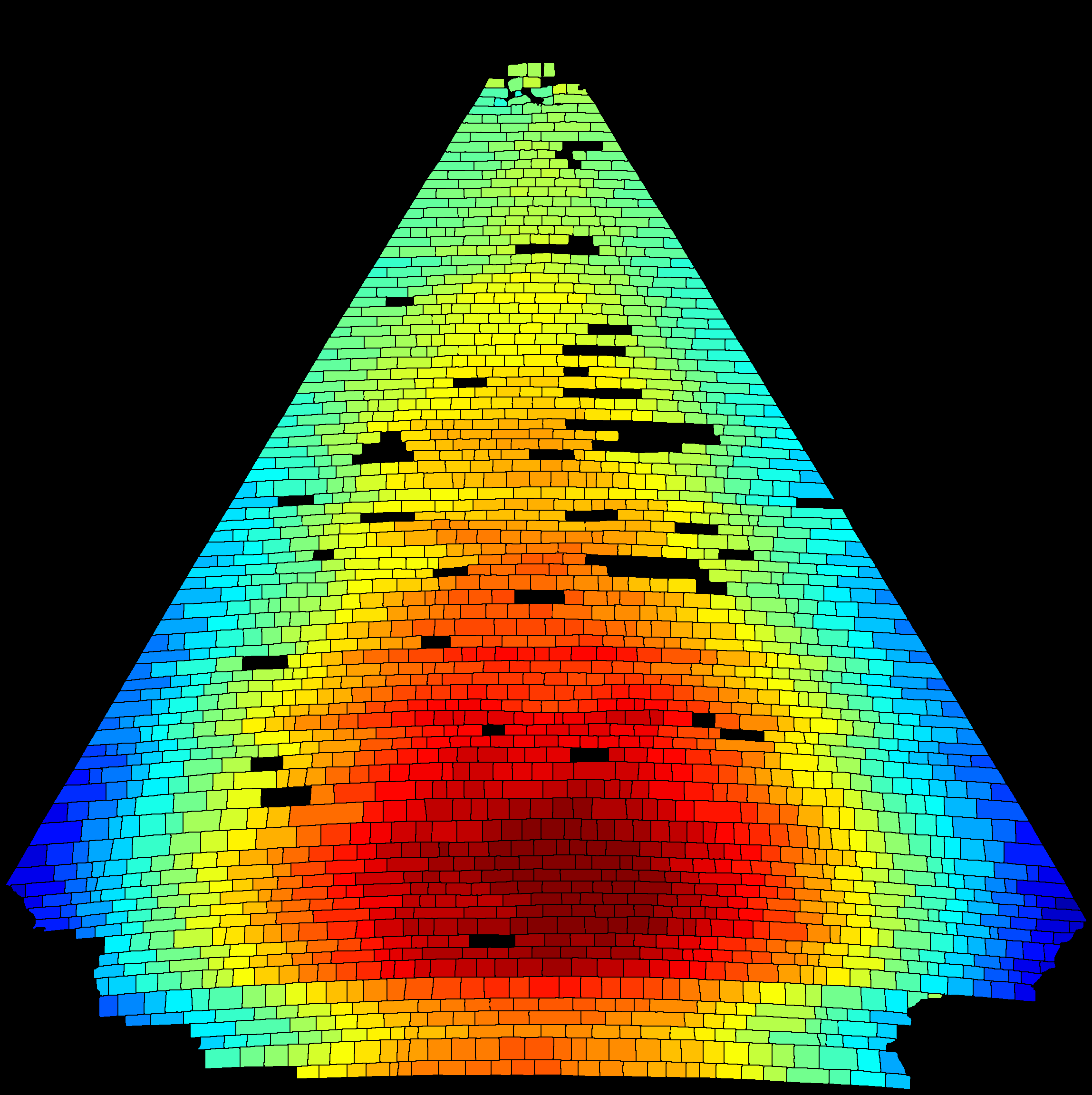
|

|
At some point in construction, the centre of the North Face courses seem to bulge upward, becoming higher than the edges of the course. There appears to have been a concerted effort to fix this issue by using shorter blocks for the centres of the course. This effort began around course 75 and was corrected by roughly 2.5cm per course between courses 75 and 50 (B) and by roughly 1.3cm per course between courses 50 and 10 (A). By course 10, the issue is resolved.
It is hard to tell if this is just an artificact of the imaging processs (i.e., lens distortion) or actually present, but it does not appear in images of the other faces.
The rate of increase of the deflection that was occuring before the effort to correct it (C) is roughly 2.5cm per course.
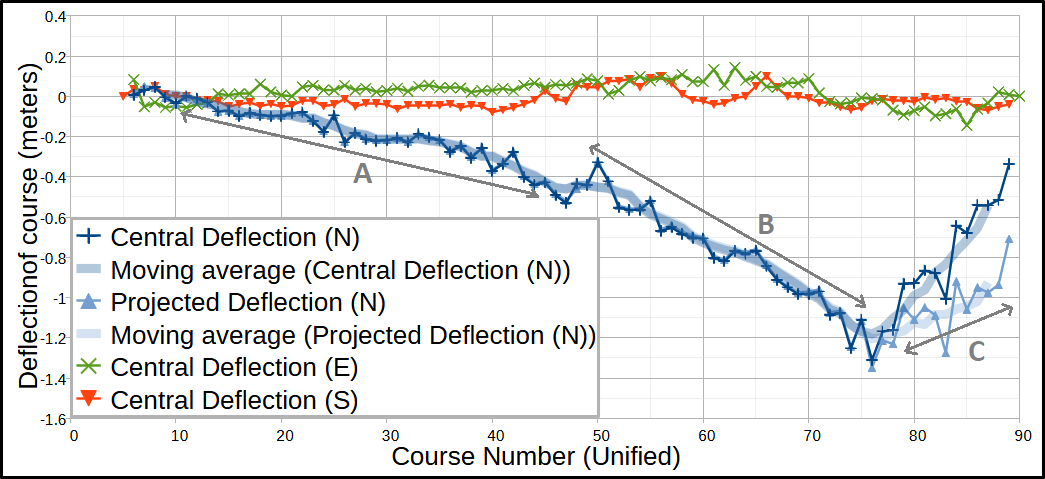
The above graph charts the deflection of the courses numerically. Note that below course 75 on the North Face, the courses are missing the outside casing stones. This obscurs the measurement as the current outer stones of the lower courses are higher than the original outer stones. The lighter blue on the graph shows the extrapolated deflection if there were no missing stones.
The deflection series for East and South show only minor amounts of deflection.
In the North Face, the upward deflection was increasing up until course 75, and it is likely that at this point the magnitude of the issue was recognised by the builders and a concerted effort was made to incrementally correct it.
| Orientation of masonry | Illustrated region boundaries |
|---|---|
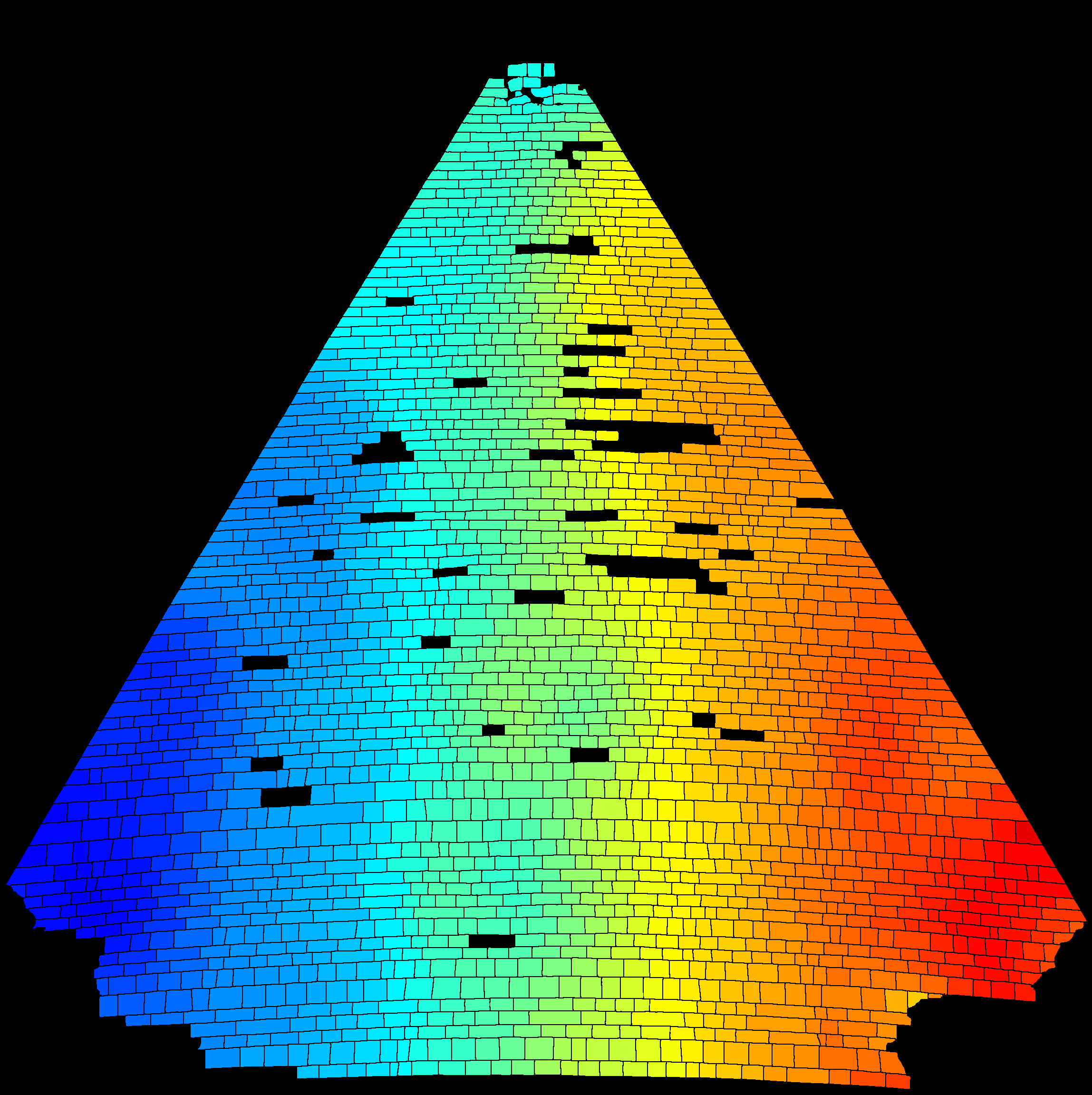
|
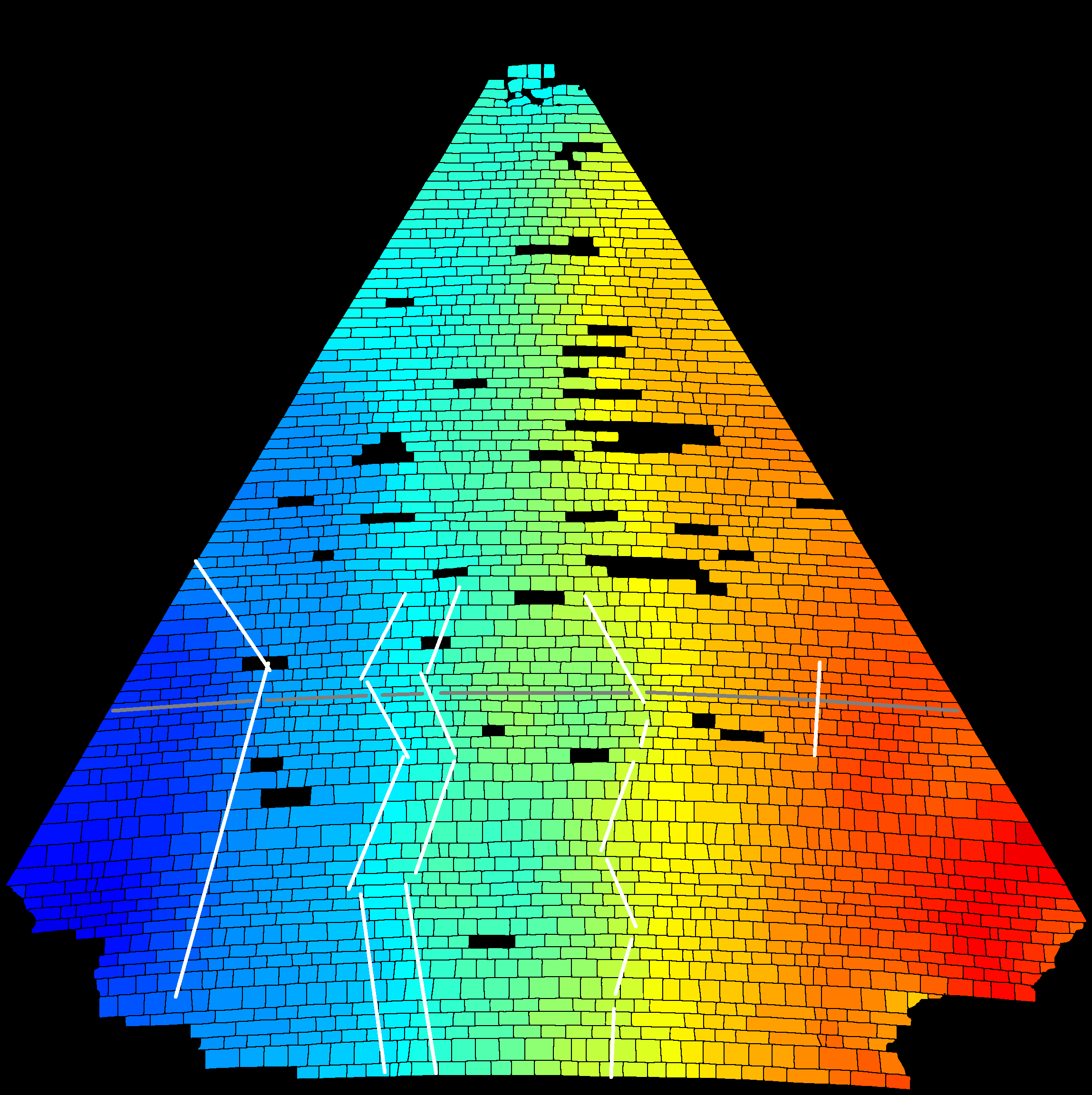
|
Carefully observe the image above (left). You can see that the curvature of the courses is not smooth but is mostly caused by angles between stretches of straight masonry, particularly on the left side of the face. This is exactly what we could expect if the vertical misalignment of courses occurs along a joint between sections built concurrently. The dark blue on the left, lighter blue to its right, teal, and then green sections are each angled differently but internally quite straight.
The angle joins (in white, above right) align somewhat with the suggested "joining stones". In particular, the long, near-vertical teal region above aligns very well with a similarly located set of joining stones. In many locations, these lines of joining stones are at quite an angle, which is desirable for avoiding differential vertical movement between the two regions. It is probably no coincidence that issues occur where the builders have zig-zagged much too vertically with their joining of separately constructed regions. This is perhaps more evidence that the casing stones, and perhaps the underlying stones as well, were constructed one course at a time. Had workcrews been building a region with many rows at once before joining it to another region, then they could have constructed triangular regions most easily (as this avoids placing stones overhanging missing stones), and then another workcrew constructed the inverted triangle to fill in after two lower triangles had been built.
Similarity in stone widths across faces
There is a weak correlation between the average widths of casing stones that are on the same course but on different faces of the pyramid. Mostly, it is noticeable that courses within a face with narrow or wide stones tend to maintain this pattern around the other faces. Note the blue-arrowed courses below; all have narrower stones than their adjacent courses.

The three large courses
Coloured by height relative to the average, red = taller, blue = shorter:
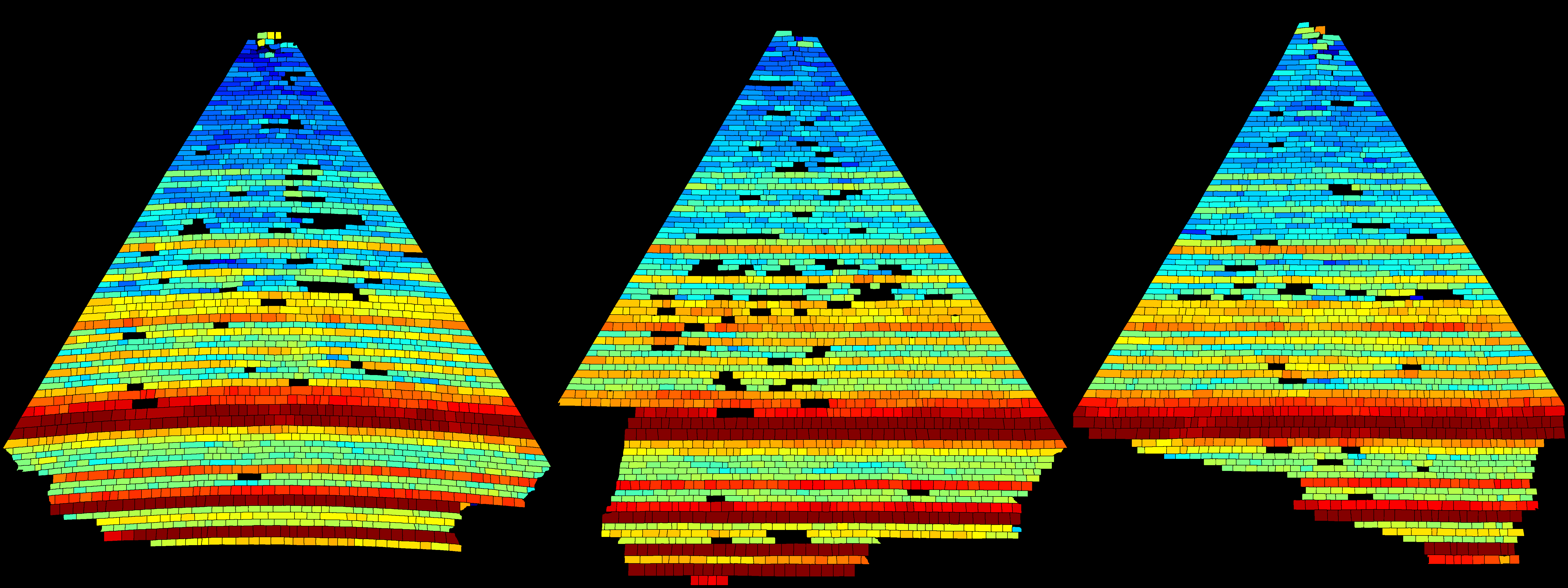
Joining or fitting stones
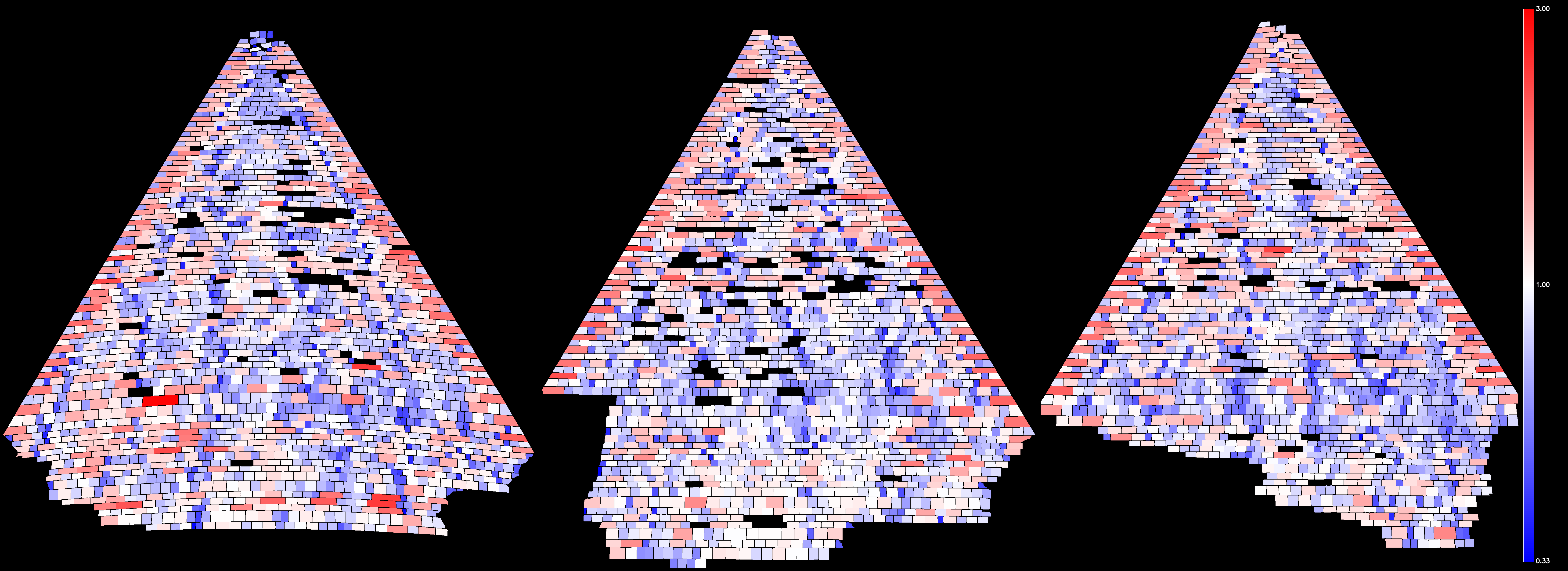
| Smaller Stones (North) | Possible regions (North) |
|---|---|

|

|
A zoomed in view of some of these thin casing stones:

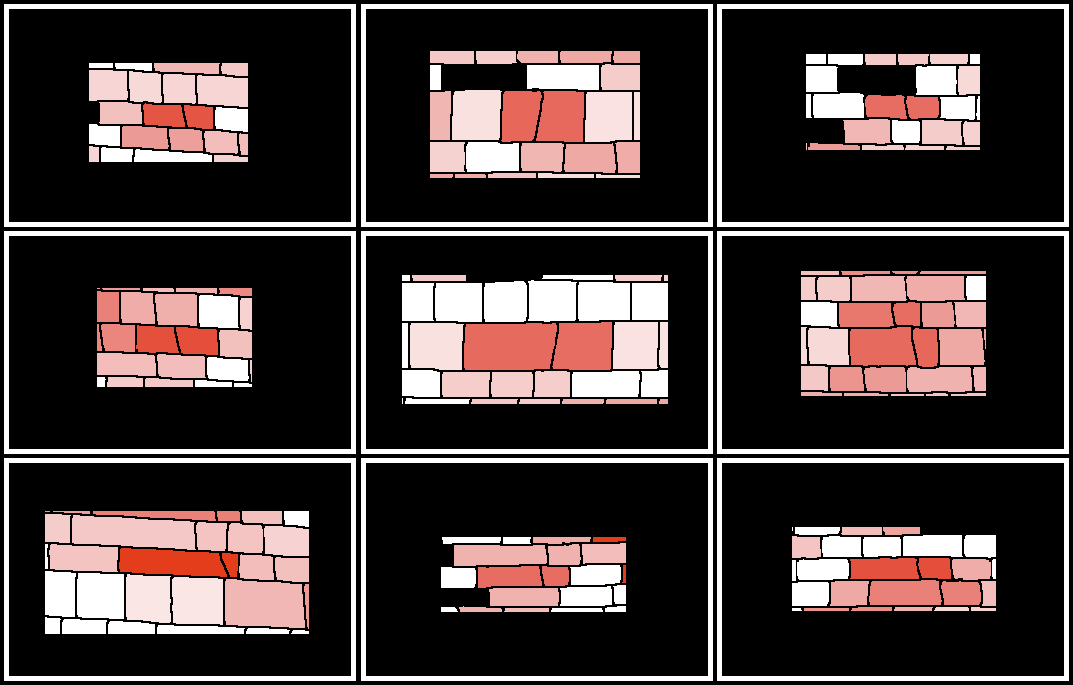
Chains of offset stones
There are "chains" of stones, wherein each stone in the chain is offset from the previous by a set amount, and the sizes of the stones in the chain are either similar or decrease slowly as you go up courses. The number of chains occurring suggests these aren't random chance, and are somehow related to the construction strategy of the casing stones.
Below, some examples from North (left), East (middle), and South (right) Faces:
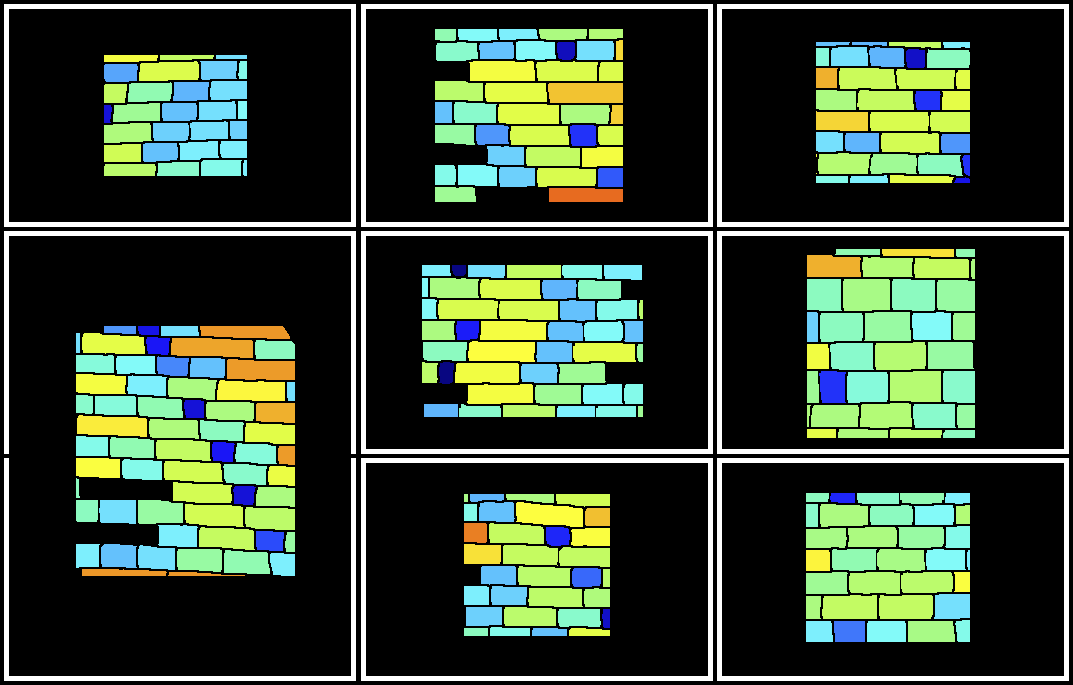
It is possible that multiple courses were placed simultaneously, and these chains of stones were the first ones placed amidst otherwise empty courses. Chains of stones in a consistent, overlapping pattern and with the correct course height could be useful as an anchor of stability within the otherwise more piecemeal construction.
Gaps at top of South Face
The gaps between stones at the top of the South Face are due to stones shifting to the left of where they should be. This was possibly caused by an earthquake or by whoever tumbled the missing top stones down the pyramid.
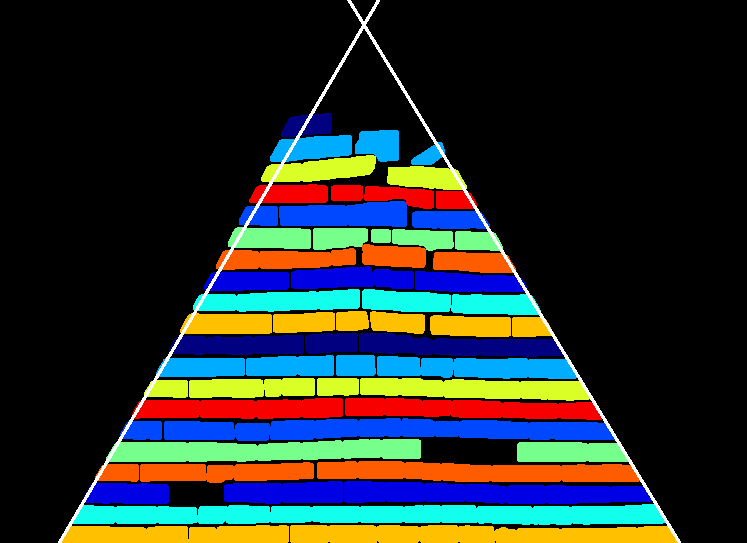
There are also some gaps, albeit smaller, at the top of the East Face (see below); however, the edge casing stones still appear to be in the correct places. Inspection of photos of the East Face indicates that these gaps may be caused by stones being shifted outwards from the face and rotated slightly.
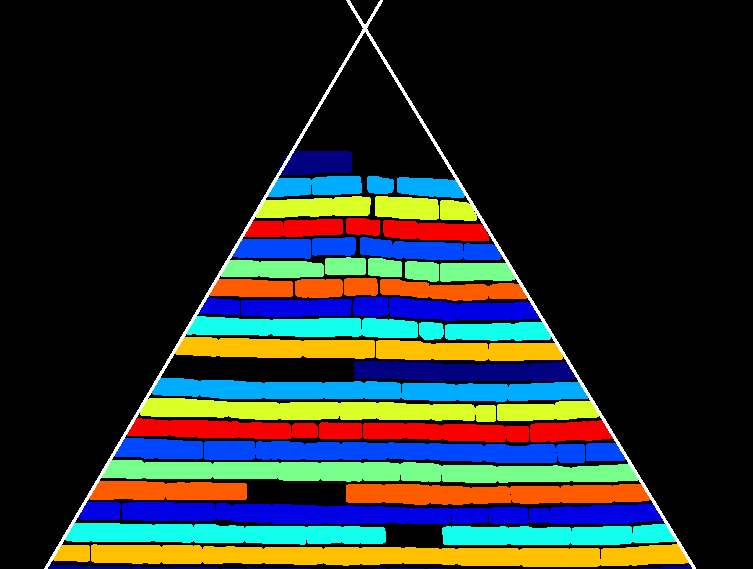
Depth of casing stones
Evidence for the depth of the casing stones is visible in two main places. Firstly, the very top of the pyramid is missing, exposing the top-down view of several casing stones. Secondly, the corner stones show two of their surfaces, and the surface with the smaller width is likely to be the (minimum) depth of the casing stones for that course.
It is possible that the construction technique of the corners uses a different depth of casing stone than the rest of the course; however, inspection of the exposed stones on top of the pyramid and of the bottom of the last layer of casing stones suggests the general depth of the stones does not differ. What may instead occur, is the extension of some of the casing stones further into the pyramid, to bond the casing stone layer to layers behind. We can also see a possble technique (below left) of indenting some of the covered top face, which would presumable pair with a protusion on the stone above, to bond the casing stones vertically.
| Photo | Diagram | Actual |
|---|---|---|
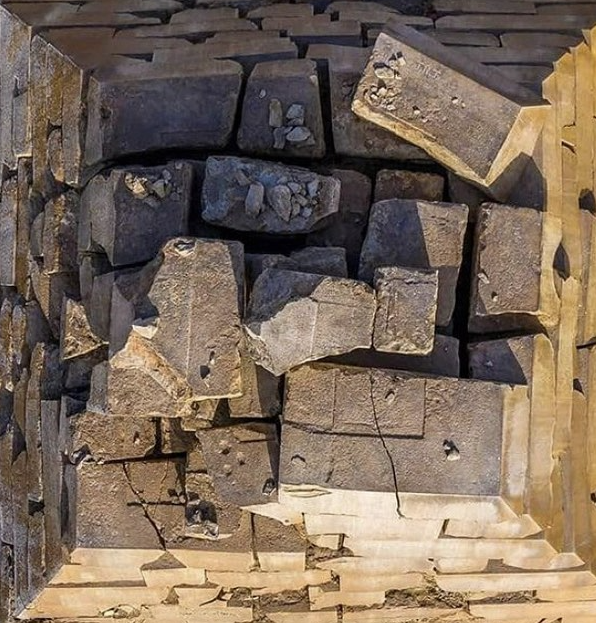
|
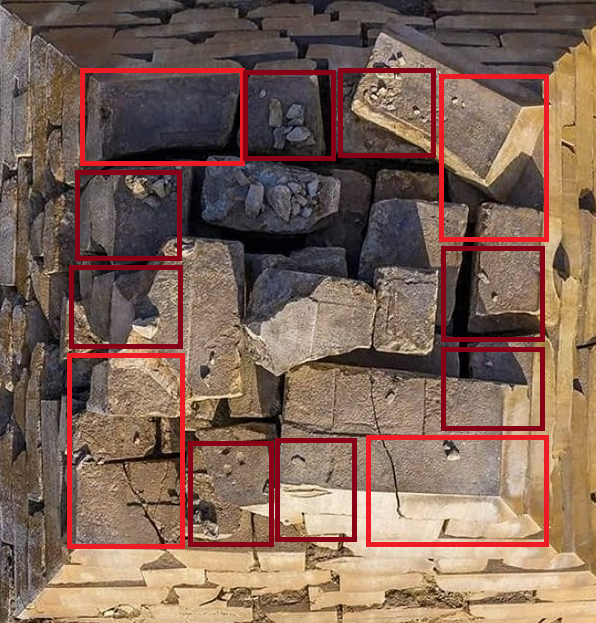
|
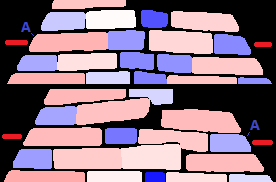
|
In the image (above, right), the two stones labelled A are two sides of the same stone.
| Front face of corner stones (note that the wide corner stones are manipulated to be narrow) | Cross sectional view of a standard, non-corner, casing stone |
|---|---|
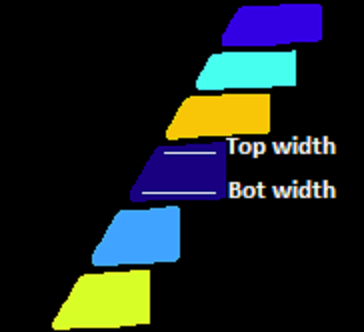
|
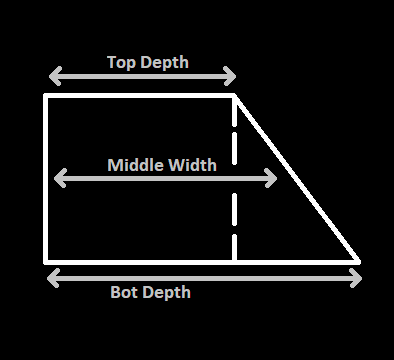
|
Note that the casing stones will have two depth measurements: the depth of the top of the stone and the depth of the bottom of the stone. The depth calculated from the width of corner stones is the average of these two depths. The top depth is important as it defines the overlap with the stone above. Because of this, the top depth is likely consistent from course to course for both tall and short courses. The bottom depth, in comparison, is likely just increased based on the height of the course.
| Group | Mean Width (meters) |
|---|---|
| Narrow Corners (All) | 0.96m |
| Upper Narrow Corners | 0.90m |
| Lower Narrow Corners | 1.01m (+12%) |
| Upper Wide Corners | 1.84m |
| Lower Wide Corners | 2.26m (+23%) |
While all of the corner stones are wider lower down the pyramid, the narrow corner stones do not increase in width as much. This makes sense, as the casing stone depth was limited by the size of the stones, which could be more easily transported.
This can give us a prediction of casing stone depth, as below:
| Course | Distance Up Pyramid | Predicted Middle Casing Depth (linear extrapolation) | Predicted Middle Casing Depth (alternative) |
|---|---|---|---|
| 0 (top) | 143.5m | 0.86m | 0.86m |
| 20 (average of "Upper") | 136m | 0.90m | 0.90m |
| 40 | 128m | 0.94m | 0.94m |
| 65 (average of "Lower") | 117m | 1.01m | 1.01m |
| ?? | 63.5 | 1.31m | 1.10m |
| ?? (base) | 0m | 1.65m | 1.20m |
Construction of the layer underneath the casing stones
WIP
Alternating corner pattern
Zoom in on the North Face (left) and the South Face (right). The North Face courses are from high up on the casing stones, and the South Face courses are from lower down on the face:
The edges of each course follow a distinctive alternating pattern. A wide corner stone is then followed above by a narrower corner stone and a second (and sometimes third) stone that extends to overlap the first stone.
There are also hints of an alternating taller-to-shorter to taller pattern in the corner stones.
Alignment of stones around corners
| Group | Mean Width (meters) |
|---|---|

|

|
The alternating, wide and narrow corner stones are, in fact, all wide stones. Their orientation is alternated to show a wide face on one side of the pyramid and a narrow face on the other. This pattern increased the structural stability of the corner regions by binding the two faces together.
Change in the corner pattern

| Group | Mean Width (meters) |
|---|---|
| All Corners | 1.52 |
| Upper Corners | 1.47 |
| Lower Corners | 1.68 |
| Wide Corners | 2.08 |
| Narrow Corners | 0.96 |
| Upper Wide Corners | 1.84 |
| Upper Narrow Corners | 0.90 |
| Lower Wide Corners | 2.26 |
| Lower Narrow Corners | 1.01 |
Angles of stone’s vertical edges
Overall, the left edges are slightly clockwise rotated, and the right edges are slightly anti-clockwise rotated, which makes sense due to the strongly angled edges of the cornerstones. Without the cornerstones in the analysis, edge angles average out to near vertical. When considering stones on the left half of the face versus those on the right, it can be seen that edge angles are slightly more likely to be angled in the same direction as the nearest edge of the face.
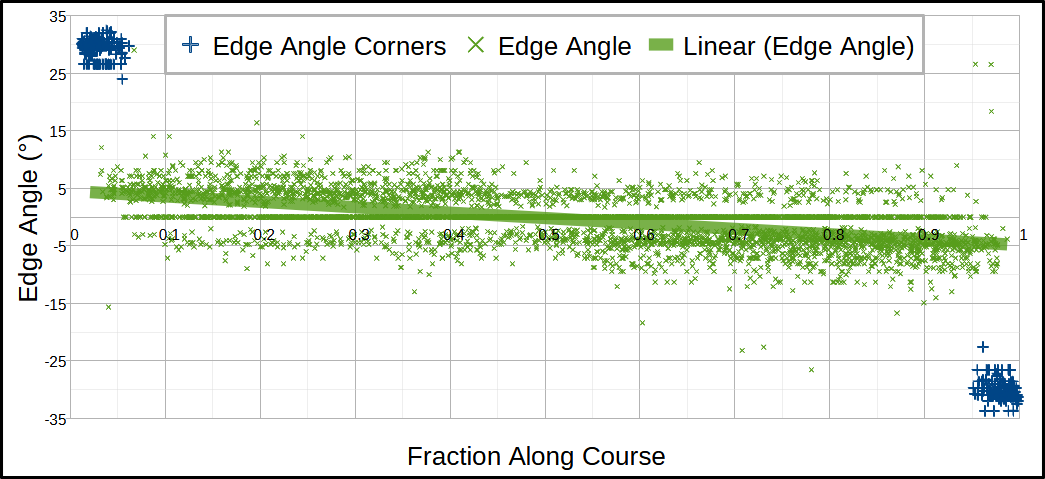
| Group | Left Angle (°) | Right Angle (°) |
|---|---|---|
| All Non-Corners | -0.08 | -0.32 |
| Left Non-Corners | 1.25 | 0.99 |
| Right Non-Corners | -1.22 | -1.45 |
The distribution of edge angles appears to be the same for each of the three faces analysed. This is somewhat unexpected as, on the North Face, many of the stones are themselves at a slant due to the bulging issue. Since I used the angle from the vertical for my calculations, I would have expected a slightly higher average absolute edge angle for the North Face due to the contribution from these slanted stones. Since the average absolute angle of any vertical edge is only around 2° off the vertical, it is hard to immediately tell if the correction efforts occurring on the North Face counteracted the contribution from the non-straight courses or if the contribution was just very minimal.

| Group | Absolute Left Angle, StdDev | Absolute Right Angle, StdDev |
|---|---|---|
| All Non-Corners | 2.05°, σ=2.99° | 2.06°, σ=2.99° |
| Left Non-Corners | 2.07°, σ=3.26° | 1.87°, σ=2.70° |
| Right Non-Corners | 2.03°, σ=2.73° | 2.22°, σ=3.21° |
Angles on corner stones
| Left Corner Angle (from vertical) | Right Corner Angle (from vertical) |
|---|---|
| 28.79°, σ=1.98° | 29.49°, σ=2.08° |
The expected angle is approximately 31° (59° from the horizontal is the same as 31° from the vertical). The angle of the pyramid edges as a whole is correct, suggesting some systematic error is causing a 2° loss in the measurement angle of the corner stones.
Both the left and right corners have an average other edge angle of 1.25°. This average "other edge angle" leans towards the same side as the pyramid edge. This is very similar to the average for non-corner stones.
Vertical edge angle distribution by size of stone
Both large and small stones have a similar distribution of edge angles, with both groups averaging out to a near-zero edge angle (when excluding corner stones).
Distribution of course heights
| North Face - Height | East Face - Height | South Face - Height |
|---|---|---|
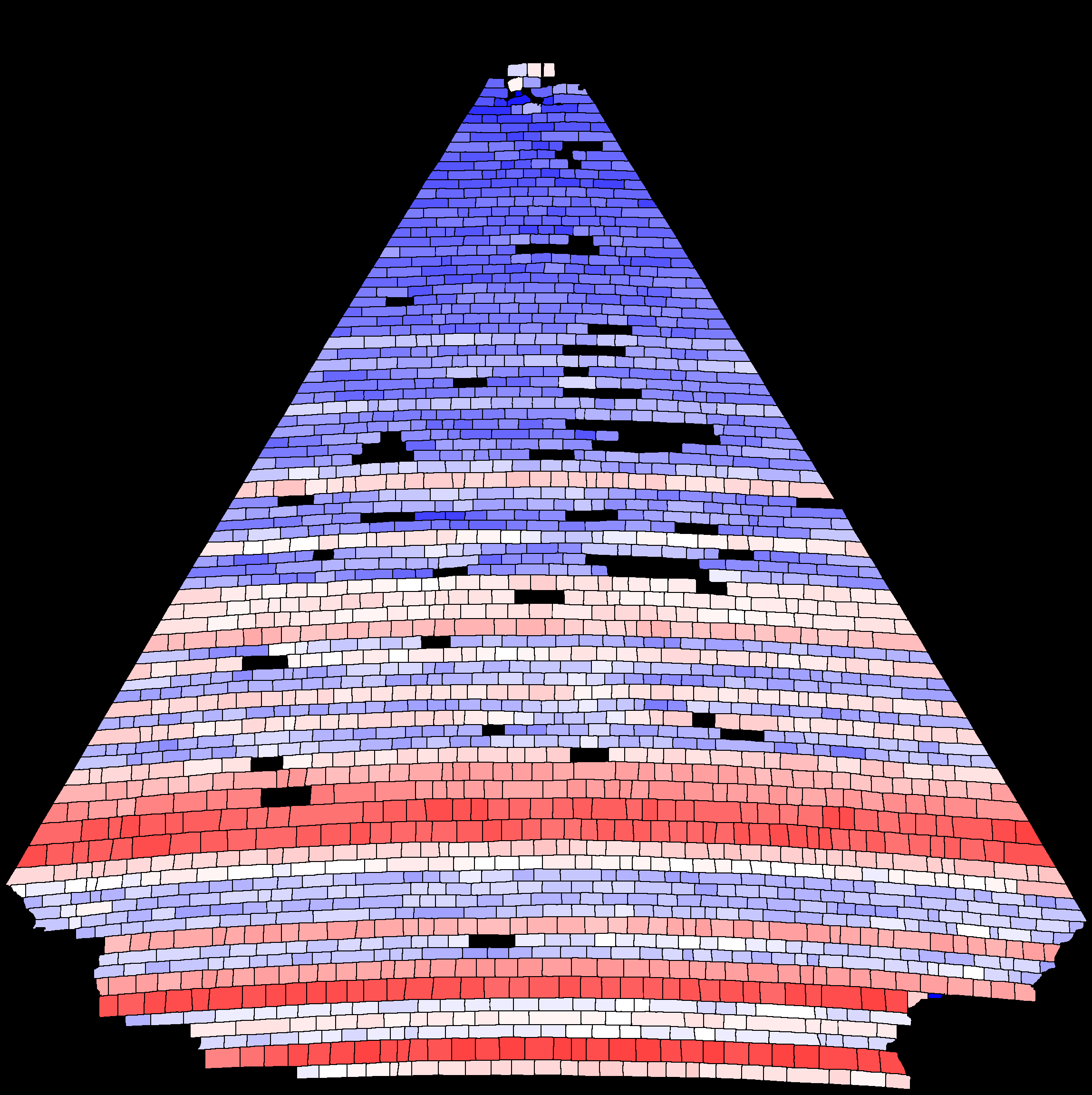
|
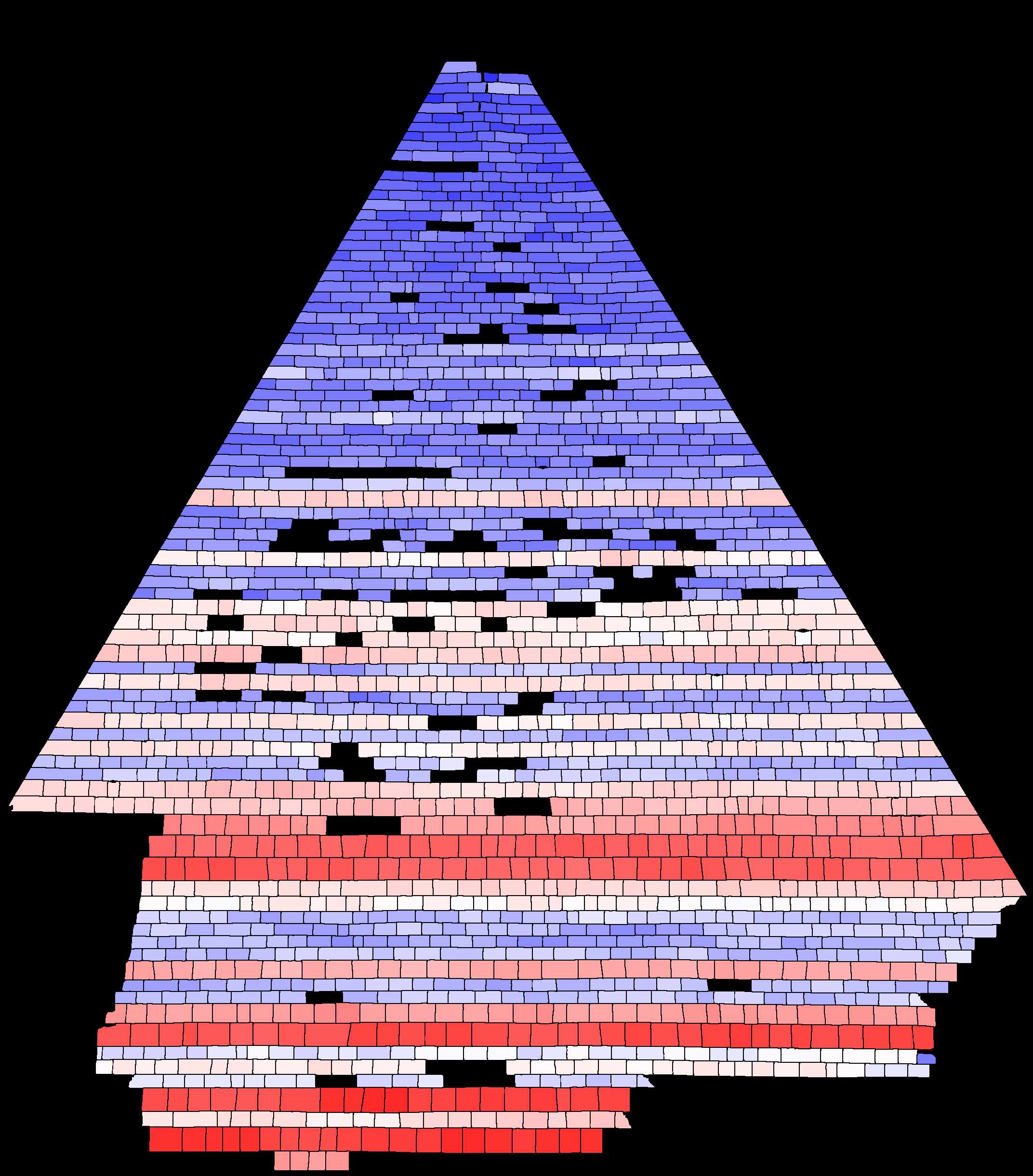
|
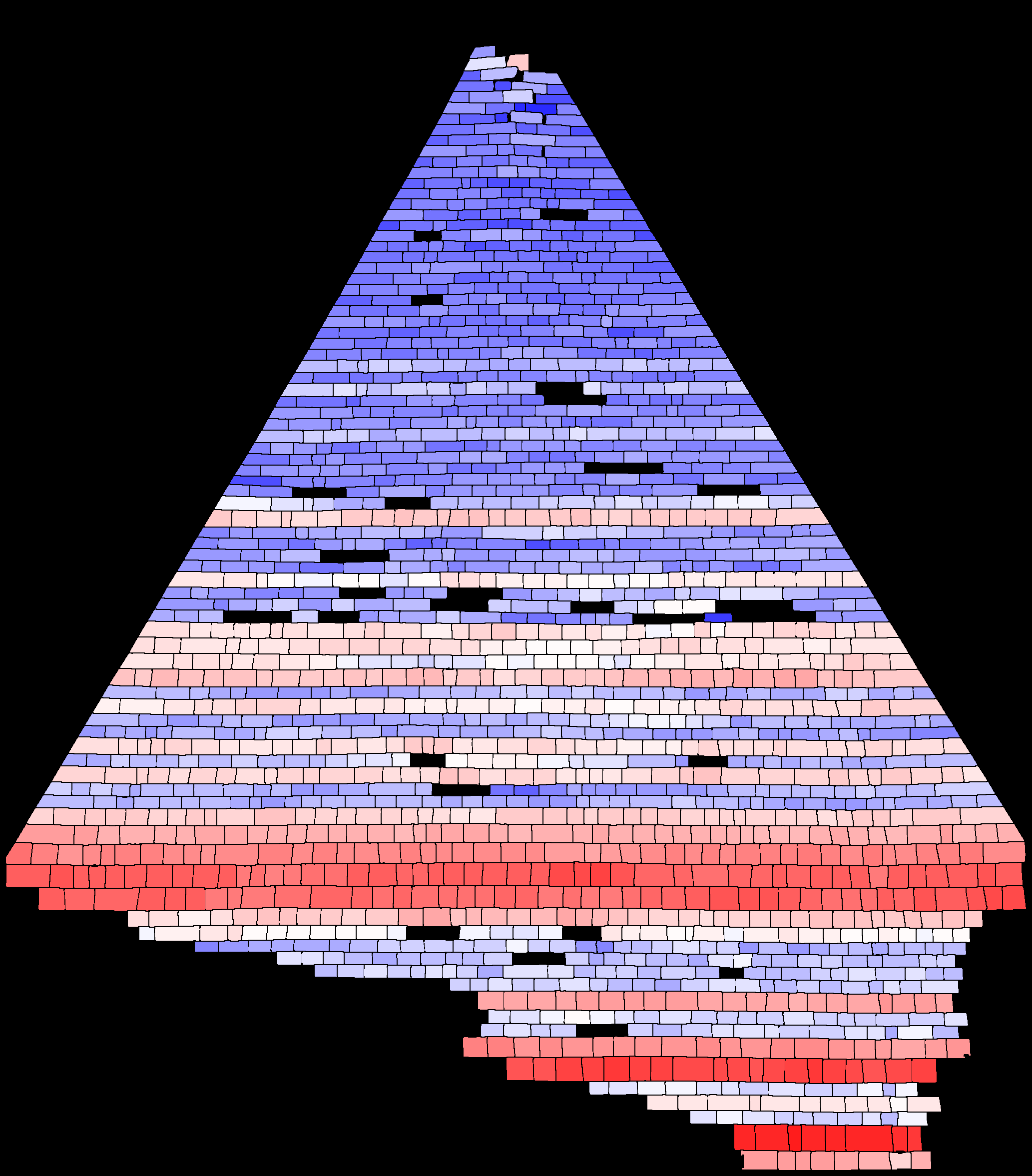
|
Images of the course height (above) show that there are many courses that are significantly taller than average. Since these courses do not appear near the top, this could give the illusion of course height decreasing up the pyramid, whereas there could just be no anomalously large courses further up the pyramid.
Observing the chart below, course height does tend to decrease up the pyramid, and there seems to be a minimum course height, which also decreases up the pyramid (up = left on the chart).
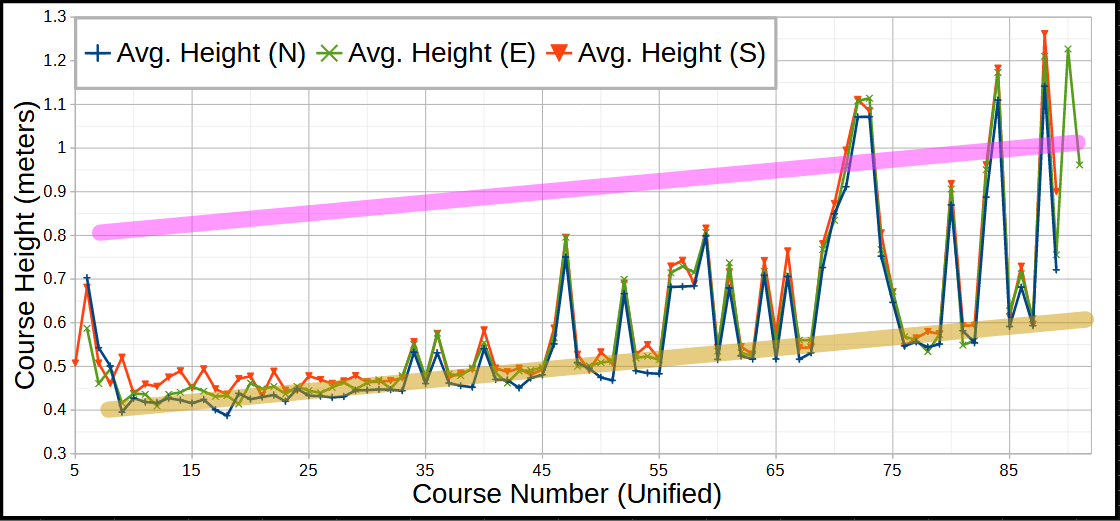
When excluding courses with a height significantly different from this trend, there is a very consistent pattern left over, suggesting a plan: a rule for minimum course height by course was put in place by the pyramid builders. Seams of limestone must have been searched for that could satisfy this minimum requirement. The courses that are consistent with this pattern probably come from very large seams of limestone that were cut down to the height desired.
The anomolously larger courses may result from seams of limestone that were not large enough for two standard-sized courses and so provided one larger course. The pink line highlights twice the standard course height. Some of the courses lower down the face are taller than twice the standard course hight, so the builders could have tried to split them into two courses.
It is interesting to note that the largest section of anomalously large courses (69-75) occurs exactly as the builders begin correcting for the upward deflection occuring in the North Face at course 75. This could be the reason for many consecutive large courses. It is easier to accurately correct by a fixed amount when that fixed amount is a smaller fraction of the course height, and it is also less visually jarring, as the blocks are reduced by a smaller fraction than if they were shorter. It is possible that other tall courses are also to give the builders some flexibility to fix issues that have occured in the construction.
Distribution of stone width by course
Stone width appears either uncorrelated or only weakly correlated with course number. However, below course 55, the width is much more consistent from course to course. Between courses 50 and 55, there are many courses with a higher average width. There also appears to be some clustering of higher widths (i.e., a high-width adjacent course predicts a higher average stone width in this course).

Relationship between width of stone and height of course
There is a slight negative correlation between the height of the course and the average width of stones within that course. If courses 40-50 are removed, there is possibly no correlation, as courses 40-50 have many short courses with wide stones. See Widths and Heights
Height variation of stones within a course
| North Face - Height | East Face - Height | South Face - Height |
|---|---|---|

|
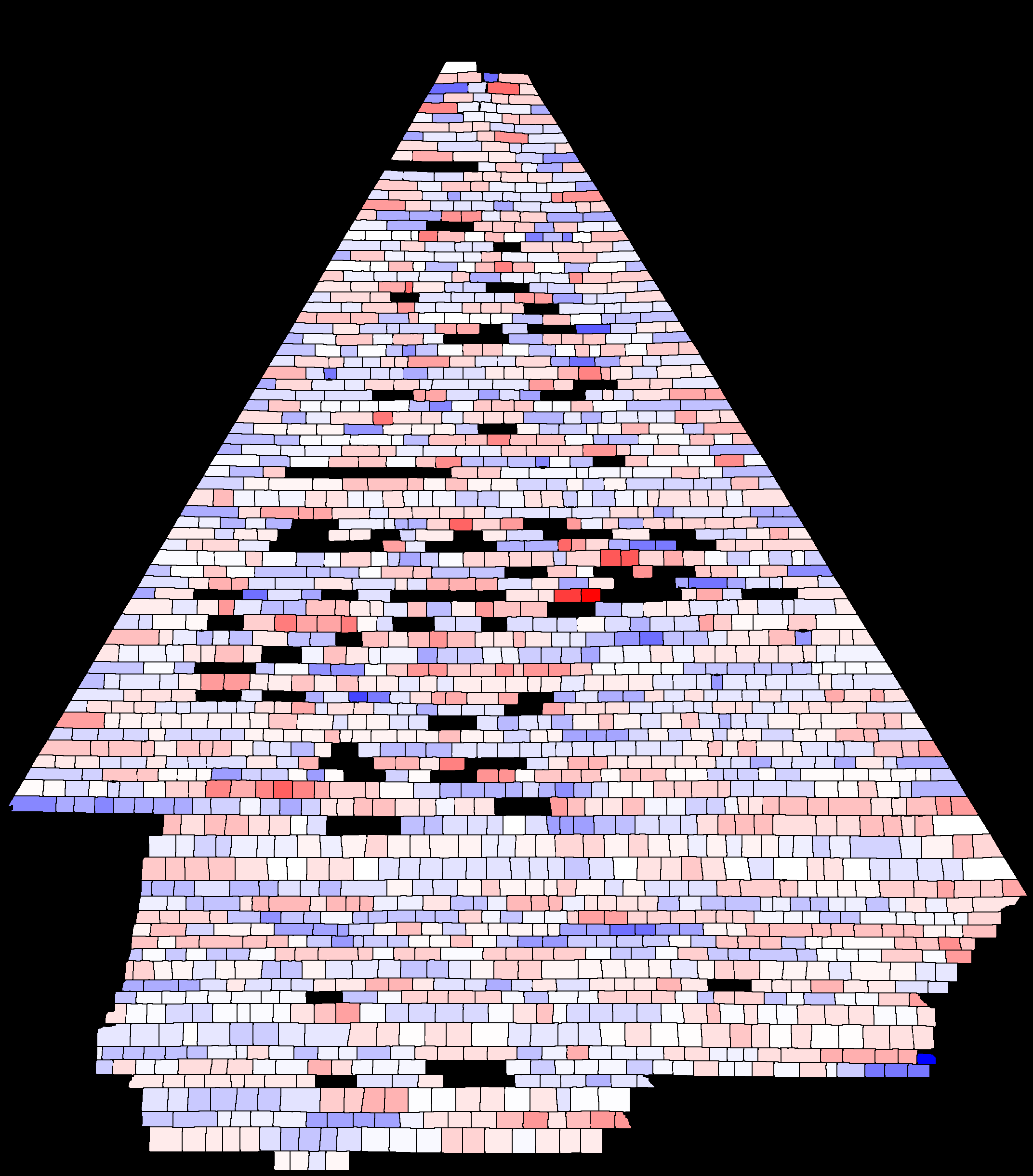
|

|
There is not much of an obvious pattern. The random variation of stone heights from what they should be is larger than the average "correction" done on the North Face. It is clear on the North Face that there are more taller than average stones near the edges of the course. And possibly also more shorter stones within the central part of the course.
Course width by height up the pyramid
A very consistent linear correlation, as is required due to the pyramid shape. Only slightly noisy near the top and near the bottom, due to missing stones.
Distribution of breaks in courses
More gaps are lower down the pyramid, which is to be expected since there are more stones that could be missing. There are major issues around courses 71-74, where the entire edges of the course starts to be missing.
Vertical offset of stones relative to their course
Absolute vertical offsets from course edges (North, East, South)
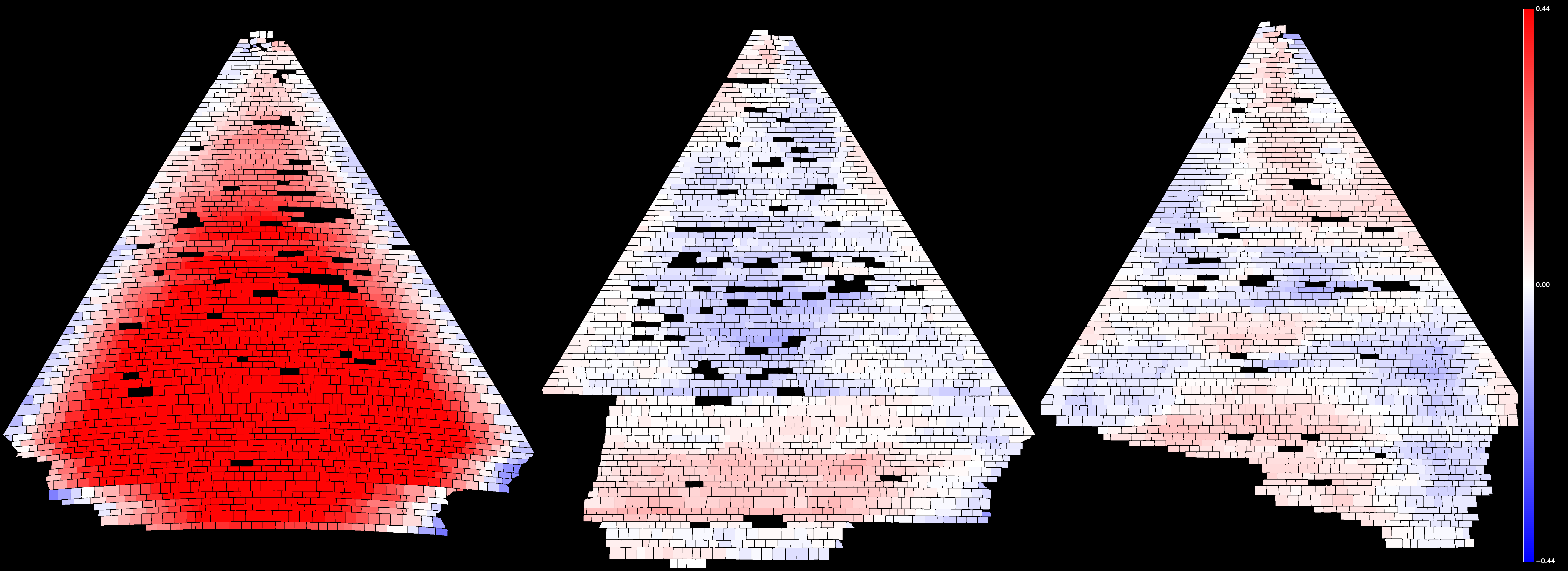
The North Face has significant upward bulging, obscuring any other issues.
The South and East faces have minimal vertical deflection compared to the North Face.
One very interesting issue on the South Face, is the sagging that appears to be occurring up against a line of "joining" stones. The green highlight below roughly illustrates the general path of these joining stones.
Perhaps the workcrew building on the left side was introducing a systematic issue, which was reducing the height of their courses. Or, perhaps, the right side was constructed first, and then when the left side was constructed, the additional weight caused it to slump below it.
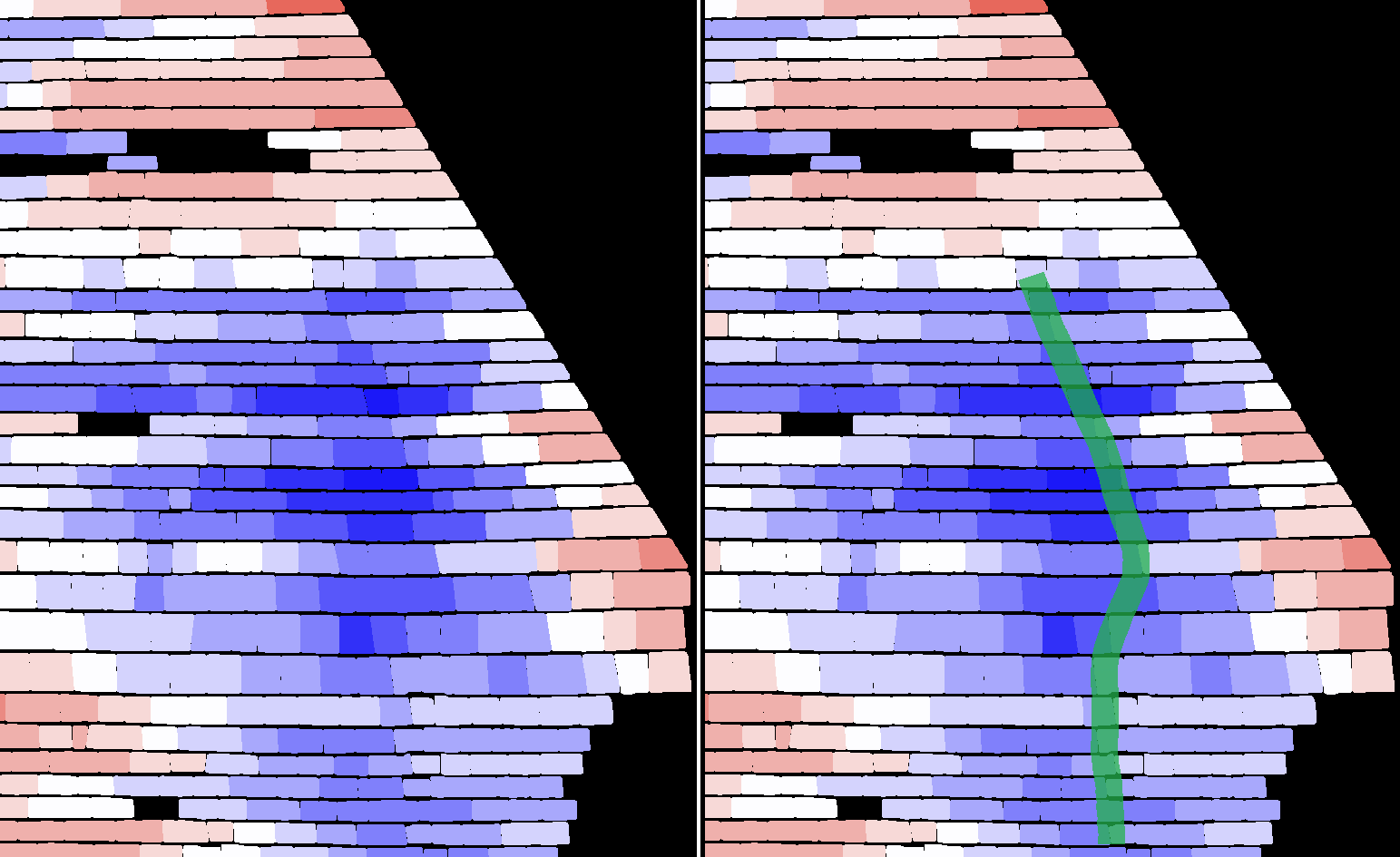
Course edges and their alignment
Ideally, the pyramid would have completely straight edges that all meet up exactly at the apex of the pyramid without deviating. Observe the chart below. The horizontal edge positions of courses are plotted against the course number. Since some courses are taller or shorter than others, the data series are not perfectly linear, but they are all consistent since they share very similar course heights. (Note that the series on the chart have been offset from each other for visibility.)
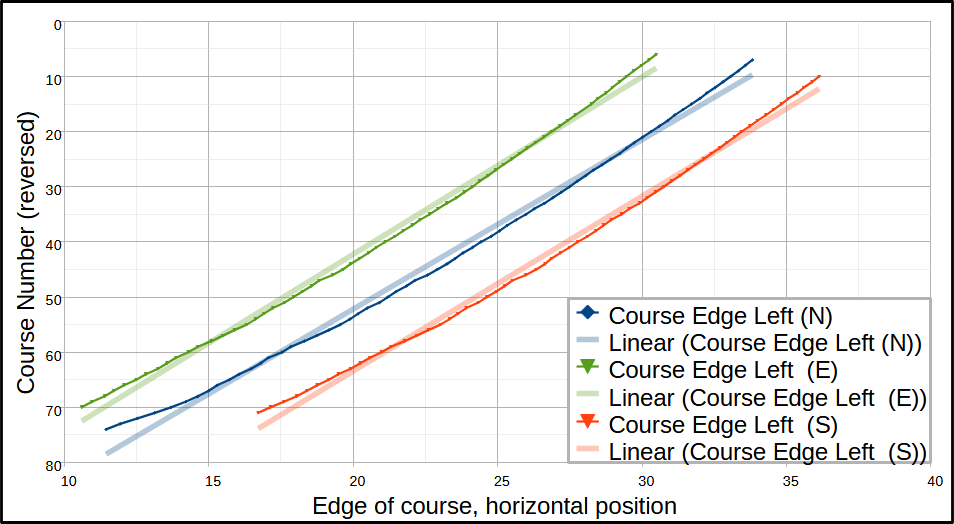
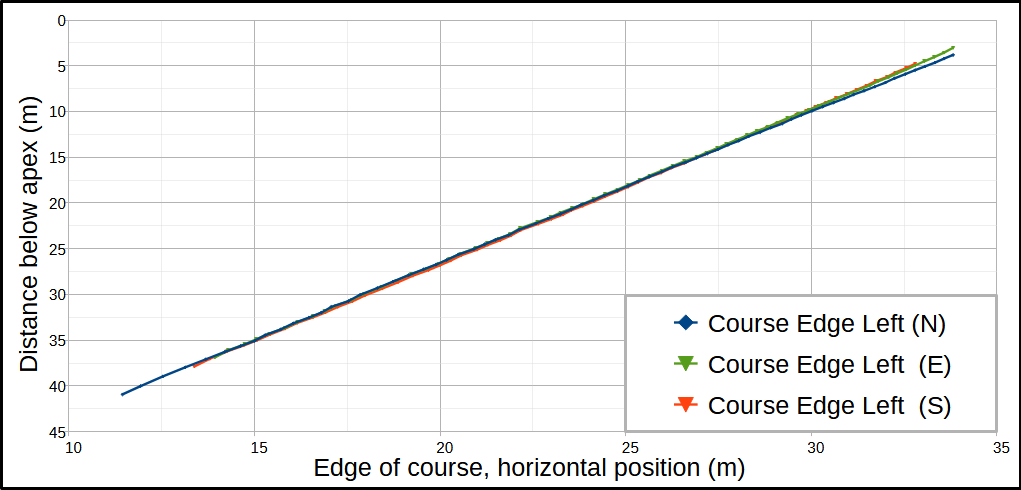
When the course edges are plotted against their absolute vertical position (as in the second chart above), the relationship is very consistently linear. Notably, the North Face deviates slightly inward near the top.
If the builders had aligned each corner relative to only the previous corner, the errors would have accumulated up the pyramid, and we would expect to see some deviation from their desired positions. Given the excellent positioning of these corner stones, the pyramid builders must have used some consistent method of alignment, perhaps stretching rope along the edge over many courses.
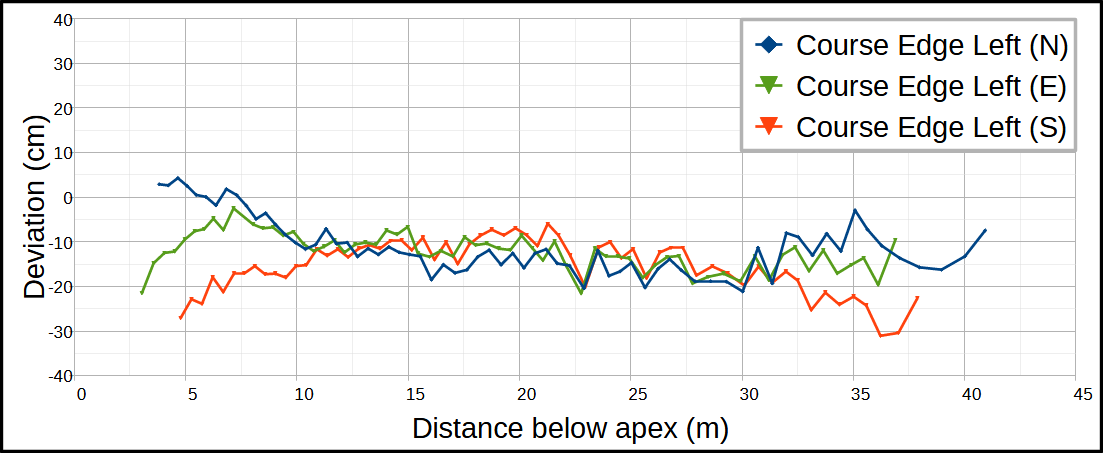
The above chart gives a zoomed-in view of the deviation of the course edges from the calculated pyramid outline. Note that there are many small errors that will have contributed to the exact numbers above, but general patterns can still be observed.
Firstly, the upper regions have some deviation, which is to be expected as the remaining tops of the faces have some disturbed stones. Between 10-30m below the apex, we see quite consistent edges. Below 30m, we start seeing some deviation, and this region somewhat corresponds to where the builders had to start correcting for bulging issues in the North Face.
Note that the dip around 23m (x-axis) corresponds to course 47, which is anomalously taller and with narrower stones than the surrounding courses.
Stone stats by position along course
Most statistics do not deviate from the overall distribution. Edge angle has an interesting pattern; notably, more edges are aligned towards the pyramid edge closest to them.

Big vs small stones
| Statistic | Comparison |
|---|---|
| Fraction fill | Similar |
| Distance down pyramid | Bigger is further down |
| Distribution along course | Similar |
| Edge angles | Similar |
| Width | Bigger stones are significantly narrower (approx 80cm vs 110cm) |
Wide vs narrow stones
| Statistic | Comparison |
|---|---|
| Fraction fill | Similar |
| Distance down pyramid | Similar |
| Distribution along course | Similar |
| Edge angles | Similar, but narrower stones have a slightly higher absolute edge angle (2.1° vs 1.9°) |
| Height | Narrower stones are very slightly taller |
Upper vs lower stones
| Statistic | Comparison |
|---|---|
| Fraction fill | Similar |
| Distance down pyramid | Bigger is further down |
| Distribution along course | Similar |
| Edge angles | Lower stones have slightly more angled edges (abs. edge angle of 2.25° vs 1.7°) |
| Height | Lower stones are taller |
| Width | Lower stones are slightly narrower |
| Size | Lower stones are significantly bigger |
Right vs left half stones
| Statistic | Comparison |
|---|---|
| Fraction fill | Similar |
| Edge angles | ~1.2° clockwise for left stones and anti-clockwise for right stones |
| Height | Similar |
| Width | Left stones are very slightly wider |
Corner stones
Corner stones are, on average, significantly shorter and wider. Note that we are missing some of the corners near the bottom, where the courses are taller.
| Statistic | Corner | Non-Corner |
|---|---|---|
| Edge angle (from vertical) | ±31.02° | ±2.05° |
| Height | 0.55m | 0.65m |
| Width | 1.52m | 1.08m |
| Size | 0.89m | 0.74m |
For the chart below:
Note the tight grouping of the narrower, red corner stones (between 0.8 and 1.2m wide). This is because they must be the same depth as the entire course of stones at their level. The wide corner stones have a much more spread distribution, which is noticeably wider on average than the normal stones.
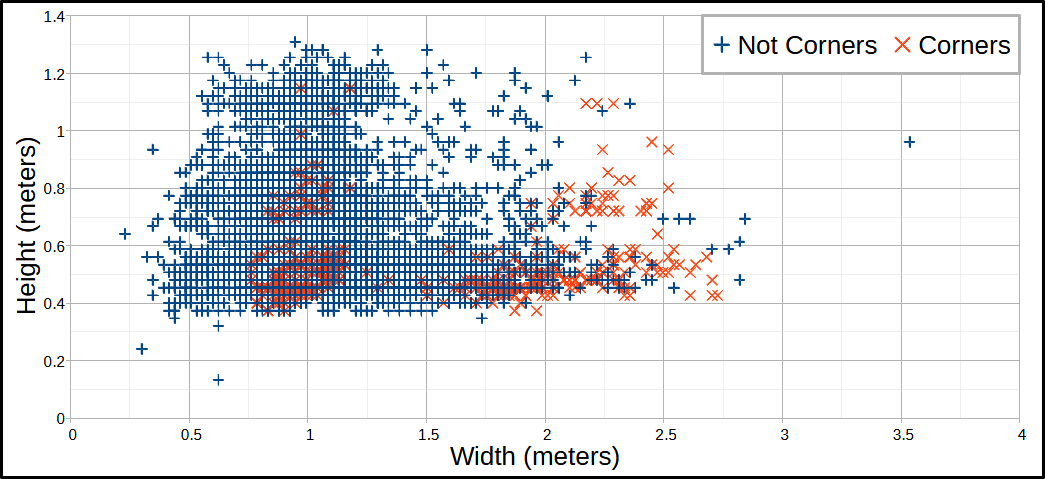
Wide vs narrow corner stones
Overall, wide corners are slightly further down on average, and wide corners are very slightly taller on average.
Contribution of badly shaped stones
Since only 5 stones were identified as "bad" with the method I used, excluding them from the statistics had little effect.
Width vs height
There is a slight negative correlation between the width and height of casing stones. i.e., if a stone is wider, it is likely to also be slightly shorter. This may be because larger stones are harder to transport. It is particularly noticeable that almost all of the larger stones are only up to around average height and not taller.
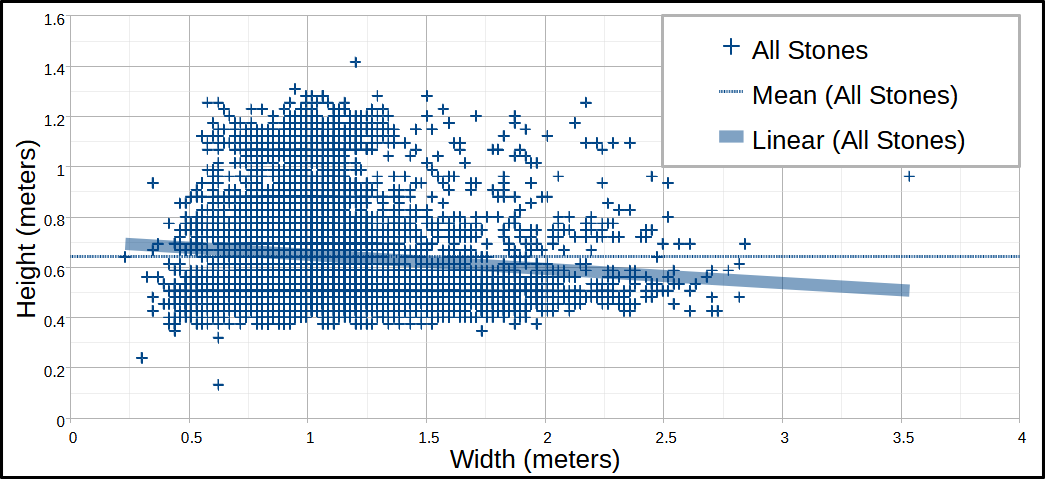
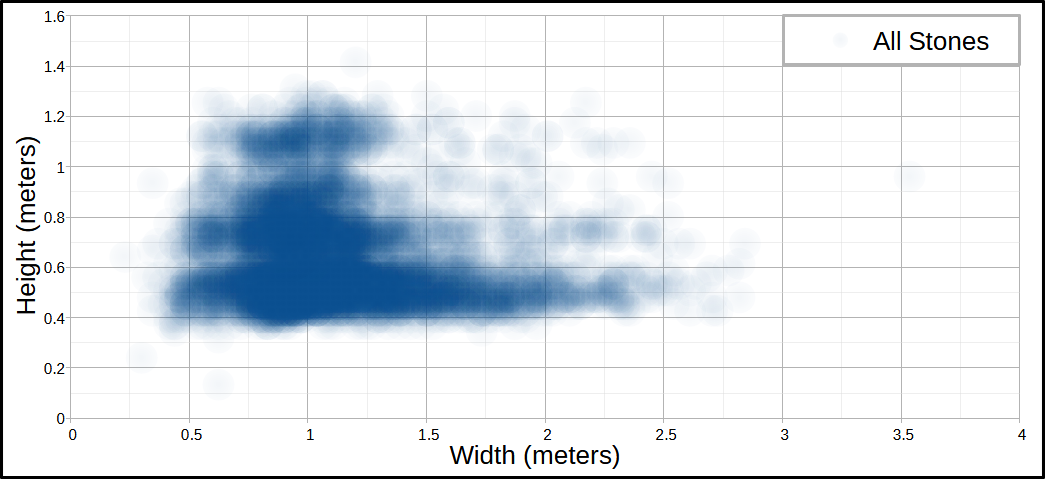
Stats by height
Very wide stones tend to be significantly shorter.
Stats by width
By considering width vs. fraction along the course, we can see that wide stones are often the first or last stones in a course. This is just because the first and last stones are corner stones, which are wider on average.
Looking below; we can see that there is no obvious pattern when excluding corner stones. There may be a tendancy for stones near the middle of the face (0.4-0.6 on the chart below) to be a more average width.
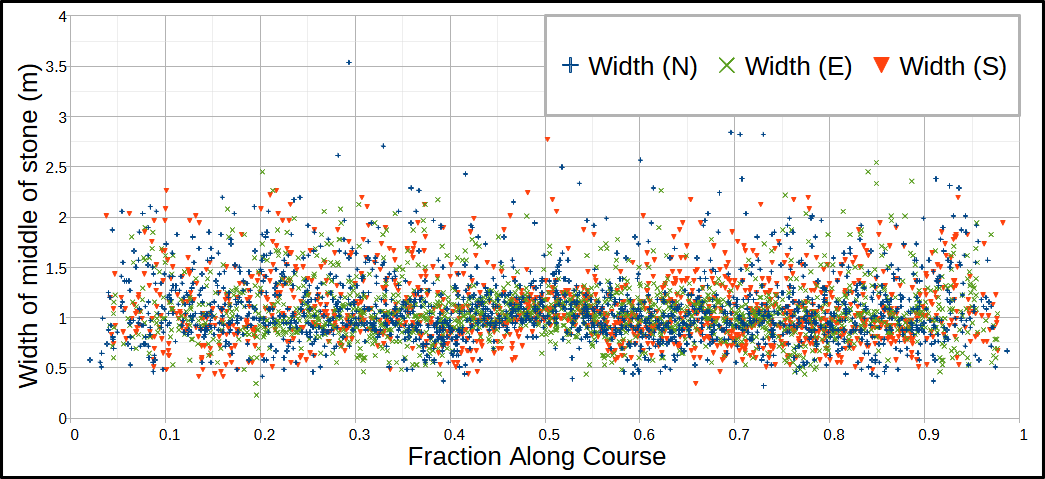
Stats by size
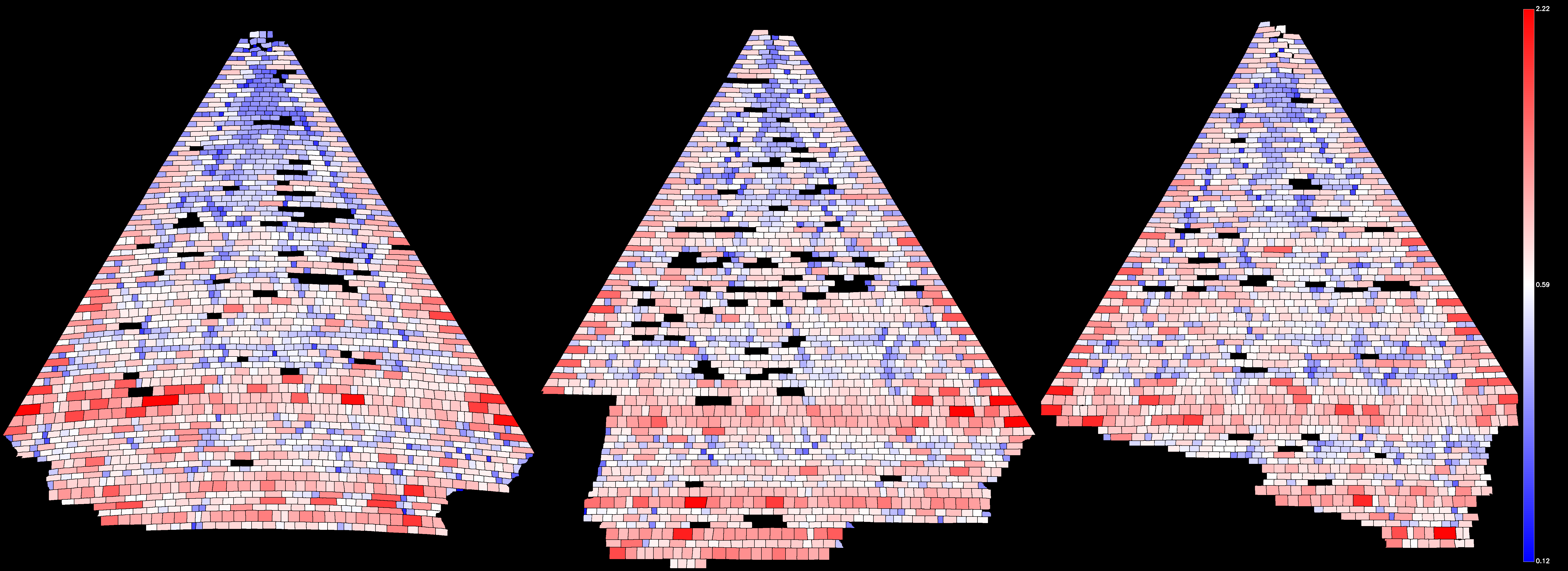
The biggest stones seem less likely to occur near the center of the course (look at 2m²+ below). However, there appears to be no overall pattern.
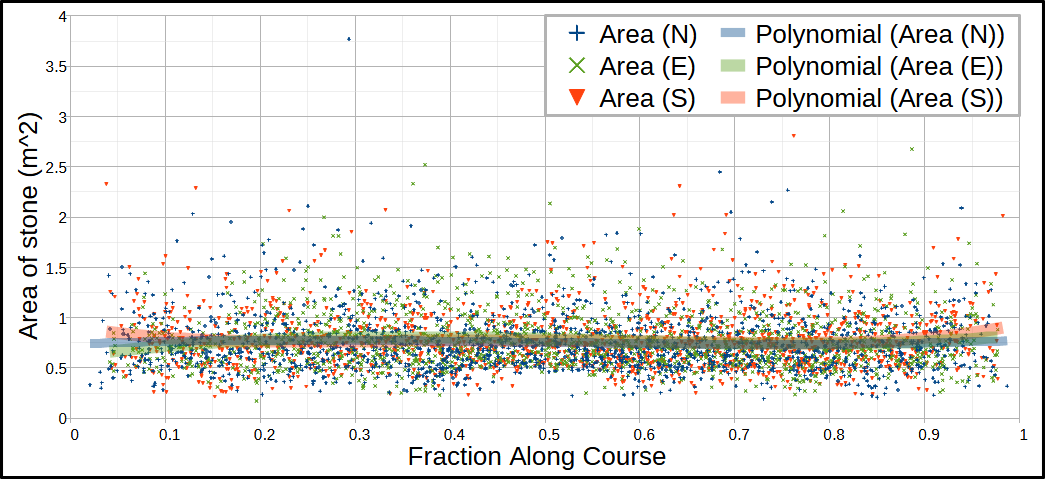
Alignment of central stones
These "central stones" are stones that span the vertical centerline of the pyramid.
| Statistic | Comparison |
|---|---|
| Fraction fill | Similar |
| Edge angles | Much more vertical edge angles than average, (approx. 1° average angle vs 2°) |
| Width | Slightly wider than average |
| Size | Slightly smaller than average |
| Offset from centreline | Approximately 5cm right of centre on average |
Acknowledgments
A big thank you needs to go out to the History for Granite YouTube channel for producing the line drawings from photographs by hand. I used his drawings as a base for the input data for my analysis.
Thank you to those who have offered suggestions or comments.
I used Desmos to produce the images of triangles in the image scaling section.
The photos in the image at the top of the page were taken by Aidan McRae Thomson and Sébastien Léger.
